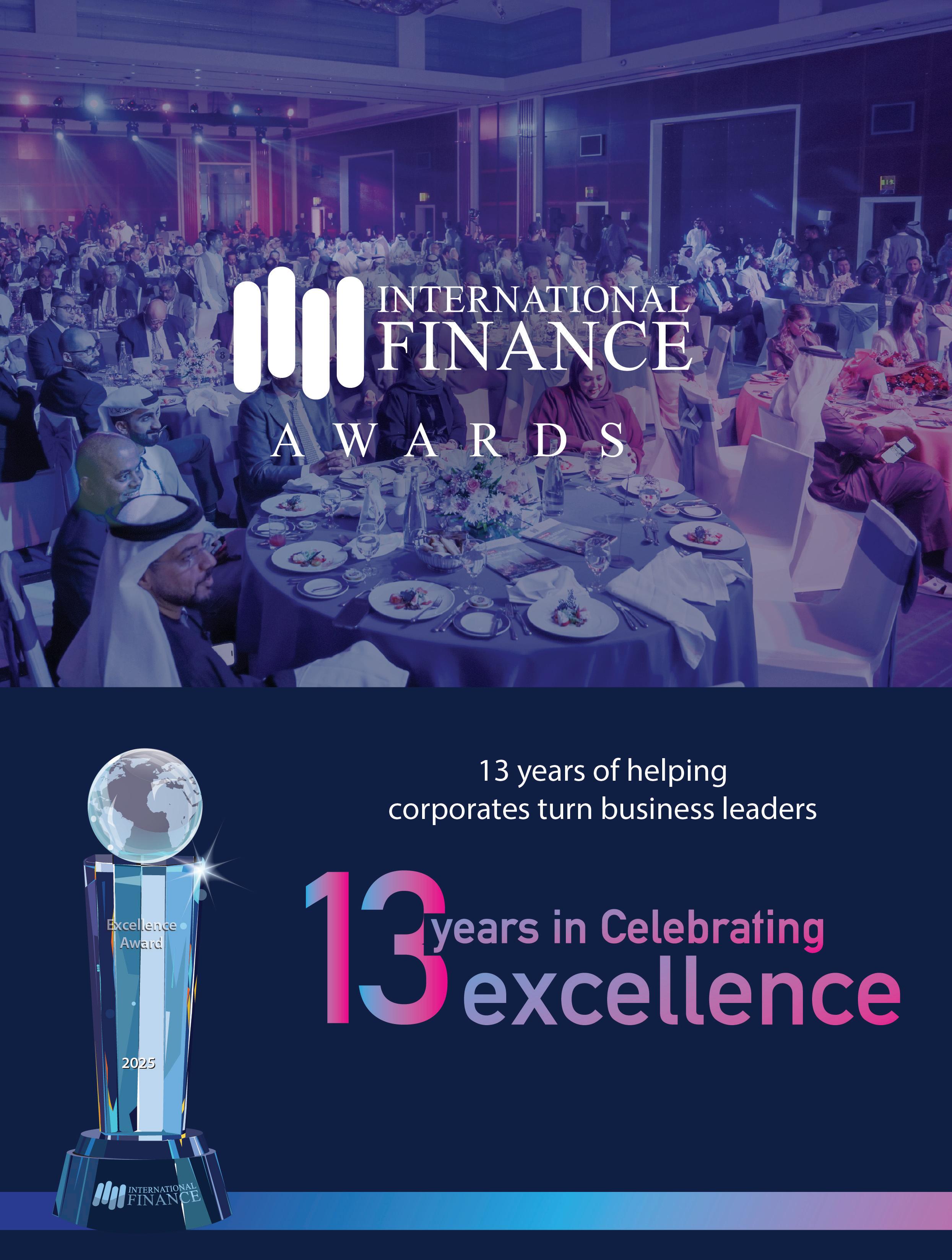Nvidia’s vision Chips for a robotic world
What is Nvidia’s game plan for robotics?
In short, to offer a full technology stack akin to its automotive approach

Will ChatGPT be the new private banker?


What is Nvidia’s game plan for robotics?
In short, to offer a full technology stack akin to its automotive approach

Will ChatGPT be the new private banker?

The date July 25th, 2000, marked a dark day for aviation. Air France Flight 4590, operated by the iconic Concorde supersonic jet, crashed shortly after takeoff, killing all 109 people on board and four on the ground. Eventually, the remaining Concorde fleet, operated by Air France and British Airways, was retired in 2003. More than twenty years later, companies like Boom Supersonic, Spike Aerospace, Exosonic, and Hermeus, along with NASA, are working toward making a new standard in long-distance air travel, often referred to as Concorde 2.0.
In the telecom sector, agentic artificial intelligence is rapidly emerging as the next breakthrough, thanks to its ability to perform autonomous, multi-step reasoning. Unlike traditional prediction models that offer results based on learnt patterns, agentic AI takes initiative and acts independently. We will take a closer look at this transformative technology and its potential impact.
Turning our attention to Bulgaria, despite being the smallest economy in the European Union and grappling with disruptions like COVID-19, inflation, and the war in Ukraine, the country achieved a 3.9% GDP growth in 2022. It continues to rank among the fastest-growing economies in southeastern Europe. The factors behind this growth reveal important insights into Bulgaria’s economic resilience and potential.
Our cover story for the June 2025 edition of International Finance centres on Nvidia’s transformation from the world’s leading AI computing company into a deep tech powerhouse. The company has identified robotics and autonomous vehicles as its next major growth drivers. The focus will be on how Nvidia is leveraging its AI expertise to drive industrial innovation and the implications of this shift for its future and the wider tech industry.
JUNE 2025
VOLUME 25 ISSUE 49
editor@ifinancemag.com www.internationalfinance.com

What is Nvidia’s game plan for robotics? In short, to offer a full technology stack akin to its automotive approach
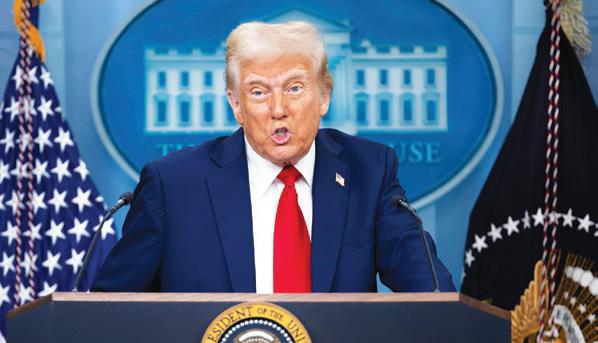
SIGNALGATE CONTROVERSY ROCKS TRUMP CABINET
SignalGate serves as a powerful reminder that security is only as strong as its weakest link, and that link is often human judgment

THE RISE & FALL OF GIBRAN HUZAIFAH'S EFISHERY
With Gibran Huzaifah's rags-to-riches story and increasing financials, eFishery was a rising star

SAUDI AVIATION SOARS WITH VISION 2030 GROWTH
At the heart of Vision 2030 is a redefinition of aviation, not just as a transport utility, but as a catalyst for national transformation

BULGARIA: A RISING PLAYER IN EUROPE’S ECONOMY
Bulgaria has made progress in increasing labour force participation, particularly among women and older workers
68
'DEEP TECH’S GROWTH IS A GENERATIONAL OPPORTUNITY'
It doesn’t matter who’s in office five or ten years from now, because we’ll still need more energy, resilient infrastructure, and secure systems

HOSPITAL PARKING: MORE COSTLY THAN CARE?

BUSINESS DOSSIER
Hospitals charge high prices for parking to raise revenue for health care 38 INSIGHT
44 SOCAR Türkiye optimises group benefits through trade: Fuad Ibrahimov
56 Environmental Horizons: Transforming Saudi waste management
66 iWind: The premier boutique wind farm developer
72 Easy Parking powers smart mobility in Saudi Arabia
94 Emirates NBD Egypt: Innovating with client-centric solutions
106 iscore empowers data-driven financial strategies IN CONVERSATION


The $200 billion potential of agentic AI in telecoms
Will ChatGPT be the new private banker? 108 US-China trade war: Rare earths take centre stage
ZAMAN
EUROPE’S CAPITAL CRUNCH: WHY SOVEREIGN LIQUIDITY NEEDS FIXING Europe’s carbon market is advanced, but the financial instruments based on it often lag behind


Director & Publisher Sunil Bhat
Editorial
Prajwal Wele, Agnivesh Harshan, CL Ramakrishnan, Prabuddha Ghosh
Production Merlin Cruz
Technical Team Prashanth V Acharya, Bharath Kumar
Business Analysts
Alice Parker, Indra Kala, Stallone Edward, Jessica Smith, Harry Wilson, Susan Lee, Mark Pinto, Richard Samuel, Merl John
Business Development Managers
Christy John, Alex Carter, Gwen Morgan, Janet George
Business Development Directors
Sid Jain, Sarah Jones, Sid Nathan
Head of Operations Ryan Cooper
Accounts Angela Mathews
Registered Office INTERNATIONAL FINANCE is the trading name of INTERNATIONAL FINANCE Publications Ltd 843 Finchley Road, London, NW11 8NA
Phone
+44 (0) 208 123 9436
Fax +44 (0) 208 181 6550
Email info@ifinancemag.com
Press Contact editor@ifinancemag.com
Associate Office
Zredhi Solutions Pvt. Ltd. 5th Floor, Sai Complex, #114/1, M G Road, Bengaluru 560001
Ph: +91-80-409901144
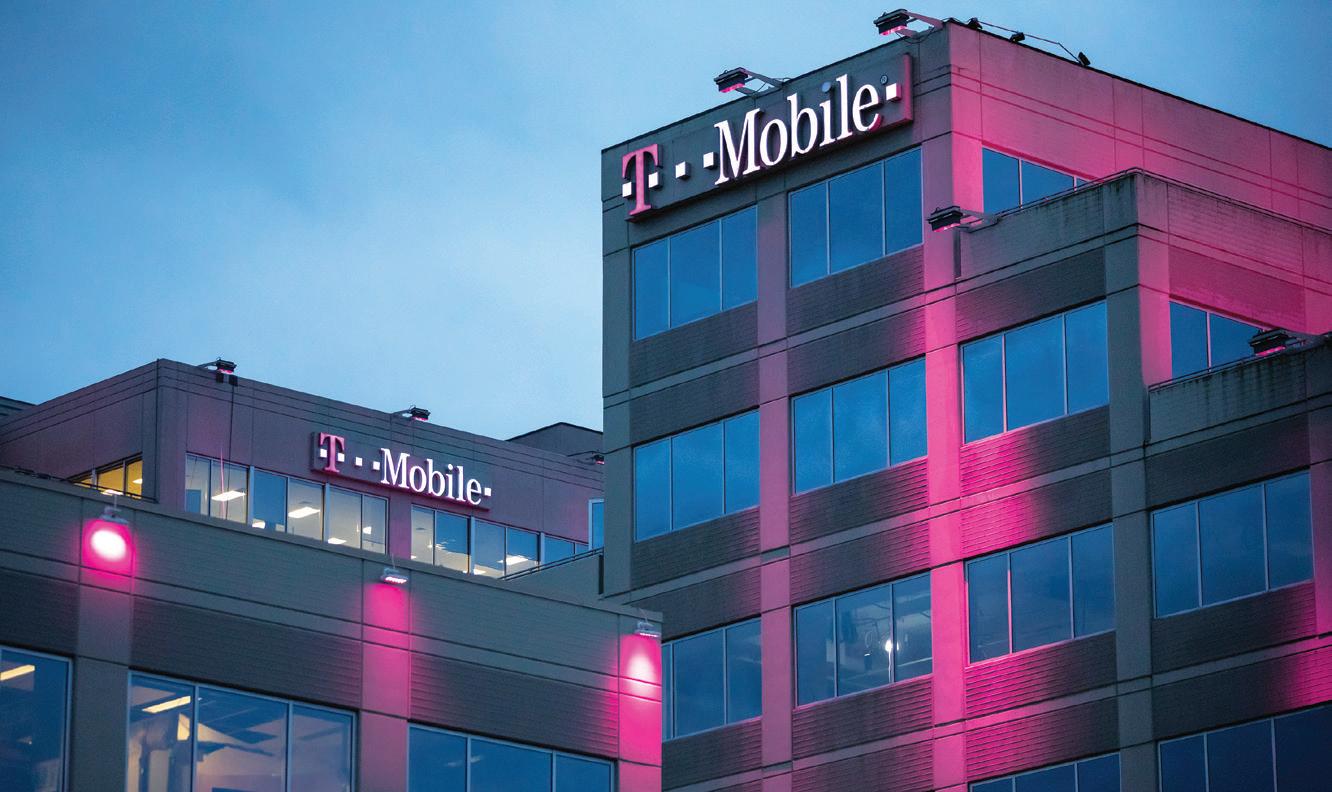
T-Mobile's head of marketing, strategy, and products announced during a live event in Bellevue that the company will launch a data service on its Starlink-powered satellite-to-cell network at the beginning of October. According to Mike Katz, since the service's beta programme began at the end of 2024, more than 11.8 million users have signed up, including "hundreds of thousands of customers from AT&T and Verizon." It will further feature short audio clips, picture messaging, MMS, and SMS texting. A data service will be launched on October 1. The service will eliminate mobile dead zones and extend connectivity to more than 500,000 square miles in the United States that traditional cell towers can't reach.

In an unexpected turn of events, it has been reported that Apple is working on creating a more reasonably priced MacBook laptop that will allegedly use its iPhone chip. According to Apple analyst Ming-Chi Kuo, the A18 Pro chipset, which is used in the iPhone 16 Pro series, will be featured in this new device. The device is expected to have a 13inch display, and Kuo says it may enter mass production in late Q4 2025 or early Q1 2026.
Cryptocurrency exchange Kraken has released Krak, a peer-to-peer payments app. In addition to supporting peer-to-peer payments in 110 countries, the app lets users manage over 300 digital and fiat assets. Fund transfers are made possible by Kraktags, a customised payment ID that eliminates the need for bank account information or cryptocurrency wallet addresses. With no minimum contributions, lockup periods, or subscription requirements, it offers spend and earn accounts and facilitates transactions in fiat currencies, cryptocurrencies, and stablecoins.
Mahmoud Esmat, Egypt's Minister of Electricity and Renewable Energy, participated in the Shanghai Conference on Renewable Energies, Clean Energy Solutions, and the Energy Transition in China, where he held high-level discussions with top Chinese companies specialising in electrical equipment and technology. The discussions focused on enhancing collaboration in digital transformation, modernising power grids and control centres, growing battery energy storage systems, and bringing advanced manufacturing technologies to the region to support Egypt's strategic transition.

Fitch Ratings has made broad upward revisions to its global growth forecasts due to the recent de-escalation of the trade tensions between the United States and China. However, according to the rating agency, the world economy is still experiencing a significant slowdown brought on by the most intense trade
war since the 1930s. Fitch has revised its 2025 global GDP growth forecast by 0.3 percentage points since the April GEO to 2.2%. These rates are significantly lower than the longerterm average of 2.7% and the 2.9% recorded in 2024. Fitch also noted that tariffs dampen the US' economic confidence.



AMINA AL RUSTAMANI
CEO OF TECOM GROUP TECOM Group announced a 21% year-over-year increase in revenues to AED680 million for the first quarter of 2025, while net profit grew by 23% yearover-year to reach AED361 million

ANDREA ORCEL
CEO OF UNICREDIT
Andrea Orcel has indicated the Italian bank will probably abandon its €14.2 billion takeover bid for smaller rival Banco BPM, citing ongoing political pressure, regulatory obstacles, and government opposition

SERGIO ERMOTTI
CEO OF UBS GROUP UBS Group AG awarded Sergio Ermotti just under 15 million Swiss francs for 2024, keeping his compensation below the maximum possible at a time of heightened scrutiny in Switzerland over bankers’ pay
The Saudi men's unemployment rate continued to decline, dropping 0.2 percentage points year over year to 4% as of right now
In December 2024, Equinor and Shell announced that they would merge their offshore oil and gas businesses in the UK to create a new business

The most recent statistics from the General Authority for Statistics show that the unemployment rate among Saudi citizens fell to 6.3% in the first quarter of 2025, the lowest since the Kingdom started disclosing labour force statistics.
At a record-low 10%, the female unemployment rate dropped 3 to 6 percentage points from the previous year. Meanwhile, Saudi women's labour force participation rate increased by 0.3 percentage points to 36.3%, and the employment-to-population ratio increased by 0.7 percentage points to 32.5%.
Meanwhile, the Saudi men's unemployment rate continued to decline, dropping 0.2 percentage points year over year to 4% as of right now. Before the end of the decade, the Kingdom had set the lofty Vision 2030 goal of bringing Saudi unemployment down to 7%, which it has already surpassed.
The International Monetary Fund (IMF) recently praised Saudi Arabia's continuous labour market reforms, pointing out that the country's unemployment rate had already fallen to 7% in 2024, much lower than Vision
2030 targets. The unemployment rate for the entire labour market, which includes Saudis and non-Saudis, decreased to 2.8% in the first quarter of 2025 from 3.5% in the same quarter the previous year.
Recently, Mohammed Al-Jadaan, the Saudi Finance Minister, stated that the Kingdom has made remarkable progress in the last seven years in tackling challenging structural changes.
He further claimed that while private investment as a share of GDP could take decades, Saudi Arabia was able to boast of private sector growth of 16 to 23%.
“Saudi Arabia currently has the lowest unemployment rate in the country’s history with about 3.5%, and among the nationals, the Kingdom achieved its target for Vision 2030 with the rate being 7%," he said.
Al-Jadaan added that there have been significant structural shifts in the direction of women's empowerment.
“Bringing half of your society to the productive part of the economy is significant and that drives a serious change," he said.


The new name will be "Adura," which combines the initial letter of Aberdeen with the first part of the word "durability." Given that both players have a lengthy history in the North Sea, they claim that the name is based on their backgrounds while concentrating on influencing the basin's future in the years to come.
Equinor UK Upstream Senior Vice President Camilla Salthe, said, "We are extremely happy to have accomplished this significant milestone in the establishment of the new company with Shell. In our opinion, the name Adura embodies the essence of this business, referring to its people, position within the Aberdeen-based energy community, longevity, and dedication to the North Sea."
Equinor and Shell announced in December 2024 that they would merge their offshore oil and gas businesses in the United Kingdom to create a new business. The launch is expected by the end of 2025, as the two companies are currently working to obtain regulatory approvals. Once the deal is
finalised, both businesses will own Adura in a 50:50 partnership.
Adura has revealed that it will continue to produce oil and gas domestically and ensure the security of its energy supply in the United Kingdom and beyond. As the energy capital of the United Kingdom, the city is central to Adura's operations and brand. Additionally, it represents the JV's dedication to North Sea energy growth.
“Adura takes an exciting step forward today as we unveil its new name, rooted in a proud history in the North Sea and looking forward with confidence to delivering secure energy for the UK for many years to come. When Adura launches later this year it will become the UK’s largest independent producer. Through combining assets and expertise, we will create a robust portfolio, with a shared purpose, to unlock long-term value," Simon Roddy, Senior Vice President at Shell UK Upstream noted.
The new company will include Equinor’s equity interests in Mariner, Rosebank, and Buzzard.
In contrast to April 2025, the index of properties has increased by 51%
Meta has recently pushed for the hiring of additional OpenAI researchers

Qatar real estate deals surge 37%
The strong and resilient economy of Qatar has been expanding gradually, opening up opportunities in the real estate market as well. A booming economy and government-backed regulations are now supporting the country's changing property market, attracting long-term investors. With 565 real estate transactions, the index reached a total value of QR2.518 billion in May 2025. In contrast to April 2025, the index of properties has increased by 51%, and the real estate trading index has seen a 37% increase in value. Meanwhile, the Ministry of Justice's Real Estate Registration Department reports that the index of traded areas saw a 69% increase. The most active transactions in May 2025 in terms of financial value were in Doha Municipality.
The second-largest investor in JetBlue Airways, Vladimir Galkin, has threatened to sell his nearly 10% share in the faltering airline if its cost-cutting strategy and other more general initiatives do not improve its performance. A major beneficiary of Gamestop's 2021 "meme stock" rally, Galkin, a Miami, Florida resident, invested more than $200 million in JetBlue between February and August 2024. Due to declining travel demand, the New York airline withdrew its full-year forecast in April, stating that it is unlikely to break even in 2025. Galkin said he was underwater to some extent and would have to hold on for the time being. While he didn’t want to say it would be for as long as it takes, he acknowledged it might be for another year.
Source: Statista



According to reports, Meta Platforms is hiring four more OpenAI artificial intelligence researchers. The researchers, named Shengjia Zhao, Jiahui Yu, Shuchao Bi, and Hongyu Ren, have all consented to join. Meta's aggressive recruitment drive signals its strong commitment to advancing AI. The Wall Street Journal claims that the Instagram parent company hired Xiaohua Zhai, Alexander Kolesnikov, and Lucas Beyer. They were all employed at OpenAI's Zurich office. To support CEO Mark Zuckerberg's superintelligence initiatives, the company has recently pushed for the hiring of additional OpenAI researchers, aiming to expand its AI capabilities significantly and strengthen its position in the competitive AI market.

London-based fintech behemoth Revolut will buy a local lender in Argentina owned by BNP Paribas, marking the digital bank's most recent entry into the Latin American market. The conditions of the agreement to buy Cetelem Argentina from BNP Paribas Personal Finance, which is pending regulatory clearance, were not made public. Colombia, Mexico, and Brazil have already seen revolutionary progress. Revolut further stated that it intends to provide services such as foreign exchange trading, multi-currency accounts, and free bank transfers that are suited to the needs of Argentine customers. Due to decades of economic volatility, people in Argentina are now using the US dollar as a safe haven currency.
Many Bluesky users transitioned from X, a platform where controversial figures were live-tweeting the degradation of American infrastructure
Internet personality Amy Brown changed her display name to 'Elon Musk (real)' and her profile picture changed to a picture of a balding business entrepreneur
Since its launch in early 2023, Bluesky has become a sort of rival for the Elon Musk-led microblogging platform X (previously known as Twitter). The site has added over 15 million users since the November 2024 election (which saw a thumping win of the Republican Donald Trump), pushing it to over 32 million users by March 3. "Positioned itself as a refuge from X, the site formerly known as Twitter. For nearly two decades, Twitter had been considered the internet’s town square, chaotic and often rancorous but informative and diversely discursive. Then, after the tech billionaire turned Trump backer Elon Musk acquired the platform, in October of 2022, it devolved into a circus of right-wing conspiracy theories. Liberals began fleeing, and Bluesky in turn accumulated more than ten million users by the fall of 2024, making it one of the fastestgrowing social networks. But the post-election influx proved to be of a different order, turning Bluesky into what one tech blogger compared to a Macy’s at the start of Black Friday sales," The New Yorker summed up things with these words. The platform has been grappling with a notable challenge: a unique problem with detecting humour, something that has personally affected internet personality Amy Brown.
What are we talking about?
Amy Brown was not yelling. She didn't cry. She wasn't vomiting. However, on Bluesky, she claimed to be doing all three at once. What was the reason? During a February business trip to Ohio, Brown's husband stopped by a Walgreens (American pharmacy store chain). He told her that the prices here were lower than in California, where they live. Because of the price difference, she posted that she was crying, screaming, and throwing up. However, the "joke problem" kicked in, as she was told by several Bluesky users that she was exaggerating and that no one could possibly care that much. While the replies were accurate (as they tried to invoke the basic laws of human body functions), they all missed the point: she was referring to one of the most popular sayings on the internet: one that is so widely used that it has its own Spotify compilation name.
Brown faced a unique challenge with humour detection that anyone familiar with Twitter/X and now navigating the younger, more serious social network Bluesky would recognise. Some users struggle to understand jokes, while others seem to deliberately miss the point in order to make a different statement.
Many Bluesky users transitioned from X, a platform where controversial figures were livetweeting the degradation of US infrastructure. This shift represents a much larger issue. However, for those new to Bluesky, the perceived ignorance or selfseriousness of many users can be quite frustrating.

In 2023, Brown, who had previously worked as Wendy's social media manager, joined Bluesky. After nearly two hours of impersonating Elon Musk on November 4, 2022, her X account was banned. The "incident" occurred soon after X made the paid verification announcement.
Brown changed her display name to "Elon Musk (real)" and her profile picture changed to a picture of a balding business entrepreneur. While she knew her actions on the microblogging website might result in her ban, she accepted the possibility.
Now she believes that there is still a lot of "popular sayings on the internet" kind of humour on Bluesky, but surprisingly many people are perplexed by it. There are factors behind it. Let’s start with the conflict between former Facebook and X users.
Brooklyn-based freelance writer Ashwin Rodrigues said, "Anyone who has spent time on the Everything App is familiar with Twitter's idiom, which consists of ironic posts, in-group allusions, and platform-specific history. All of that inside jokes and sarcasm were with them when they left
X. Former heavy users of Facebook, Instagram, and Threads, on the other hand, are used to their own standards of humour. Facebook, at least before it turned into Click FarmVille for engagement bait and ads for strangely specific custom novelty tees, was the opposite of Twitter, which felt like a purposeful way to interact with mostly strangers and that a familiar face might make the user feel horrified. Broadcast media also helped Bluesky gain a lot of users."
"MSNBC featured several segments about the social network, including appearances on Morning Joe, The Weekend, All In With Chris Hayes, and The Rachel Maddow Show. Regular MSNBC viewers who made the leap may not be as accustomed to the tone and manner of online discourse on the shrewd social web," he remarked.
Then comes the tendency of the technology to display random posts to random users through algorithmically curated content, similar to Bluesky's Discover feed, which, in Ashwin's opinion, is worsening the platform's ability to detect humour.

"When an ex-Twitter user describes in detail what they would do to the Hamburglar if they saw him in person, a Maddow referral on Bluesky may react with real horror and bewilderment. There is an issue between the keyboard and chair, which is also a PEBKAC issue," he added.
Make humour great again
"A person cannot be made to understand a joke. Anger is the only more pointless reaction. If there is one thing that these diverse groups have in common, it is a distaste for large tech companies run by unpleasant CEOs and a desire to post in the language of their oncefavourite platforms. Each person has a unique form of brain damage. I understand people who find the
joke hard to understand. However, my sympathies are more with those who are attempting to make them," Ashwin observed.
A 2024 story from Axios claimed that America is experiencing a gullibility crisis. Nobody can tell if a screenshot is a joke, a lie, AI, or a manipulated image.
Comedian Josh Gondelman, who previously worked as a writer and producer on Desus and Mero and wrote for "Last Week Tonight with John Oliver," claims that the political environment has made the problem worse.
According to Gondelman's memory, at some point during the previous six months, Bluesky reached a user base that was sufficiently active to be entertaining and helpful.
He laughs and adds, "But that
also means it hit the tipping point where it's populated enough to be annoying."
Ignatz Award-winning cartoonist, author, and illustrator Mattie Lubchansky says she is "mainly a joke-posting kind of person."
Bluesky's humour-detection problem is a component of a larger phenomenon she has noticed, which she refers to as "riff collapse."
The day after the 2025 Oscars, Lubchansky posted, “I haven't seen any of the Oscar movies this year, nor have I seen any movie ever made. I'm afraid that the people trapped inside the screen will be angry at me for not helping them escape; and once they are out, I will be punished. Anyway, here's how the awards validated an opinion I already had.”
The ensuing responses were
sincere disagreements and opinions regarding Oscar-nominated movies. A few people wanted suggestions for movies. It was suggested, without irony, that she read "The Purple Rose of Cairo". It appears that only a small number of people realised she was kidding.
According to Lubchansky, she witnesses this kind of "riff collapse" every day and believes it is caused by the surge of new users from Meta and X.
However, there has long been annoyance with new social media sites. Longtime users will continue to be irritated by newcomers, and networks will hopefully continue to appear.
When people first started using the internet in the early to mid-1990s, it was frequently when they started college. Several new users would sign up for their university's network in September each year and begin exploring the discussion groups and forums.
Technologist and writer Anil Dash said, “The internet old timers would be very frustrated, because the new people didn’t know the social norms. The exact phenomenon that we are currently witnessing. The majority of internet users dreaded September more than any other month. Everyone can now access the internet at any time thanks to AOL. The Telecommunications Act of 1996, which deregulated the telecom sector and connected homes and businesses nationwide to the internet, coincided with AOL's rise to prominence. This period was called the Eternal September, with wave after wave of newbies getting online."
LiveJournal and even Twitter have shown the same pattern.
Source: Semrush
Ashton Kutcher, an investor and actor, challenged CNN in 2009 to see whose account could reach one million Twitter followers first. Kutcher emerged victorious. Due to the stunt, the microblogging platform experienced a surge in users.
As per Lubchansky, people have a chance to consider their response manners at this time.
“Read the whole post before you respond. Take a moment to respond. And if you're going to respond with a joke, and we're not friends already, go look and see if somebody's made it already. Because there's a really good chance they have," Lubchansky said.
Meanwhile, Brown considers the block function on Bluesky to be a favour to its recipient.
“If someone comes into my comments and they just really, really don't understand, usually I just block them so we don't run into
each other again. No hard feelings. I'm not trying to repeat the part of Twitter where the internet makes me mad every day,” she noted.
It’s a different approach than the norm on X, where quote-tweets viciously insulting the original post are part of the platform’s noxious fabric.
Satirical site "The Onion" has the fifth-largest Bluesky account, with over 1.2 million followers. Onion CEO Ben Collins doesn’t mind people replying to jokes in earnest. On the contrary, he says it’s “the funniest part of the internet.”
“It means more people are seeing your jokes. If everyone is immediately breaking out into uproarious applause at your joke, your audience is too small. As someone who regularly used and posted on Twitter for years, I share the frustration when one of my jokey posts is misread or taken as fact. But it also strikes me as unfair to shame someone because they haven’t been slamming their head on the same wall of the internet that I have. Not everyone crawled here from the radioactive sewer of X. As we all get settled along with our new neighbours, it might be helpful to remember that. If not, at least Bluesky has very robust blocking features," Ashwin concluded. Bluesky website visits from July 2024 to December 2024 (In Millions)


Unlike many other government agencies, DOGE does not appear to have planned mass terminations at OSHA
Concerns have been raised by several former US Occupational Safety and Health Administration officials as well as one of the biggest union federations regarding the potential for Elon Musk and the so-called Department of Government Efficiency to obtain confidential information that whistleblowers at the billionaire's companies have shared with OSHA and the Department of Labour.
According to a public database the agency maintains that despite Musk’s status as a “special government employee” under the Trump administration, OSHA has opened more than 50 ongoing occupational health and safety charges against SpaceX, Tesla, and The Boring Company in the last five years. DOGE employees have been employed by the Department of Labour, where OSHA is located, since at least March 18.
The American Federation of Labour and Congress of Industrial Organisations (AFL-CIO), which is suing the Trump administration over DOGE's access to Department of Labour records, expressed their belief that the news reports and OSHA cases in its memo purport to show "gross mistreatment and even abuse of workers" at Musk companies in five different states in an exclusive memo provided to WIRED.
The union federation claims in the memo that "every worker in America should be of concern to Musk's record as a boss" as he tries to use DOGE to exercise "unilateral control" over the federal government.
The Department of Labour, OSHA, SpaceX, Tesla, Musk, and The Boring Company haven't responded publicly about this ongoing issue.
Not only bureaucratic excess, but also a fundamental breakdown of the firewall separating authorities from the companies they oversee drives the key issue in the continuous debate between Elon Musk, DOGE, and OSHA. Under OSHA's purview, the Department of Labour is currently housing DOGE employees, some of whom have been connected both personally and professionally with Musk. That by itself would set off enough sirens. The true anxiety comes from OSHA's current investigations into Musk's businesses: SpaceX, Tesla, and The Boring Company.
This conflict of interest targets the fundamental centre of democratic responsibility. Allowing a billionaire under investigation for multiple worker safety violations to access whistleblower material is not just a procedural breach;
it undermines the principle that no one is above the law.
Former OSHA officials such as Jordan Barab and David Michaels have been clear-cut: internal OSHA records have to stay sealed from individuals under investigation. Anything less than that not only compromises the judicial system but also erodes public confidence.
The structural vulnerability is confirmed by DOGE operative Marko Elez's read-access to several Labour Department databases, even if they are not used. Add to that his installation of Python and code-altering tools, and you are toying with illegal spying or backdoor manipulation rather than looking at naive oversight.
Whistleblowers in crosshairs
This is not theoretical if it sounds so. Not in a vacuum, but in response to hundreds of safety infractions across Musk's operations, some leading to severe injuries, amputations, or even death, are the AFL-CIO and former OSHA officials delivering their concerns.
In 2020, OSHA fined Tesla 46 times, and there were nine violations combined for SpaceX and The Boring Company. These figures are based on accounts from actual people who sacrificed their livelihoods to speak out; they are not hypothetical.
Consider the instance of Victor Joe Gomez Sr, a certified electrician who was electrocuted to death at Tesla's Gigafactory in Austin from incorrect electrical disconnection, a hazard OSHA had already noted as violating. Another case involved a SpaceX worker who sustained a skull fracture following an automated machinery malfunction and went into a coma.

Under such circumstances, the mere idea that Musk or his associates could follow back whistleblower identities is not only ethically repugnant; it is lifethreatening. David Michaels claims that although theoretically unlawful, enforcement is weak and usually slow when reprisal against whistleblowers is taken. Once a worker's identity is revealed, career-wise, emotionally, and perhaps physically, damage already exists.
Emphasising this threat in no less terms, Liz Shuler, President of the AFL-CIO, referred to the circumstances as an "abomination."
Shuler has good reason for concern. Whistleblowers provide the last line of protection for worker safety in a system that already favours companies greatly. Inviting a systematic breakdown is the way one compromises that line.

The Department of Government Efficiency has not openly acknowledged any active meddling in OSHA's internal affairs. But its subdued impact is being felt in institutional silence, inexplicable inaction, and office closings. Without explanation on whether they are being combined, shrunk, or closed completely, DOGE claims to have lately revoked 17 local OSHA leases.
Meanwhile, OSHA's National Advisory Committee on Occupational Safety and Health has not convened once this year despite scheduling two crucial meetings to address problems including heat-related occupational injuries. These silences follow no random pattern. They are strategically important. Rebecca Reindel of the AFL-CIO claims that the Trump administration's handling of OSHA, especially through
DOGE, appears to be crippling the same mechanism supposed to safeguard workers. It is quite alarming to consider how slowing, disabling, or redirecting safety monitoring could turn bureaucracy into a weapon.
Regulatory sabotage does not necessarily show up as public firings or extensive deregulation. Sometimes it's more subtle: closing regional offices, calling off committee meetings, or arming operators with unclear tasks and access to private networks. These sluggish poisons piecemeal destroy institutional integrity.
We enter a serious legal grey area when DOGE operator Marko Elez installs tools to change software code but claims to have never accessed important systems. The chain of command is not clear, and monitoring appears to be absent. Such uncertainty generates not
only corruption but also impunity.
Given the stakes, the AFL-CIO's lawsuit against the Trump administration is simply a starting point. Congressional supervision and court investigation of the reach and authority of DOGE and any related administrative agencies is absolutely needed. The curtain has to be removed on who has access to what data, how decisions are taken, and whether actual firewalls exist to guard public interest cases and whistleblowers.
This event also calls for a more general discussion on how regulatory authorities might keep their independence in the face of billionaire influence. Elon Musk is a cultural force, a policy influencer, and now, via DOGE, a quasi-government actor; he is not only a corporate billionaire. Anyone who supports democratic checks and balances should find that degree of access and leverage horrifying.
From the Boeing 737 MAX disasters, where engineers raised red flags that were disregarded, to the 2008 financial crisis, driven by lax oversight and insider immunity, history is full of cases when corporate overreach resulted in calamity. If anything, Musk's hostile treatment of whistleblowers, threatening litigation and vowing prosecution, is a red flag that cannot be overlooked. We have seen how rapidly openness falls when the norm is reprisals.
The position of the AFL-CIO goes beyond mere union grievances. On the moral sand, it is a line. Should Musk or DOGE be let to run wild, we could find ourselves in a world where millionaires rewrite the rules in real time, whistleblowing is suicidal, and
regulation is optional.
Protecting workers' rights and safety is not a luxury; rather, it is the absolute least a society has to maintain to be civilised. As of right now, there is no proof available to the public that DOGE or Musk have obtained private OSHA documents.
However, the AFL-CIO and former OSHA managers are concerned about DOGE's attempts to obtain access to other potentially sensitive databases at the Department of Labour and many other federal agencies.
Former OSHA deputy assistant secretary Jordan Barab, who served under President Barack Obama, said, "No company that is being cited by OSHA or investigated by OSHA should be granted access to the agency's internal and confidential files."
DOGE operative Marko Elez currently has read access to four record systems at the Department of Labour, including a database for tracking unemployment benefit claims and another for managing employee access to federal buildings and systems, according to a March 29 court filing by attorneys for the Trump administration in the AFL-CIO lawsuit. Elez "has not accessed any of the systems," according to the petition, but he has installed Python and a program for altering software code at the agency.
According to the public database, OSHA has one ongoing investigation against Tesla, which means the agency has not yet issued a citation or dismissed the case. An unidentified "safety" complaint regarding a Tesla factory in Lathrop, California, prompted the opening of the case recently.
OSHA has issued 46 penalties against Tesla since April 2020 for a range of reasons, including allegedly failing workplace inspections, breaching
OSHA safety laws, or causing an injury to a worker at the business. Over half of these violations are now being contested by Tesla. In the same time frame, OSHA conducted six investigations that led to violations against SpaceX and three against Musk's tunnel construction company, the Boring Company.
According to the document, the AFL-CIO's worry is based on almost two dozen mishaps and claimed safety issues that have been recorded at Tesla, SpaceX, and The Boring Company since 2016. Some of these incidents were the focus of recent OSHA investigations.
A qualified electrician called Victor Joe Gomez Sr was electrocuted and murdered in one instance that was reported to OSHA in 2024 after he was told to check electrical panels at Tesla's Gigafactory in Austin, Texas, which OSHA found had not been correctly disconnected previously. Also, Tesla is actively contesting the case, so it is still open.
Fingertip amputations were the subject of two different OSHA citations at other Tesla operations. According to the final OSHA accident report, an employee at a SpaceX plant in 2022 "suffered a skull fracture and head trauma and was hospitalised in a coma for months" following what the agency described as a technical issue with a recently automated piece of machinery. SpaceX did not dispute the $18,475 fee and OSHA citation.
AFL-CIO President Liz Shuler stated that several Tesla employees have told the federation on multiple occasions that the automaker doesn't put safety first. The AFL-CIO does not represent workers at SpaceX or Tesla, but it does collaborate with the United Automobile, Aerospace & Agricultural Implement Workers of America (UAW).
Debbie Berkowitz, a former chief of

staff and senior adviser at OSHA under Obama, accuses Tesla of having "some serious safety hazards in their facilities."
According to OSHA's public database, businesses have the authority to contest a citation after it is issued, and Tesla frequently does so. As per the email, OSHA has issued violations in 46 Tesla cases over the last five years, but 27 of those cases are still pending because the automaker is aggressively contesting them with the agency.
For the same reason, one Boring Company case and two SpaceX cases are still pending. Until OSHA and the employers agree on the terms of the citation, which may include related fines and certain adjustments the company must make to improve worker safety, the cases cannot be closed.
Obama's assistant secretary of labour for OSHA, David Michaels, told WIRED that large corporations generally don't have a financial incentive to contest OSHA penalties because the penalties associated with them are normally only a few thousand dollars.
However, until a lawsuit is closed, a corporation is not obligated to address

the precise hazard that caused an accident.
"In general, some companies may be motivated to keep cases open in order to avoid addressing these alleged problems," Michaels said.
According to Michaels, "Some employers decide they don't want to abate the hazard, they disagree with the citation, and they will argue the case for many, many thousands of dollars, and it will cost them far more than simply paying a small fine and abating the hazard."
Right now, there is no proof that Musk has access to any private databases at the Department of Labour that would hold whistleblowers' personal data. However, past administrators of OSHA claim that the agency does have records that would make whistleblowers and workers who took part in anonymous interviews with agency investigators anonymous.
According to Berkowitz, she is concerned that an individual with this kind of access could be able to identify each whistleblower who has assisted with an OSHA investigation against one of his businesses.
As stated by Michaels, there is "a very significant concern" that whistleblowers who have their identities made public will face intimidation or retaliation.
Whistleblowers expose their firms to considerable personal danger, and Shuler says that she is deeply worried that their safety and identity may be compromised.
"Regarding the checks and balances we've incorporated into these systems," Shuler claims, "It's an abomination to me. Being aware that our government enjoys trust and that we have successfully persuaded employees that their government will protect them, and now we have an unelected billionaire essentially upsetting that feeling of security."
In recent years, Elon Musk has at least twice talked of taking revenge on those who have leaked secrets. After the material was leaked to the media in March 2025, Musk declared that he would "look forward to the prosecutions" of Pentagon employees. Musk threatened to bring legal action against staff members at X who broke their non-disclosure agreements.
OSHA
It's still uncertain what OSHA's overall future under the Trump administration would hold. According to Rebecca Reindel, the AFL-CIO's director of occupational safety and health and a member of OSHA's National Advisory Committee on Occupational Safety & Health since 2022, the committee should have met twice by now, but none have, she stated. Her committee was drafting regulations to stop occupational heat-related illnesses and injuries.
On a website where the organisation details the amount of money it says it has saved the federal government, DOGE says it has cancelled the leases of 17 OSHA local offices in recent weeks. OSHA and DOGE have not stated if these offices will merge with other regional offices, reduce, or completely close.
Unlike many other government agencies, DOGE does not currently appear to have planned mass terminations at OSHA.
"Massive cuts have not yet been observed. We anticipate their arrival," Reindel concluded.


Nvidia has long been known as the world’s leading AI computing company, powering everything from video games to cutting-edge research. Now, under CEO Jensen Huang’s vision, the company is aggressively expanding into physical applications of AI, namely selfdriving cars and advanced robotics, in a bid to transform itself into a dominant deep tech superpower.
Huang believes that beyond artificial intelligence itself, robotics will be Nvidia’s biggest growth market, with autonomous vehicles as the first major commercial application.

What is Nvidia’s game plan for robotics? In short, to offer a full technology stack akin to its automotive approach
International Finance will examine how Nvidia is leveraging its AI prowess to drive breakthroughs in autonomous driving and robotics, and what it means for the company’s future and the tech industry at large.
Nvidia has a very underdog story. It was established in 1993 and was almost set to be named GeForce. The name Nvidia comes from the Latin word 'invidia', which means envy (or green with envy). In early 2006, they put everything they had into CUDA (Compute Unified Device Architecture), which began paving the way for AI's rise. It’s important to note that there would be no ChatGPT without Nvidia.
The company was a household name in the early 2000s, being the top supplier of graphics cards that were necessary to play high-quality video games. Their top competition back then was AMD, which in the 90s had considered acquiring Nvidia. Today, Nvidia dwarfs AMD, as they are single-handedly pioneering AI, robotics, self-driving cars, chip production, and even building supercomputers. The
company is considered a major source of inspiration for Silicon Valley enthusiasts. Notably, Nvidia CEO Jensen Huang was once rejected by Apple, yet he went on to become a titan in the industry and has been referred to as the "Steve Jobs of AI Hardware."
However, the visionary cofounder of Nvidia knows the semiconductor industry can be cyclical, with data centre investment coming in “booms and busts.” To secure Nvidia’s place in the tech stratosphere long term, Huang has been scouting the next big market beyond conventional “Big Tech” pursuits. At Computex 2024, he declared that two “high-volume” products will dominate robotics in the future: selfdriving cars first, and eventually humanoid robots. These technologies are converging thanks to advances in machine learning, and both require human-like perception, split-second decisionmaking, and immense computing power, precisely what Nvidia specialises in.
In Huang’s words, “Every single car company will have to be autonomous, or you’re not going to be a car company,” a bold prediction underscoring his belief that autonomy is the future of transportation.

Accelerating the self-driving car revolution
Nvidia has methodically embedded itself at every level of the self-driving technology stack. Huang often describes a three-part approach: one computer to train AI models, another to run simulations, and a third inside the vehicle for real-time driving. By providing the chips and software for all three stages, Nvidia aims to be the go-to enabler of autonomous vehicles rather than a consumer-facing automaker.
“Nvidia has strategically embedded itself in all three key steps that could make every car a selfdriving car,” notes Business Insider.
While companies like Waymo and Tesla build robotaxis and personal electric vehicles, Nvidia positions itself as the behind-the-scenes supplier powering those efforts.
Nvidia Drive, the company’s end-to-end autonomous driving platform, exemplifies this strategy. It includes powerful automotive systemon-chips (SoCs), like the current Drive Orin and next-generation Drive Thor, paired with the Drive OS software and toolkits for perception and mapping. At CES 2025, Toyota (the world’s largest
automaker) announced it will integrate Nvidia’s Drive AGX Orin “supercomputer” and Drive OS into its upcoming vehicles to enable advanced driver-assistance and automated driving features.
This was a major win for Nvidia, as Toyota has been collaborating with the company since 2017 on AI for self-driving and even uses Nvidia’s cloud GPUs to train its models. The Toyota deal underscores Nvidia’s “cloud-to-car” strategy: first supplying chips for AI training in the data centre, and now supplying chips and software for intelligence inside the car.
Other automakers are also lining up. MercedesBenz, China’s BYD, Volvo, Hyundai, Lucid Motors, and many electric vehicle startups have adopted Nvidia’s Orin-based platforms for their next-gen cars. In early 2025, General Motors struck a broad partnership with Nvidia to use its GPUs and AI software across passenger vehicles, robotaxis, and even factory automation.
GM will equip future cars with Nvidia’s “AI brain,” including Drive SoCs running the safetycertified Drive OS (based on Nvidia’s latest Blackwell GPU architecture), to enable hands-free driving and autonomy. Notably, GM is also leveraging Nvidia’s Omniverse 3D simulation platform to create virtual assembly lines and train its industrial robots, aiming to boost manufacturing efficiency with AI. This includes the company’s Drive AGX systemon-a-chip (SoC), similar to Tesla’s Full Self-Driving chip or Intel’s Mobileye EyeQ.
The SoC runs the “safety-certified” Drive OS operating system, built on the Blackwell GPU architecture, and capable of delivering 1,000 trillion operations per second (TOPS) of highperformance compute.
This partnership came on the heels of GM’s decision to wind down its Cruise robotaxi unit after safety incidents, signalling that GM now prefers to pivot toward consumer vehicles with advanced autonomy, and it’s tapping Nvidia to help make that happen.
Winning over these automotive giants could translate into huge business for Nvidia. The company projects its automotive division will reach a $5 billion annual run rate by FY2025, a fivefold increase from 2023. That’s still modest next to Nvidia’s booming data centre revenue, but the growth trajectory is clear. Nvidia’s automotive VP Ali Kani remarked that the car business is “still in its infancy,” contributing
Nvidia share price from January 2025 to March 2025 (In US Dollars)
Start of Jan 2025
$140
Mid-Jan 2025
$145
Late Jan 2025
$130
Early Feb 2025
$120
Mid-Feb 2025
$130
Source: Bloomberg
Late Feb 2025
$135 Early Mar 2025
$121

Nvidia chips to under 1% of cars on the road today, but he calls it a “trillion-dollar opportunity” long term.
Industry analysts have taken note: McKinsey estimates assisted and autonomous driving could be a $400 billion market by 2035. And after a few gloomy years when automakers dialled back selfdriving investments (Ford and VW shuttered Argo AI in 2022, GM pulled back on Cruise in 2024), Jensen Huang’s confident CES showcase was seen as a “shot in the arm” for the sector.
“Nvidia has reversed that and just gave autonomous driving an absolute shot in the arm,” said one automotive consultant, noting that hearing a tech leader evangelise self-driving renewed investors’ interest in the space.
Crucially, Nvidia’s advantage is its full-stack approach. Few companies can provide the trainingside infrastructure (massive AI supercomputers to train driving models) and the in-car chips to execute those models on the road.
Tesla, for instance, trains its Autopilot AI on Nvidia GPUs in the data centre, even though it builds custom chips for its cars.
This “cloud + edge” synergy makes Nvidia a natural partner for any firm aiming to deploy autonomous vehicles at scale. It’s no surprise Huang says Nvidia is “absolutely positioning [itself] as the leader for autonomous technologies, period.”
Indeed, from passenger cars and long-haul
trucks to robotaxis, Nvidia’s silicon and software are increasingly becoming the standard toolkit for autonomy. As Huang put it at CES 2025, self-driving cars are no longer perpetually “coming” — “they’re already here,” citing the commercial progress of Waymo and Tesla as proof.
If self-driving cars are essentially “robots on wheels,” Nvidia’s ambitions don’t stop at transportation. The company is simultaneously assembling an expansive ecosystem for robotics and automation in other domains. Huang believes the world is on the cusp of an era of “physical AI,” intelligent machines performing tasks in the real world, and he wants Nvidia to provide the brains of those robots. At Computex, flanked by virtual humanoid figures, Huang proclaimed, “Robotics is here. Physical AI is here. This is not science fiction.”
So, what is Nvidia’s game plan for robotics? In short, to offer a full technology stack akin to its automotive approach. Simulation is one pillar: the company’s Omniverse platform creates rich virtual worlds where robots can be trained and tested safely. Built atop Omniverse is Isaac, described as a “gym” for robots, which lets developers put virtual robots through their paces to practice tasks or generate synthetic training data.
Then comes the edge hardware: Nvidia’s Jetson line of AI chips (with a forthcoming flagship called Jetson Thor) provides the onboard compute for robots to perceive and act in real time. Finally, tying it together are AI models and software frameworks that give robots their smarts.
In 2023, Nvidia unveiled Project “GR00T,” a “moonshot” effort to develop a foundation AI model for humanoid robots. In 2025, this bore fruit in the form of Isaac GR00T N1, billed as the world’s first open-source generalist model for robot intelligence.
GR00T N1 is essentially a robot “brain” that has been pretrained on vast data, not just text or images, but demonstrations of physical actions. It uses a dual-system architecture inspired by human cognition: a “slow-thinking” module that reasons and plans, and a “fast-thinking” module that executes reflexive actions.
This mimics psychologist Daniel Kahneman’s concept of thinking fast and slow. In practice, GR00T N1 can observe its environment (through sensors and

cameras), interpret instructions, plan a sequence of actions, and then control a robot’s limbs to carry out complex tasks. Nvidia pretrained it on both realworld human motion data and millions of synthetic scenarios generated in simulation.
Importantly, GR00T N1 is customisable. Developers can fine-tune it with additional data so a robot learns specialised skills. Huang declared that “the age of generalist robotics is here” as he opened up GR00T N1 to the world’s robot makers.
Complementing GR00T is another key piece called Nvidia Cosmos. Unveiled at CES 2025, Cosmos is a family of foundational models focused on modelling the physical world.
Whereas language models ingest books and websites, Cosmos was trained on 20 million hours of video of humans and objects in motion. It generates highly realistic images, simulations, and 3D scenarios, for example, showing boxes falling off a shelf in a warehouse, which can be used to teach robots what to expect and how to respond in the real world.
“It’s not about generating creative content, but
teaching the AI to understand the physical world,” Huang explained.
Companies are already using Cosmos: humanoid robot startups like Agility Robotics and Figure, and self-driving car developers like Waabi and Wayve, are leveraging it to accelerate their training and simulation. In essence, Cosmos gives robots common sense about physics and environments, while GR00T gives them the decision-making and motor skills, together aiming to dramatically lower the barrier to robotics development.
Nvidia’s Jensen Huang envisions a future where advanced AI chips and software power fleets of autonomous vehicles and humanoid robots, a vision already taking shape through partnerships with automakers, electronics manufacturers, and even entertainment companies.
Nvidia is backing up these platforms with realworld pilot projects to showcase what’s possible. One headline-grabbing example is its collaboration with Foxconn, the world’s largest electronics manufacturer.
Nvidia’s present profitability still relies on data centre AI chips, but investors are keenly watching these nascent divisions
In 2025, Nvidia and Foxconn announced plans for a “robotic factory” in Houston that will use humanoid robots to assemble Nvidia’s own next-gen AI servers.
This would be the first time Nvidia products are built with the help of humanoid machines, and one of the first such deployments in any electronics factory. Foxconn has been co-developing humanoid robots with Nvidia’s hardware and software, including one bipedal model and one wheeled model, and training them for tasks like picking up components, inserting cables, and performing assembly.
The goal is to have a small number of these robots operational by Q1 2026 when the Houston plant begins production of Nvidia’s “GB300” AI servers. If successful, this could herald a new era of AI-driven manufacturing.
Observers note it as a prestige project for both firms: Nvidia would solidify its position not only as a chip and server leader but as a platform provider for robotics, while Foxconn would demonstrate high-tech manufacturing innovation on American soil.
Nvidia’s robotics push goes beyond factories. The company is moving into service and entertainment robots, even magic-infused Disney creations.
In March 2025, it emerged that Nvidia, Disney Research, and Google DeepMind are teaming up on a project codenamed “Newton” to create a new generation of interactive robotic characters.
Newton is essentially an open-source physics engine that will help Disney’s robots learn complex movements with precision. Disney Imagineering’s vision is to bring more lifelike robots to its theme parks, for example, free-roaming droids like the Star Wars-inspired “BDX” robots that were previewed during Huang’s keynote.
“This collaboration will allow us to create a new generation of robotic characters that are more expressive and engaging than ever before,” said Disney Imagineering’s senior R&D VP.
In fact, Disney’s first batch of AI-powered BDX droids has already been play-tested on a cruise ship and will soon appear in Walt Disney World and other parks.
For Nvidia, this alliance is a testament to the scope of its robotics prowess, reaching into animatronics and arts, away from factory floors. It also highlights a familiar refrain: Nvidia is not making the robots or cars themselves; rather, it provides the enabler technology that allows industry leaders (be they Toyota, Foxconn, or Disney) to fulfil their AI-fueled dreams.

All these moves point to Nvidia’s evolution from a pure “Big Tech” company into something broader, a deep technology platform spanning hardware, software, and services for the AI-driven future.
“We stopped thinking of ourselves as a chip company long ago,” Jensen Huang recently remarked.
He prefers to describe Nvidia as an “AI infrastructure” and “computing platform” provider, one that now delivers cloud services, simulation software, and development toolkits in addition to silicon.
By weaving itself into the fabric of emerging industries like autonomous vehicles, robotics, and even defence (Nvidia is a partner in a European project led by Nokia to use drones and robots for critical infrastructure protection), Nvidia is staking a claim as a leader in “physical AI,” the application of artificial intelligence in the physical world.
Huang predicts that in the not-so-distant future, there will be “billions of robots, hundreds of millions of autonomous vehicles, and hundreds of thousands of robotic factories” all powered by Nvidia technology. It’s an audacious vision, but one the company is investing heavily to realise.
Financially, these sectors are still ramping up. Nvidia only recently began reporting its automotive and robotics revenues together, and they accounted for roughly $567 million last quarter (about 1% of total sales), albeit growing 72% year-on-year. The company’s present profitability still relies on data centre AI chips, but investors are keenly watching these nascent divisions.
For tech-savvy investors, Nvidia’s foray into selfdriving cars and robotics represents the opening of new multi-billion (even trillion) dollar TAMs (Total Addressable Markets) over the coming decade. It pits Nvidia not against the usual FAANG companies, but against (or alongside) players in automotive, manufacturing, healthcare, and aerospace, industries hungry for AI solutions.
The company’s strategy of partnering with incumbents (rather than competing directly) could yield a sprawling customer base without massive capex on its part. As one set of analysts wrote, Nvidia’s strengths in robotics and digital twins could “scale into massive businesses themselves,” potentially driving decades of growth.
Naturally, challenges abound. Robotics, especially humanoid robots, remain harder than web or mobile tech; they involve complex mechanics, safety concerns, and huge data requirements to function reliably in unstructured environments. Sceptics point out that despite Nvidia’s impressive tools, fully autonomous robots are still in the early stages and demand significant R&D.
Even Huang acknowledges that growing the robotics market “isn’t just a matter of time” or inevitability. It will require continued advances in artificial intelligence algorithms, sensors, and perhaps most importantly, cost reduction, to see robots proliferate beyond pilot projects.
Nvidia’s strategy of open-sourcing models like GR00T N1 and collaborating widely is meant to accelerate this progress by seeding an ecosystem (much as OpenAI frameworks spurred the machine learning boom).
Huang believes that by reducing barriers and providing substantial computing power, Nvidia can do for robotics what it accomplished for AI software: make it accessible enough for an explosion of innovation.
Nvidia has gone from selling graphics chips to becoming the linchpin of modern AI, and now it’s charging into autonomous machines on our roads and in our factories. This pivot could fundamentally reshape Nvidia’s identity, no longer simply a supplier to “big tech” companies, but a superpower in deep tech, commanding influence in the next generation of industries built on AI, from smart cars to smart robots.
Huang’s remarks at a recent shareholder meeting put it best: “AI and robotics are the two largest opportunities, representing a multitrillion-dollar growth opportunity.”
If Nvidia succeeds, it won’t just be leading in AI computing; it will be everywhere that advanced computing meets the real world.
In an era when “everything that moves” is poised to become autonomous, Nvidia appears determined to supply the engines of that revolution, thereby laying the basis of its transformation as a force dominating deep tech innovation.
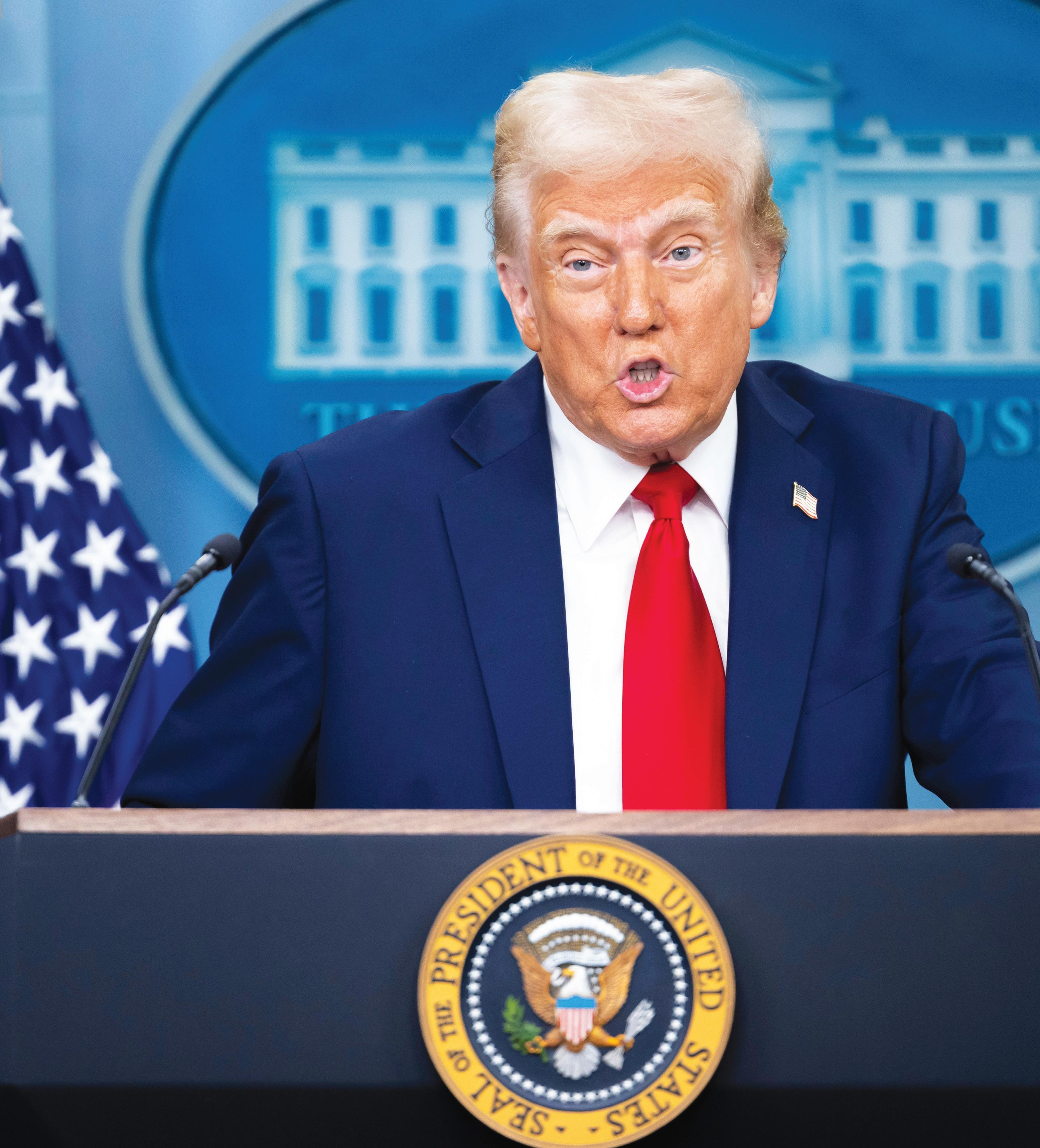

SignalGate serves as a powerful reminder that security is only as strong as its weakest link, and that link is often human judgment
IF CORRESPONDENT
The shocking controversy surrounding the Donald Trump Cabinet's unintentional invitation to The Atlantic's editor-in-chief to join a text-message group covertly organising a bombing in Yemen has been given a new name: SignalGate, a reference to the fact that the exchange occurred on the free, end-to-end encrypted messaging app Signal.
However, security and privacy experts who have marketed Signal as the best-encrypted texting service available to the public want to be clear that SignalGate is not about Signal, as that moniker has come to represent the most public error of the second Trump administration to date.
The response from the Trump Cabinet's detractors and even the administration itself has occasionally appeared to blame Signal for the security breach since Jeffrey Goldberg, editor of The Atlantic, disclosed recently that he was inadvertently added to a Signal group chat earlier in March 2025 that was set up to organise US airstrikes against the Houthi rebels in Yemen.
Some analysts have cited the recent accusations of Russian agents phishing Signal. According to reports, Goldberg was invited to the Signal group chat by national security adviser Michael Waltz, who has even implied that Goldberg might have hacked into it.
Even Trump implied that Signal was somehow to blame for the group chat disaster. At the White House, Trump told reporters, "I don't know that Signal works. To be honest with you, I believe Signal may be flawed."
Kenn White, a security and cryptography researcher and former Director of the Open Crypto Audit Project who has audited popular encryption products, thinks the true lesson is considerably easier: avoid inviting people you don't trust into your Signal group chat.
Instead of using unapproved devices that can run publicly available apps like Signal, government officials who handle extremely sensitive or classified material should use encrypted communication tools that operate on limited, often air-gapped devices meant for a top-secret context.
White states unequivocally that Signal is not to blame for this, as he said, "Signal is a tool for communication intended for private discussions. It's not a technical issue when someone who shouldn't be in the discourse is brought into it. That is a problem with the operator."
Source: Appfigures
For a simpler explanation, consider Johns Hopkins University computer science professor and cryptographer Matt Green’s opinion, "Signal is a tool. Bad things are going to happen if you misuse a tool. It is not the hammer's fault if you strike yourself in the face with it. It is truly up to you to be aware of who you are speaking to."
"The use of Signal implies that the cabinet-level officials involved in the Houthi bombing plans, including Secretary of Defence Pete Hegseth and Director of National Intelligence Tulsi Gabbard, were having the conversation on internet-connected devices, possibly even personal ones, because Signal would not normally be permitted on the official, heavily restricted machines meant for such conversations. This is the only way SignalGate is a Signal-related scandal. That would be absolutely forbidden in past administrations, at least, especially for classified communications,” White noted.
Using Signal on internet-connected business devices does in fact expose communications to anyone who can attack the iOS, Android, Windows, or Mac computers that may be running the Signal desktop or mobile apps, in addition to anyone who can somehow take advantage of a hackable weakness in Signal.
For this reason, US agencies generally, and the Department of
Defence specifically, use government devices that are specially supplied and managed to regulate the features and software that are installed. The fundamental problem was using the wrong tools or software to communicate about extremely high-stakes, covert military operations, regardless of whether the cabinet members had done so via Signal or another consumer platform.
The fact that communication apps like Signal and WhatsApp have "disappearing message" features, the ability to automatically delete messages after a predetermined period, that violate federal record retention laws is one of the most obvious reasons they are unfit for use in classified government work.
According to screenshots of the conversation released by The Atlantic in March, this problem was clearly visible in the principals' conversation over the upcoming war in Yemen. Originally, the timer was set for a oneweek auto-delete, but the Michael Waltz account modified it to four weeks. The contents of the talk might not have been archived in compliance with long-standing government regulations if Goldberg from The Atlantic had not been inadvertently included.
Tulsi Gabbard, the US Director of National Intelligence, testified before Congress that government devices may have Signal preloaded. However, other sources inform WIRED that this is incorrect, noting that it is often challenging and typically prohibited to download consumer apps like Signal onto Defence Department devices.
Defence Secretary Hegseth's participation in the chat suggests that he either circumvented the normal procedure for requesting such a waiver, used a non-DOD device for the discussion, or acquired an exceedingly unusual dispensation to install Signal

on a department device. In February, DOD "political appointees" insisted that Signal be installed on their government computers, according to podcaster and political consultant Fred Wellman.
The assertion that no sensitive material was shared in the Signal communication is at the heart of the Trump administration's explanation of the actions. Gabbard and others have specifically pointed out that Hegseth is the information's classification authority. However, according to several sources, this authority does not
make a consumer application the ideal venue for this kind of conversation.
There was no official label such as 'for official use only' or anything like that in the way this was being conveyed.
Andy Jabbour, a veteran of the US Army and the founder of the domestic security risk-management company Gate 15, said, "But whether it should have been classified or not, whatever it was, it was obviously sensitive operational information that no soldier or officer would be expected to release to the public, but they had added a member of the media into the chat."
According to Jabbour, military personnel receive yearly security and information awareness training to strengthen operational protocols for managing all tiers of non-public information. Even non-classified material can be incredibly sensitive and is usually tightly preserved, as many sources tell, even if the information in the Yemen attack discussion seems to satisfy the classification requirement.
"Aside from the fact that secret information should never be shared over an unclassified system, I find it absolutely astounding that all of
these senior people were on this line and no one even thought to verify security hygiene 101. Who are all the names? Who are they?" Democrat Mark Warner of Virginia, a US senator, stated during a Senate Intelligence Committee hearing in March.
The Atlantic claims that 12 members of the Trump administration, including Vice President JD Vance, Trump adviser Susie Wiles, and Secretary of State Marco Rubio, were on the Signal group chat.
Jabbour goes on to say that even when decision-making authorities are present and taking part in a conversation, a proactive, established method is used to establish an information designation or declassify material.
"You can't just say, 'That's actually not spilt milk, because I intended to spill it,'" he says, referring to spilling milk on the floor.
In summary, SignalGate presents numerous privacy, security, and legal concerns. However, one of them is not Signal's security. Despite this, some have looked for shaky links between Signal vulnerabilities and the Trump Cabinet's security lapse following The Atlantic's story.
A Pentagon expert, for instance, echoed a study released recently by Google's security researchers, who warned Signal earlier this year about a phishing method used by Russian military intelligence to target users of the app in Ukraine.
However, Signal released an upgrade that made it much more difficult to utilise that approach, which deceives users into adding a hacker as a secondary device on their account. The same tactic was also used to target certain accounts on the messaging apps
Telegram and WhatsApp.
"People who use popular websites and applications are subject to phishing attacks. We added further security measures and in-app alerts to help prevent people from becoming victims of phishing attacks after discovering that Signal app users were being singled out—and how. This job was finished several months ago," Signal spokeswoman Jun Harada said.
"In fact, considering Signal app's reputation and track record among security experts, the Trump administration could have done much worse than to use it for those discussions if they were going to jeopardise secret communications by discussing war plans on unapproved commercial devices and publicly accessible messaging apps," according to White, the cryptography researcher.
"For communities that are most vulnerable, such as human rights advocates, lawyers, and journalists' private sources, Signal is the consensus recommendation," White added.
The real trouble with Signal Signal, once considered a privacy and security beacon, is now controversial for all the wrong reasons. Despite charges in the signal app, it remains a discreet communication method.
However, earlier charges have placed doubt on the app's underlying ideals and internal policies.
Whistleblowers and former employees allege a worrisome Signal Foundation reality. Signal has secured communication for journalists, activists, and individuals worldwide, but the new disclosures have shaken user faith and sparked a debate about secret texting.
Reports of Signal Foundation's

internal disagreements and whistleblower accounts revealed the situation. Inners say the organisation's hierarchical structure discourages dissent, mismanages and lacks transparency. A hostile working culture with bullying, harassment, and discrimination has been accused. Critics say Signal's leadership has pushed rapid user development over security and privacy, creating weaknesses.
Integrating MobileCoin, a privacyfocused cryptocurrency, inside the app has proved controversial. Critics say the cryptocurrency adds complexity and security dangers, deviating from Signal's basic objective. Signal's leadership's link with MobileCoin has also generated questions about conflicts of interest. Critics have accused the app of censorship and content manipulation, contradicting its promise of free speech and open communication.
According to privacy and security experts, one of the main charges is the MobileCoin dispute. Signal's core ideals may conflict with the integration's

lack of openness. Organisational whistleblowers have also reported a culture of fear and intimidation. They say security concerns and dissenting voices are ignored. Employees struggle to communicate their concerns due to the lack of a clear grievance procedure.
Addressing app security vulnerabilities is another big issue. Signal app's encryption technology is strong; however, metadata management and third-party service dependence have been criticised. Some have questioned if the foundation's rapid growth has caused security issues.
Signal Foundation governance is also under examination. Accountability difficulties arise from its non-profit status and opaque decision-making. Detractors say a tiny clique holds control, making openness and fair governance difficult.
Despite its end-to-end encryption, Signal's data handling has generated concerns. Critics say the app's privacy policy is unclear, permitting unnecessary data harvesting. These concerns raise concerns that Signal
may not be as privacy-centric as it claims.
These allegations have had major effects. Many Signal users now doubt its privacy pledge. Signal's reputation has suffered from the dispute, making it tougher to maintain its secure communication leadership. Regulators and lawmakers have noticed, scrutinising the app's policies and governance. This may lead to tougher messaging apps and tech company rules.
Alternative messaging apps that prioritise privacy and security have benefited from the SignalGate controversy. Users demanding more openness and responsibility may switch platforms. The scandal has also raised questions about non-profits' role in secure communication technology development. Signal has also lost the trust of activists and journalists, who use its security to remain anonymous. If these people lose trust in Signal, their safety may be in jeopardy.
The scandal highlights the need for increased transparency and res-
ponsibility in secure communication technology development. Messaging apps must be more transparent about their governance, financial, and data management procedures.
To make the whistleblowers feel secure when reporting violations, stronger protections are needed. Independent audits and security assessments should be standard to uncover vulnerabilities and verify best practices.
Messaging apps must also have explicit privacy rules that explain data gathering and use. Open-source development allows public code analysis to find security weaknesses, promoting openness. By spreading control over numerous servers, decentralised systems may reduce censorship and surveillance.
Signal must investigate the charges independently, change governance, increase whistleblower protections, and solve MobileCoin and other security issues. Open and honest communication with users will also help restore platform credibility.
FEATURE SIGNALGATE

The Signal app incident illustrates the difficulties of digital trust. It emphasises awareness and critical thinking while picking communication tools. As technology advances, users must demand transparency, responsibility, and ethics from secure messaging platform developers and maintainers.
Despite organisational issues, Signal remains a top-tier encrypted messaging app, but its security relies heavily on user practices. The platform defends its encryption, stating there are no inherent vulnerabilities, messages remain protected in transit, and only
intended recipients can decrypt them. However, Signal is only as secure as the device itself. If an attacker gains access to an unlocked phone, installs spyware, or tricks a user into linking their account to a malicious device, private messages can be exposed. While Signal's end-to-end encryption is open-source and highly trusted, it does not protect against phishing scams, spyware like Pegasus, or human error.
To enhance security, users should prioritise safe practices: enable "Always Relay Calls" to hide IP addresses, use personal rather than work devices,
avoid untrusted networks, and turn on disappearing messages to minimise exposure.
While Signal provides robust encryption, true security depends on how users handle their devices and conversations.
The SignalGate controversy is seen as more than just a messaging app mishap.
At its core, this scandal represents a fundamental breakdown in operational security protocols at the highest levels of government, revealing lapses in judgment TECHNOLOGY

that extend well beyond technology.
The Donald Trump administration's attempt to shift blame onto Signal itself misses the central point security experts have unanimously emphasised: the app performed exactly as designed. The failure was entirely human.
As cryptography researcher Kenn White and Johns Hopkins professor Matt Green both stressed, Signal is merely a tool, one that was misused by those who should have known better.
The administration's narrative resembles blaming a hammer after hitting your thumb rather than acknowledging poor craftsmanship.
Perhaps more troubling is what the incident reveals about protocol violations within the current administration.
Cabinet-level officials discussing potential military strikes on consumer devices using commercially available apps represents a significant departure from established security practices.
Former administrations maintained strict boundaries between classified communications and consumer technology for precisely these reasons. The disappearing message feature, which would have deleted evidence of these conversations after a predetermined period, raises additional questions about record retention compliance and transparency.
The attempted justification that
"no sensitive material was shared" contradicts the obvious reality that planning military operations is inherently sensitive, regardless of formal classification status. As Army veteran Andy Jabbour noted, this was clearly "sensitive operational information that no soldier or officer would be expected to release to the public." Senator Mark Warner's astonishment that "no one even thought to verify security hygiene 101" underscores the severity of this procedural breakdown.
What makes SignalGate particularly remarkable is that it occurred within a group that included twelve senior administration officials, including the Vice President, Secretary of State, and Director of National Intelligence.
The lack of questioning regarding the venue indicates either a collective ignorance of basic security protocols or a troubling culture of procedural shortcuts at high levels of government.
The irony is that the Signal app itself remains one of the most secure consumer messaging options available, a tool trusted by journalists, human rights advocates, and vulnerable communities worldwide precisely because of its strong encryption and privacy protections. The administration could hardly have chosen a better consumer app for sensitive discussions, yet the fundamental error was using any con-
sumer app for such purposes.
As this controversy continues to develop, the focus should remain on procedural failures and human error rather than technological shortcomings.
SignalGate serves as a powerful reminder that security is only as strong as its weakest link, and that link is often human judgment. In an era of increasing digital threats and surveillance, even the most powerful encryption cannot protect against the simple mistake of adding the wrong person to a conversation.
For an administration facing scrutiny over its handling of sensitive information, SignalGate represents not just an embarrassing mishap, but a troubling glimpse into operational practices that security experts and government veterans alike find deeply concerning. The ultimate lesson may be that in the case of national security, following established protocols is not bureaucratic red tape, it is essential protection against this kind of preventable breach.
It doesn’t matter who’s in office five or ten years from now, because we’ll still need more energy, and resilient infrastructure

CL RAMAKRISHNAN
As the deep tech market surges toward an estimated $714.6 billion by 2031 with a remarkable 48.2% compound annual growth rate, few investors understand this landscape as intimately as Alexandra Vidyuk. The physicist-turned-venture capitalist has positioned herself at the forefront of the most transformative technological wave of our generation, backing breakthrough companies across space technology, robotics, energy systems, and advanced materials.
Through her leadership at Beyond Earth Ventures and strategic partnerships with leading deep tech firms, Vidyuk has demonstrated an exceptional ability to identify and nurture technologies that address both terrestrial challenges and space exploration needs. Her track record includes early investments in companies like Lunar Outpost, Zeno Power, and Tandem PV, which are redefining infrastructure for a more resilient future.
With over 60,000 subscribers following her insights through Space Ambition and recognition as a Karman Pioneer among the top 50 space leaders globally in 2025, Vidyuk represents the new generation of investors who understand that deep tech is not just an investment opportunity—it's an imperative for humanity's future.
In an exclusive interview with International Finance, Alexandra Vidyuk, CEO & General Partner of Beyond Earth Ventures, shares insights on why deep tech is becoming the most resilient and essential investment class in today’s volatile geopolitical climate, highlighting how strategic sectors like space, energy, and next-gen computing are shaping a new era of infrastructure, national security, long-term wealth creation, and beyond.
How do geopolitical tensions and trade wars make deep tech a more attractive investment compared to traditional tech sectors?
Geopolitical tensions and trade wars make deep tech more attractive because
Government policy has become the primary catalyst for deep tech innovation, particularly in strategic sectors

deep tech operates on a fundamentally different level, focusing on infrastructure rather than interface. While traditional tech sectors are more exposed to consumer sentiment, regulatory shifts, and global supply chain fragility, deep tech addresses enduring, non-negotiable needs: energy, defence, space, and compute. These aren’t subject to political cycles; they’re dictated by physics and long-term strategic imperatives.
It doesn’t matter who’s in office five or ten years from now, because we’ll still need more energy, resilient infrastructure, and secure systems. Space isn’t going away. Government and defence budgets are pouring into these sectors, accelerating adoption and funding R&D that startups can commercialise. For example, proposals like Trump’s Golden Dome may sound political, but in practice, they catalyse innovation in dual-use technologies, such as space-based sensing, energy networks, and hardened compute, which have profound civil applications. In this climate, deep tech isn’t just resilient; it’s essential.
With deep tech projected to grow at a CAGR of 48.2% through 2031, what sectors within it do you see as most promising right now?
It’s important to distinguish between early-stage R&D and research-ready sectors, and as investors, that’s exactly our job. We focus on identifying areas where scientific breakthroughs are transitioning into scalable, defensible businesses. Based on our investment thesis at Beyond Earth Ventures, we see generational wealth creation potential today in space, robotics, next-gen computing, and energy.
Given the capital-intensive and long R&D cycles in deep tech, how should investors adjust their expectations around ROI and time horizons?
First of all, there are a lot of misconceptions about deep tech and its timelines compared to typical tech cycles. Many investors got used to the crypto cycle, expecting outsized returns in 18
Deep
tech's resilience stems from addressing fundamental infrastructure needs rather than discretionary consumer spending
to 36 months, but that was an anomaly. Even in traditional tech, the average time from founding to IPO in the US is still around 16 years. Deep tech isn’t unusually long; it's just unusually real.
Yes, deep tech is capital-intensive, but it also builds defensible moats that aren’t vulnerable to the next LLM release. A product like DeepSeek might disrupt half a SaaS portfolio overnight, but it’s not going to wipe out your rockets, fusion reactors, or novel materials platforms. These are long-term bets, but they’re anchored in infrastructure, not user engagement.
Investors should adjust their expectations accordingly—this is about building the backbone of the future, not chasing the next growth hack. The returns are slower to mature, but far more resilient when they do.
How can deep tech investors mitigate risk, especially in early-stage ventures that hinge on scientific breakthroughs?
Risk mitigation in deep tech requires three fundamental strategies. First, scientific due diligence with expert networks is non-negotiable. We maintain relationships with leading researchers and former government scientists who can evaluate the technical feasibility of breakthrough claims.
Second, we focus on companies with dual-use applications and multiple market pathways. This diversification reduces dependence on any single commercial outcome.
Third, we prioritise founders with deep domain expertise and proven track records in translating research into commercial applications. At Beyond Earth Ventures, we systematically evaluate whether teams have the technical depth to navigate inevitable scientific challenges while maintaining a commercial focus. Additionally, we
structure investments to align with government funding cycles and policy initiatives, leveraging public sector support to reduce private risk exposure.
To what extent are governments driving deep tech innovation as a national security priority, and how can startups align with these national agendas?
Government policy has become the primary catalyst for deep tech innovation, particularly in strategic sectors like semiconductors, quantum computing, and space technology. The convergence of the US CHIPS Act, European Chips Act, US Golden Dome and similar initiatives in Asia creates a coordinated global push for technological sovereignty. This represents a fundamental shift from market-driven innovation to policy-driven strategic development.
Startups can capitalise on this trend by aligning their technology roadmaps with national priorities. This means understanding export controls, developing dual-use capabilities, and building relationships with government and research institutions.
Companies that successfully navigate security clearances and regulatory frameworks gain access to massive government contracts and preferential treatment in policy implementation. The key is demonstrating how your technology addresses national security or economic competitiveness challenges.
Why are deep tech startups often more resilient during economic downturns compared to consumer-facing tech companies?
Deep tech's resilience stems from addressing fundamental infrastructure needs rather than discretionary consumer spending. During economic uncertainty, governments and enterprises prioritise investments that enhance productivity, security, and competitiveness, precisely what deep tech delivers. Unlike consumer apps that face immediate budget cuts, deep tech solutions often become more essential during challenging periods.
Additionally, deep tech companies typically maintain longer development cycles and stronger

intellectual property positions, making them less susceptible to rapid market shifts. Government contracts and strategic partnerships provide stable revenue streams independent of consumer sentiment. The recent market data confirms this: deep tech funding remained relatively stable while consumer tech investments plummeted.
How are companies like Lunar Outpost and Xona Space Systems redefining infrastructure for a more resilient and decentralised future? These companies exemplify the space-terrestrial convergence that defines next-generation infrastructure. Lunar Outpost's Mobile Autonomous Prospecting Platform (MAPP) rovers demonstrate how lunar surface operations can inform terrestrial robotics for extreme environments. Their technology applies equally to Mars exploration and deep-sea mining operations on Earth.
Xona Space Systems represents an even more fundamental infrastructure shift, developing satellite constellations that provide centimetre-
level accuracy positioning compared to GPS's metre-level precision. This accuracy enables autonomous vehicle deployment, precision agriculture, and advanced robotics applications previously impossible. By operating from low Earth orbit with distributed atomic clock architectures, they're creating resilient infrastructure immune to traditional GPS vulnerabilities.
What kind of innovations in deep tech are most critical in tackling climate change and resource scarcity today?
Climate-focused deep tech must tackle systemic challenges rather than offer incremental improvements. Fusion energy, for example, represents a transformative solution.
We are actively monitoring companies like Commonwealth Fusion and others to identify the right timing for investment. We're also exploring emerging technologies such as perovskite solar cells, which we believe could address key efficiency gaps. Additionally, we see significant potential in
At Beyond Earth Ventures, we actively facilitate these collaborations through our network of government partners, research institutions, and corporate strategic investors

the hydrogen economy as a major area of future growth.
How important is collaboration between startups, governments, and research institutions in accelerating deep tech commercialisation? Collaboration is essential. Deep tech commercialisation cannot succeed through traditional startup models alone.
The complexity of breakthrough technologies requires resources and expertise that no single entity possesses. Government research institutions provide fundamental scientific capabilities, while startups offer commercial agility and market focus.
At Beyond Earth Ventures, we actively facilitate these collaborations through our network of government partners, research institutions, and corporate strategic investors. The most successful deep tech companies leverage government grants for early-stage research, partner with universities for talent and facilities, and collaborate with large corporations for market access and scaling capabilities. This ecosystem approach accelerates development while reducing individual risk exposure.
What advice would you give to limited partners or venture capitalists who are new to deep tech investing but want to be part of this emerging supercycle?
First, invest in learning before investing capital. Deep tech requires understanding scientific principles, regulatory environments, and technology development cycles that differ fundamentally
from traditional venture investing. Build relationships with technical advisors who can evaluate breakthrough claims and market potential.
Second, start with established fund managers who have demonstrated deep tech expertise and portfolio success. The technical due diligence requirements and longer investment cycles make this space particularly challenging for new investors. Consider co-investment opportunities with experienced deep tech funds to gain exposure while learning investment processes.
Finally, focus on dual-use technologies and companies with multiple market applications. This reduces risk while maximising market potential. At Beyond Earth Ventures, we target technologies that address both terrestrial and space challenges, creating resilient investment opportunities across economic cycles. The deep tech supercycle represents a generational opportunity, but success requires patience, expertise, and strategic collaboration.
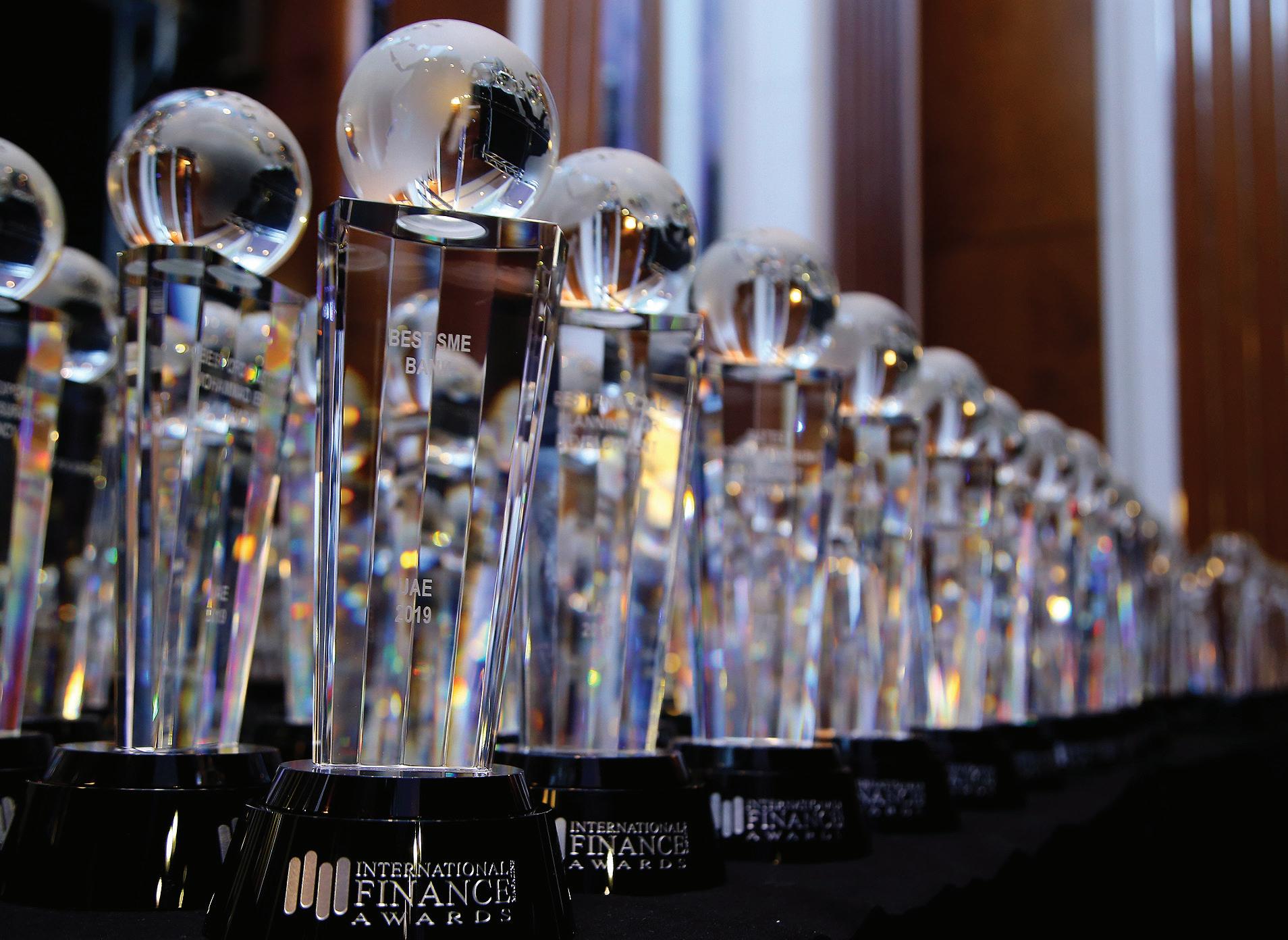
SOCAR Türkiye is the only private sector player bringing in gas to the country from an alternative source

Since 2008, SOCAR Türkiye (subsidiary of the State Oil Company of Azerbaijan Republic, one of the world's largest oil and natural gas companies) has emerged as a leading energy venture working with the most advanced technologies to provide social, economic and environmental benefits for a sustainable life in the West Asian country.

As Türkiye's largest integrated industrial group, SOCAR Türkiye has expanded its operations in sectors like petrochemicals, refining, natural gas, trade, transmission and distribution, while continuously increasing its production capacity with our value chain extending from the source to
One such success story has been SOCAR Energy Trade, which has become the largest private sector natural gas wholesale portfolio in Türkiye, while carrying out SOCAR Türkiye's natural gas and electricity, trade and sales activities
International Finance recently caught up with Fuad Ibrahimov, SOCAR Türkiye, Head of Gas Business Unit, who shared his views about SOCAR Energy Trade, its import and export operations, and much more.

Can you briefly tell us about the electricity and natural gas trade operations of SOCAR Energy Trade?
SOCAR Türkiye contributes to country’s supply security by supplying up to 1.7 billion cubic metres of gas annually under the memorandum of understanding signed by the Ministries of Energy of the Republic of Azerbaijan and the Republic of Turkiye.
Accordingly, at SOCAR Energy Trade, we are a key link in the supply chain of the entire group. We make sure the Azerbaijani gas is used in our own petrochemical and refinery facilities in Turkiye. However, what I consider a key factor in our winning this award is our business model which goes beyond merely meeting the gas and electricity needs of our group companies.
Today, we stand as one of the prominent private sector players in Turkiye in the wholesale markets for both electricity and gas. For years, we have been providing gas and electricity to the B2B customers in our portfolio.
Our end-user portfolio volume for electricity rose to 300 MW while the electricity sales and trading volume stood at 750 MW. In 2023, our total trading and sales volume for gas and electricity hit the 21-terawatt mark.
Can you provide information on SOCAR Energy Trade’s import and export operations?
SOCAR Türkiye actively employs import and export channels to maximise the benefits of group companies and create added value. In addition to long-term contracts, SOCAR Türkiye procures natural gas from Azerbaijan through spot imports. SOCAR Türkiye is the only private sector player bringing in gas to our country from an alternative source. Furthermore, we have engaged in cross-border electricity trade operations with Georgia, Bulgaria and Greece since 2023.
What are the future plans of SOCAR Energy Trade?
SETAS continues to act as a onestop shop for the energy needs of its customers in Turkiye, offering a sustainable energy supply as well as its energy expertise to become their solution partner in energy. I believe our trade company won this award for its competence in providing its customers with a one-stop shop for energy.
Our operations are not solely limited to gas and electricity supply. We act as a solution partner for all needs of our energy-related customers. We aim to update
our solutions through continuous development in line with global energy trends.
In addition, at SOCAR Energy Trade, we focus on operations to enhance the value of not only the Turkish supply chain but also the global supply chain. We are planning new strategic steps to increase the added value of our integrated value chain in gas. With the addition of the electricity generation link to our gas value chain and the subsequent trade and cross-border activities, our value chain will be further enriched.
What are the action steps SOCAR Energy Trade takes in terms of sustainability and green energy?
We have renewable power purchase agreements (PPAs) in our own supply portfolio. Moreover, we support our customers in terms of sustainability. To reduce the carbon footprints of end users and make them carbon neutral, we have been selling renewably sourced and I-REC (International Renewable Energy Certificate) certified green energy since 2021. In 2023, SETAS procured green energy to 21% of its end-user portfolio. This year, we intend to ensure that green energy sales make up 25% of our third part portfolio as a minimum.
A group of industry experts founded Aerion Supersonic in 2004, determined to create a $120 million supersonic aircraft that would first take to the skies in 2029
When the first prototype of Concorde (retired Anglo-French supersonic airliner) took its maiden flight from Toulouse in 1969, it was hailed as a revolutionary chapter in the field of civil aviation. The market was predicted for 350 aircraft, and the manufacturers Sud Aviation (later Aerospatiale) and the British Aircraft Corporation (BAC) received up to 100 option orders from many major airlines. Concorde created headlines by achieving transatlantic range while supercruising at twice the speed of sound for 75% of the distance.
Private companies are not the only ones participating; NASA is developing the X-59, a supersonic aircraft, through its “Quesst” programme. Its purpose is to reduce the noise of the infamous "boom" in order to avoid the problems of the Concorde
Despite delays and cost overruns, the project was deemed a game-changer for civil aviation, as since its maiden service flight on 21 January 1976 with Air France from Paris-Roissy and British Airways from London Heathrow, Concorde quickly captured flyers' attention. Transatlantic flights became the main market, with Washington Dulles and New York JFK becoming the operational hubs for these jets. While Air France and British Airways operated 20 such airframes together, they could only operate them for transoceanic flights, as going supersonic, despite more than halving travel
times, brought another menace: sonic booms over the ground.
However, the story met a horrible ending on 25 July 2000, when Air France Flight 4590 crashed shortly after takeoff, killing all 109 occupants and four on the ground. Although the remainder of the fleet came back to service eventually, they were retired in 2003, 27 years after beginning their commercial operations.
Since then, aviation geeks have been wondering: Will there be another supersonic passenger jet, or will concerns like deafening sonic booms and exorbitant costs push things back again? However, companies like Boom Supersonic, Spike Aerospace, Exosonic, and Hermeus are bringing the concept back to life.
In August 2022, American Airlines pre-ordered 20 Overture aircraft from Boom, with the option to purchase an additional 40. With a $10 million initial investment, Japan Airlines too followed suit with a pre-order for an additional 20, and United Airlines promised to purchase 15 from the venture.
Boom claims that the jets, which are anticipated to be built in 2025 and make their flight by 2029, will carry 80 passengers on over 600 routes and reduce travel times by up to 50% compared to their subsonic counterparts.
Private companies are not the only ones

participating; NASA is developing the X-59, a supersonic aircraft, through its “Quesst” programme. Its purpose is to reduce the noise of the infamous "boom" in order to avoid the problems of the Concorde, which was only permitted to reach supersonic speeds over the ocean.
In order to measure the ground response to the sound, the jet is scheduled to fly over a few residential communities in the United States in 2025. The data will then be submitted to the International Civil Aviation Organisation in an attempt to change noise regulations. Opening hundreds of new airline routes to supersonic travel could result from its success.
According to Boom, passengers could travel from Miami to London in less than five hours, Tokyo to Seattle in four and a half hours, and New York to London in three and a half hours.
According to reports, Spike, which is creating an 18-passenger business jet that might be completed by 2028, is trying to increase speed even more in order to transport passengers from London to New York in as little as 90 minutes.
While Boom is aiming for net zero by 2025 and says Overture will "run on 100% sustainable
aviation fuel, making it the first new commercial aeroplane to have such capability,” Spike is aiming for net zero carbon by 2040.
As per Boom, its jets will have "engine updates, without afterburners, and an automated noise reduction system" to ensure takeoff is no louder than subsonic planes. Exosonic, which is developing a 70-passenger aircraft with VIP suites, says its sound will be quieter than that of regular traffic. Both companies are also working on lowering the boom through various technologies.
However, not everyone is assured about the prospects of supersonic flights being an instant hit in the coming days. Teal Group Senior Consulting Analyst Bruce McClelland is one of these sceptics.
“The problems are both economic and political. The faster an aeroplane flies, especially supersonically, the more it encounters an exponential increase in drag. That requires a lot more engine thrust, which requires a lot more fuel. Concorde needed as much as eight times more fuel to move one passenger from New York to London compared to a Boeing 747, so that’s expensive," he said.
“There’s also the cost of developing, building and
testing a plane. The development of modern jetliners runs into the multiple billions of dollars. I don’t see there being sufficient demand for a large production run, so it’s going to have to be priced pretty high. Given the physical limits, I don’t see a way to overcome this," he added.
The United States and the Soviet Union developed but later gave up on supersonic flight due to prohibitively high costs. Concorde was the only successful endeavour, and the French and British governments provided funding for it.
Kevin Michaels, Managing Director of AeroDynamic Advisory, said, "Boeing was developing its own supersonic aircraft back in the 1960s, and it dropped out when it saw that the US government wasn’t going to support it. There are only two airlines that used Concorde, BA and Air France, and it never made money for the manufacturers that produced it. If the manufacturer can’t make money producing it, then it’s not going to be a viable market in the long run. The economics of being part of an airline are what ends up killing you, and that was one of the biggest lessons from Concorde."
Additionally, there is a great deal of uncertainty regarding the engine's manufacturer. With a statement stating that the commercial aviation supersonic market was "not currently a priority," Rolls-Royce recently ended its collaboration with Boom. Since then, Honeywell Aerospace, Safran, and General Electric have

all declared that they will not be manufacturing the engine.
"That left only Pratt & Whitney, and they said it’s not core to them and their brand, and they’re focusing on other projects. Engines take years and years and years of development, and a brand new one costs billions of dollars. These five companies are the only companies that have a remote chance of pulling this off technologically, so as it stands, Boom doesn’t have an engine," Michaels added.
Boom is currently developing a purpose-built turbofan engine called "Symphony" for its Overture supersonic airliner.
Boom will probably encounter more obstacles even if it sorts out
the engine hurdle. NASA's project probably wouldn't be ready in time for Boom's anticipated 2029 takeoff, and it's unclear if the sonic noise problem can be resolved.
Additionally, there is the matter of customer demand. Flights across the Pacific that could have attracted customers are not feasible due to the current supersonic jets' limited range before requiring refuelling.
Most importantly, a lot of people have questioned the sustainability claims at the moment, as the supplies of sustainable aviation fuel are still scarce.
“The claim that Boom’s flights will be offset by using only sustainable aviation fuel strikes me as stretching credibility. The only way that works is if the producer
of a supersonic aircraft has its own source for SAF. Otherwise, operators will be forced to queue up with everyone else and take whatever they can get their hands on, most of which will probably be plain jet fuel. SAF right now is more expensive than regular jet fuel, so it just adds to the operating costs. Right now, known SAF production represents only a small fraction of a per cent of the total worldwide demand for jet fuel, and the most optimistic scenario I’ve seen is that this might ramp up to 30% by 2050," McClelland said.
There are chances of airlines ending up facing criticism if they use their limited supply of SAF for supersonic travel (pumping multiple times as much fuel per passenger as a regular aircraft).
Aerion Supersonic, the massive business jet company that went out of business, is all too familiar with these challenges. A group of industry experts founded the company in 2004, determined to create a $120 million supersonic aircraft that would first take to the skies in 2029. At the time, this project was regarded as the most promising option in the supersonic world.
However, it never built an aircraft and, after 17 years of trying, declared bankruptcy, stating that it was having difficulties in raising capital to achieve the next steps in the manufacture and regulatory approval of the company's supersonic aircraft.
"Aerion was very highly thought of in the industry. It was aimed at business aviation and
Maximum Speed: Mach 2.04 (2,179 km/h or 1,354 mph)
Cruise Speed: Mach 2.02 (2,158 km/h or 1,340 mph)
Range: 3,900 nautical miles (7,223 km or 4,488 miles)
Service Ceiling: 18,300 metres (60,000 feet)
Rate of Climb: 50.8 metres per second (10,000 ft/min)
Passenger Capacity: 92 in standard configuration and up to 120 in high-density layout
Engines: 4 × Rolls-Royce/ Snecma Olympus 593 Mark 610 turbojets with afterburners
Engine Thrust: 140 kN (32,000 lbf) standard; 169 kN (38,050 lbf) with afterburner per engine
Fuel Consumption: Approximately 13.2 kg/km (46.85 lb/mi) when configured for maximum range
Source: Britannica
charter companies rather than commercial flight, so there was a much smaller capacity. It had a really interesting design, they were extremely well-funded, and they had some of the big OEM manufacturers on board. Then one day, they announced chapter 11 bankruptcy, and it was over. There’s only been one successful entrant into the jetliner business globally, and that’s Embraer in Brazil," Michaels noted.
None of this means that supersonic travel will never again be possible. However, the challenges indicate that, should it ever regain traction, the business aviation sector is more
likely to see success than largescale commercial aircraft. That’s at least the opinion of Michaels.
"Demand for supersonic travel is there, but it’s very niche. It doesn’t lend itself to commercial airlines. It lends itself to lower capacities, and ultra-high-net-worth individuals. So, is it something that’s going to revolutionise the airline industry as we know it? I don’t think so," he said.
There is still hope that we could one day be flying around the world in a few hours and in a semi-sustainable manner if NASA's project is successful. This is because sustainable aviation fuel will become more widely available, operating costs can be reduced, and supersonic jets can travel farther.
We may have to wait a bit longer before we can hop over to Australia in half a day, though, as reaching that destination by 2029 appears to be more of a marketing gimmick for airlines like United and American.
Supersonic travel remains a captivating vision for aviation's future. While technical, financial, and ecological challenges persist, ongoing innovations and renewed interest suggest the dream of faster-than-sound passenger flight may yet become reality again.


Building on the foundations of conventional and generative artificial intelligence (GenAI), agentic artificial intelligence (Agentic AI) is fast emerging as the next big leap in the evolution of artificial intelligence (AI), entering an unexplored area with its capacity for autonomous, multi-step reasoning. Agentic AI goes beyond prediction models that propose results or react depending on learnt patterns; it acts on its own initiative. Often, without continuous human oversight, these artificial intelligence bots may spot issues, create and weigh several answers, decide what to do, and carry out judgments. Particularly for its ability to transform how operators maximise infrastructure, solve network anomalies, lower operational loads, and improve customer experience with intelligent self-service technologies, this paradigm shift is generating great interest in the telecom industry.
Notwithstanding the futuristic promise, a fundamental concern remains: Is the telecom sector, which has always been hesitant to absorb unproven innovation and highly wary about losing control, ready to embrace a kind of artificial intelligence that questions its conservative DNA?
Plotting the history of artificial intelligence in telecoms helps one to see the relevance of agentic artificial intelligence. Early in the 2000s, phone companies started using rulebased systems for fraud detection and automated call routing.
Predictive analytics and machine learning first began to be applied to project network congestion, client turnover, and service demand by the 2010s. More recently, GenAI solutions have helped with content generation and natural language processing for consumer-facing applications.
However, their lack of contextual awareness and real-time execution capability hampered these instruments. Agentic artificial intelligence marks a new horizon whereby autonomous systems may not only evaluate but also act with agency, judgment, and adaptation.

Juniper Research's observations suggest that agentic artificial intelligence has great potential in telecoms since it may assume challenging roles with less control. Network optimisation is one of the most important uses because agentic systems surpass mere problem prediction.
Through constant learning from patterns and adaptation, these agents may proactively fix network imbalances and preserve optimal performance conditions. Both security and fraud detection benefit equally; rather than depending on fixed rules, these artificial intelligence agents dynamically change security protocols to counter changing cyber threats, thus enhancing resilience in an era of ever-advanced attacks.
Virtual assistants driven by restricted GenAI or chatbot logic usually cannot independently address problems in customer service. Agentic AI, on the other hand, is poised to transform this field by allowing bots to not only comprehend
but also act on sophisticated consumer needs, including account settings, refund requests, or technical problem solutions without agent escalation. Long praised but rarely smooth, personalisation becomes more flexible and responsive as AI systems continuously learn and customise services to real-time user behaviour.
Agentic artificial intelligence has a transforming edge in its change from static automation to autonomous orchestration. This new degree of capability brings contextual awareness and decision agency, therefore transcending artificial intelligence's usual job as supporting analysis in the field of digital operations management. One European CTO said at MWC 2025, "Agentic AI is the brain we always wanted for our networks, but we’re still not sure if we trust it with the steering wheel."
Although the phrase "agentic AI"
sounds like a futuristic abstraction, its basic ideas are not wholly novel. For years, telcos have been testing network automation, particularly via SelfOrganising Networks (SON) in the Radio Access Network (RAN), where artificial intelligence controls network tuning and resource allocation. Still, SON systems are essentially rule-based and reactive. Rather than making decisions on their own, they respond to premeditated stimuli.
Agentic artificial intelligence marks a further development. Targeting predictive correction and autonomous learning, these agents are not only reacting to events but also constantly scanning, hypothesising, and testing network configurations in the background. This can cover application performance management, real-time orchestration across RAN and core networks, and anomaly prevention before user impact. The intricacy and seeming risk involved in handing
important operational choices to nonhuman systems make the telecom sector understandably dubious, even with great theoretical appeal.
Industries like banking have been more aggressive with artificial intelligence autonomy by comparison. Though dangers vary, algorithmic trading in finance or smart manufacturing with dynamic supply chain changes shows that agentic systems are possible. The difference emphasises how adoption curves are shaped by sector-specific pressures and legal obligations.
Adopting agentic artificial intelligence has significant financial consequences, rather than only technical ones. Over the next ten years, industry observers estimate that intelligent automation in telecoms might release up to $200 billion in value. Improved client retention, better network use, and operational cost savings could account for a good portion of this value.
While tailored customer journeys driven by AI may boost ARPU (average revenue per user), AI-based predictive maintenance could help lower downtime and related service fines. Reducing the requirement for customer service escalation or manual network troubleshooting could also free up important human resources for more high-value projects. These efficiency improvements could be very important for long-term viability for carriers running slim margins.
Ethical issues will surely become more pressing as agentic artificial intelligence finds an increasing presence in telecom operations. Should AI
Source: Grand View Research

agents be allowed to provide traffic top priority during network congestion, and if so, under what standards? Might personalising algorithms that favour high-revenue consumers disadvantage some user groups? When AI decides on choices with social or political ramifications, including the undervaluation of connectivity in underdeveloped areas, what follows?
To meet these issues, openness and explainability will be crucial. Telcos will have to create systems that clearly justify their autonomous judgments as well as make them. The system design philosophy has to change from blackbox models toward interpretable and auditable AI systems. As artificial intelligence's influence in telecom services grows, regulatory authorities will probably seek more responsibility.
Telecoms have been quite cautious when implementing autonomous artificial intelligence systems compared to other industries. Algorithmic trading systems now make choices in milliseconds and run with almost no human involvement in finance. Smart manufacturers utilise artificial intelligence to dynamically change supply chains and maximise manufacturing processes depending on demand and logistics.
Often in high-stakes settings, even
healthcare is starting to adopt AI-powered diagnostics and patient monitoring.
These industries present both successful blueprints and cautionary stories. Successful adoption of artificial intelligence depends on progressive implementation, well-defined return on investment, and a significant emphasis on ethical monitoring, among other common denominators.
Telecoms have to absorb these lessons by building trust through openness, implementing human-in-the-loop protections, and matching technology change with cultural and legal realities if they are to properly leverage agentic artificial intelligence.
Although present agentic artificial intelligence applications in telecoms mostly address RAN optimisation, network performance, and customer service, their possibilities go much further. Agentic artificial intelligence could spread into more significant corporate roles in the next few years.
Dynamic pricing engines, for example, might independently change service plan rates using real-time network statistics and market trends. AI agents may also assist operators in managing spectrum allocation depending on changing traffic and geopolitical conditions or in reacting to the marketing of competitors.
Agentic artificial intelligence might also be involved in marketing, doing A/B tests on offers, and independently scaling the most successful campaigns or changing messaging depending on live sentiment analysis.
Autonomous systems could find abnormalities in bills and send proactive communications or corrections to consumers without human interaction. The potential of AI models to impact
high-level business results will likely increase in parallel as they develop and train on multimodal data (from speech, usage behaviour, location, and CRM inputs).
Industry viewpoints are still split, but they are also growing interesting. Some CEOs on the ground at events like MWC 2025 predict agentic AI as unavoidable. Others exercise caution, however.
A Chief Technology Officer from a Scandinavian operator remarked, "We're not looking to replace our engineers, but why not let an artificial intelligence spot and fix abnormalities faster than a NOC team?"
Analysts also agree: telcos must lean in rather than jump. Emphasising "measured experimentation" as a strategic approach to agentic AI, Gartner's 2025 telecom tech view exhorts operators to "fail fast in contained zones" to build trust without losing stability.
Right now, the largest divide resides not in technology but in trust. Cultural changes and organisational buy-in will be essential to scale the promise of artificial intelligence from hype to daily use as agentic systems gradually establish themselves in constrained roles.
Although concrete, large-scale projects are still a year or two off, with 2026 expected as a likely turnaround point, some telcos have already dipped their fingers in the water. For example, recently, Google Cloud and Deutsche Telekom revealed a cooperation to test agentic artificial intelligence in a RAN context.
Without waiting for human input, this artificial intelligence agent is designed to spot performance problems in real-time and act immediately for correction. Enhanced network uptime, lower costs, more bandwidth stability, and better client experiences are among
the expected results.
In the same vein, Telenor and Ericsson co-developed a proof-of-concept aimed at maximising RAN capacity and energy economy. Particularly in changing demand environments, a rising issue in 5G and soon-to-be 6G infrastructures, their usage of agentic AI promises to balance traffic loads more efficiently.
Industry insiders warn that these initiatives are still in controlled conditions and distant from being implemented over commercial networks, despite the hoopla around events like MWC 2025.
The unifying thread running throughout these early-stage initiatives is that agentic artificial intelligence is intriguing but still immature. Important unresolved issues still include performance under erratic pressure, interface with legacy systems, and openness of autonomous judgments. AI without explainability in decision paths could cause compliance problems.
According to a recent Telecoms.com survey on 5G AI adoption, reliability, responsibility, and service assurance still define the telecoms sector. Only 10% of Communication Service Providers (CSPs) today feel comfortable introducing unsupervised, totally autonomous AI into live production environments.
About 78% of respondents would rather have partially automated or supervised solutions, keeping human operators in the loop.
Why the opposition? Three main obstacles emerged: a lack of in-house AI expertise to oversee these complex systems, the financial cost of upgrading infrastructure to fit advanced AI workloads, and most importantly, a strong worry about dependability and trust.
Telecom infrastructure is too important for systems to fail or make opaque
decisions that humans cannot readily audit or undo; it is even sometimes life-saving. This emphasises a major drawback in the current drive for agentic artificial intelligence: operator confidence is not where the technology may be ready.
Ethical questions add still another level of complication. Should artificial intelligence be allowed to give some clients higher priority than others under bandwidth constraints? How can personalisation driven by artificial intelligence prevent aggravating digital inequality? The more decisions these systems make, the greater the demand for accountability mechanisms to monitor and explain them.
From AI-assisted systems to agentic designs, this is an ideological as much as a technical challenge. It challenges accepted wisdom regarding responsibility, control, and the part human knowledge can play in intricate systems. This leap forces carriers to fundamentally rethink operations, far more than a small step.
And there are significant hazards as well. Autonomous agents that misinterpret scenarios could cause operational interruptions, expose security flaws, or conflict with laws requiring human supervision. Add to this the increased scrutiny from authorities and watchdogs all throughout Europe, North America, and Asia, and it is evident why telcos are still reluctant to fast-track this change.
Still, small adoption could be the path ahead. Telcos could begin with hybrid systems, semi-agentic configurations whereby AI agents propose and carry out low-risk decisions under supervised observation. Before extending to missioncritical areas like core infrastructure or emergency communication layers, this

hybrid approach provides a safe runway for internal familiarity and trustbuilding.
Over the next decade, industry analysts project that intelligent automation in telecoms could generate as much as $200 billion in value. Although only a fraction of this can be ascribed to agentic artificial intelligence, its influence is projected to grow as systems develop and confidence increases.
Agentic artificial intelligence seems on paper to transform telecom operations. Real-world acceptance is probably not going to be sudden, though. Rather, the change will probably be seen as a slow evolution whereby companies add agentic elements on top of current systems instead of replacing them entirely.
Still, a change is in process. Over half (51%) of CSPs in another Telecoms.com survey said that artificial intelligence is starting to profoundly change their perspective on operations, customer interaction, and service delivery.
These figures indicate growing excitement mixed with institutional and cultural immobility. Particularly in layers of artificial intelligence operations and customer management, where agentic capabilities can generate quantifiable returns without compromising fundamental service dependability, investments are gradually rising.
Concurrently, telecom decisions on new technologies are being shaped by outside elements ranging from geopolitical concerns to inflationdriven cost management measures. Even if customer-facing installations remain delayed, the urge to safeguard systems through agentic techniques may ironically hasten adoption in some security roles in areas with weak data laws or dangerous cyber environments.
Agentic AI may find its way from network administration into strategic tasks, including infrastructure investment forecasts, market competitiveness response, or real-time price optimisation in the long run. Still, those use cases are only conceptual. For telecom companies,
agentic artificial intelligence has great promise, offering a means to turn reactive systems into intelligent, proactive networks. But telecoms is a business based on dependability, consistency, and confidence.
Agentic systems may shine in demos and pilot environments, but to have a significant role in telco operations, it will demand a demonstrated track record of dependability and openness.
In the near term, one might expect a pragmatic approach: well-scoped pilot projects, semi-autonomous decisionmaking in controlled situations, and a consistent change in perspective from human-led to human-supervised AI.
The actual change will be incremental and consistent, not a flash revolution. Agentic artificial intelligence is still a fascinating frontier for now, and one operator will explore with one hand on the throttle and the other firmly on the brake.
Environmental Horizons will continue to push the boundaries of waste management innovation, providing sustainable solutions that support industrial growth in an environmentally friendly manner
Environmental Horizons will continue to push the boundaries of waste management innovation, providing sustainable solutions that support industrial growth in an environmentally friendly manner
Saudi Arabia-based Environmental Horizons (EH) has become a leader in sustainable waste management, dedicated to developing pioneering solutions that align with environmental best practices and sustainability goals.
The company, known for its mission to minimise environmental impact while ensuring compliance with the highest safety and regulatory standards, was recognised as the “Most Innovative Waste Management Services Provider - Saudi Arabia 2024” in the recently concluded International Finance Awards.
Specialising in carbon ash management, the company serves major carbon fly ash generators across the Kingdom, including power plants and desalination facilities.
Its approach includes collection, transportation, storage, recycling, and disposal, ensuring a minimal environmental footprint. Licenced by NCEC (National Centre for Environmental Compliance) and MWAN (National Centre for Waste Management), Environmental Horizons’ efforts focus on reducing fly ash pollution through reuse in cement factories, as well as exploring new valorisation opportunities, such as metal extraction, in collaboration with local and international partners.
“As a premier provider of asbestos management solutions, we employ state-of-the-art techniques to handle its removal, transportation, and disposal. Services include asbestos surveys and analysis to assess risks, air monitoring to ensure safe removal procedures, safe dismantling, wrapping, and transportation of asbestos waste, and training programmes to raise awareness and ensure compliance with safety regulations,” the company told International Finance.
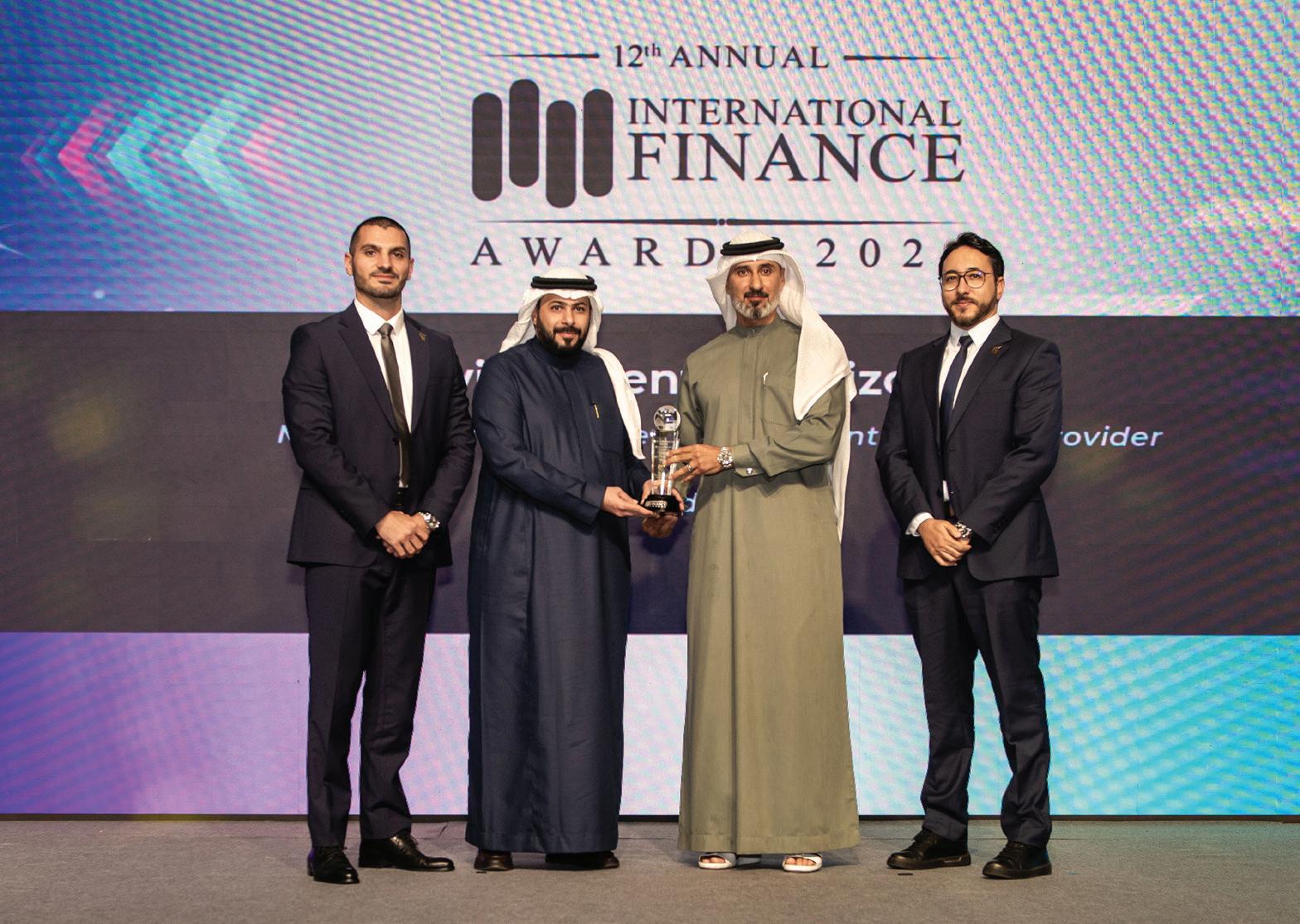
Operating one of the largest and most advanced industrial and hazardous waste treatment and disposal facilities in Saudi Arabia, covering 1,000,000 m², the facility is equipped to handle a variety of hazardous wastes using cuttingedge treatment methods.
“The waste management process includes collection from power plants, petrochemical industries, and laboratories, transportation using a modern fleet with tracking, control, and cooling systems, and classification, treatment, and disposal through secure

Environmental Horizons added.
“Understanding the complexities involved in hazardous waste transportation, the company is licenced to transport hazardous materials while ensuring compliance with environmental regulations. A well-structured logistics network provides businesses with cost-effective and customised solutions, making waste removal both convenient and safe,” the company noted.
Pushing the envelope of innovation
Advancing waste treatment and disposal through continuous innovation, the company owns and operates the largest hazardous waste landfill in the region, which meets stringent safety and sustainability criteria.
Key processes at the facilities include inspection and weighing to verify waste type, quantity, and compliance, classification and treatment to determine the most sustainable disposal methods, and
management, the company has been authorised by Saudi NCEC and MWAN to collect, transport, and treat used oils with a strong focus on recycling. The Rabigh facility is now capable of treating hundreds of cubic metres per day, with a storage capacity exceeding 2,500 m³. Services include oil byproduct collection from industrial sectors, fuel tank cleaning and oily sludge treatment, and hydrocarbons recovery to maximise resource efficiency.
With a growing demand for sustainable wastewater treatment solutions, state-of-the-art treatment facilities have been established. Advanced technologies such as neutralisation and settlement techniques, oil-water separation and oxidation processes, and innovative effluent management solutions for industries including power plants and petrochemical companies are applied.
The wastewater treatment facility has a capacity of up to 2,500 m³/day, playing a vital
Among the few companies approved by Saudi NCEC to provide specialised landfill construction and maintenance services, Environmental Horizons offers a complete suite of services, including landfill design and engineering to ensure environmental compliance, insulation and lining with highquality HDPE geomembranes, and leak detection, site maintenance, and sludge removal.
By integrating high-quality landfill construction with ongoing management services, waste disposal sites meet the highest environmental safety standards.
Environmental Horizons will continue to push the boundaries of waste management innovation, providing sustainable solutions that support industrial growth in an environmentally friendly manner. As Saudi Arabia progresses toward a greener future, the company remains at the forefront, ensuring that industries can manage waste responsibly and efficiently.


IF CORRESPONDENT
Over the last 12 months, Saudi Arabia's aviation industry has achieved unprecedented heights, thanks to a spike in passenger volume, the acquisition of new aircraft, and significant international alliances.
These developments are part of a larger plan to position the Kingdom as a major international aviation hub and a premier travel destination.
As part of its “Vision 2030” strategy, Saudi Arabia is spending billions of dollars to diversify its economy away from fossil fuels, strengthen its private sector, improve connectivity, and bolster its position in the global aviation industry.
According to this strategy, the Kingdom's aviation objectives include transporting 4.5 million tons of air cargo by 2030 and providing 330 million passengers with seamless travel experiences across more than 250 locations.
The President of the General Authority of Civil Aviation, Abdulaziz bin Abdullah Al-Duailej, said, "This transformative strategy offers lucrative opportunities for the private sector to contribute to the realisation of the country's ambitions. The possibility of privatising 27 airports, which are currently being prepared for transfer to private hands, is one of these prospects."
In 2024, Saudi Arabia's aviation industry experienced unprecedented growth between January and September, with 94 million passengers, which is a 15% increase, travelling through the country. Additionally, the number of flights grew by 10% over 2023, while air freight volumes increased by 52% to nearly 1 million tons.
The industry, which was valued at $1.2 billion in 2023, is predicted to expand at a compound annual growth rate of 8.88% between 2025 and 2029. The GACA's roadmap, which was presented at the Future Aviation Forum in Riyadh in May, emphasised this expansion.
International companies are being engaged to expand King Salman Airport. Under the direction of the King Salman International Airport Development Co., a division of the Kingdom's Public Investment Fund, these partnerships will help grow the airport and establish it as a major transportation and tourism hub.
Riyadh Air, which intends to start operations in 2025, inked a deal in October to purchase 60 Airbus A321neo single-aisle aircraft. The agreement was finalised at the 8th Future Investment Initiative in Riyadh. The airline announced in the same month
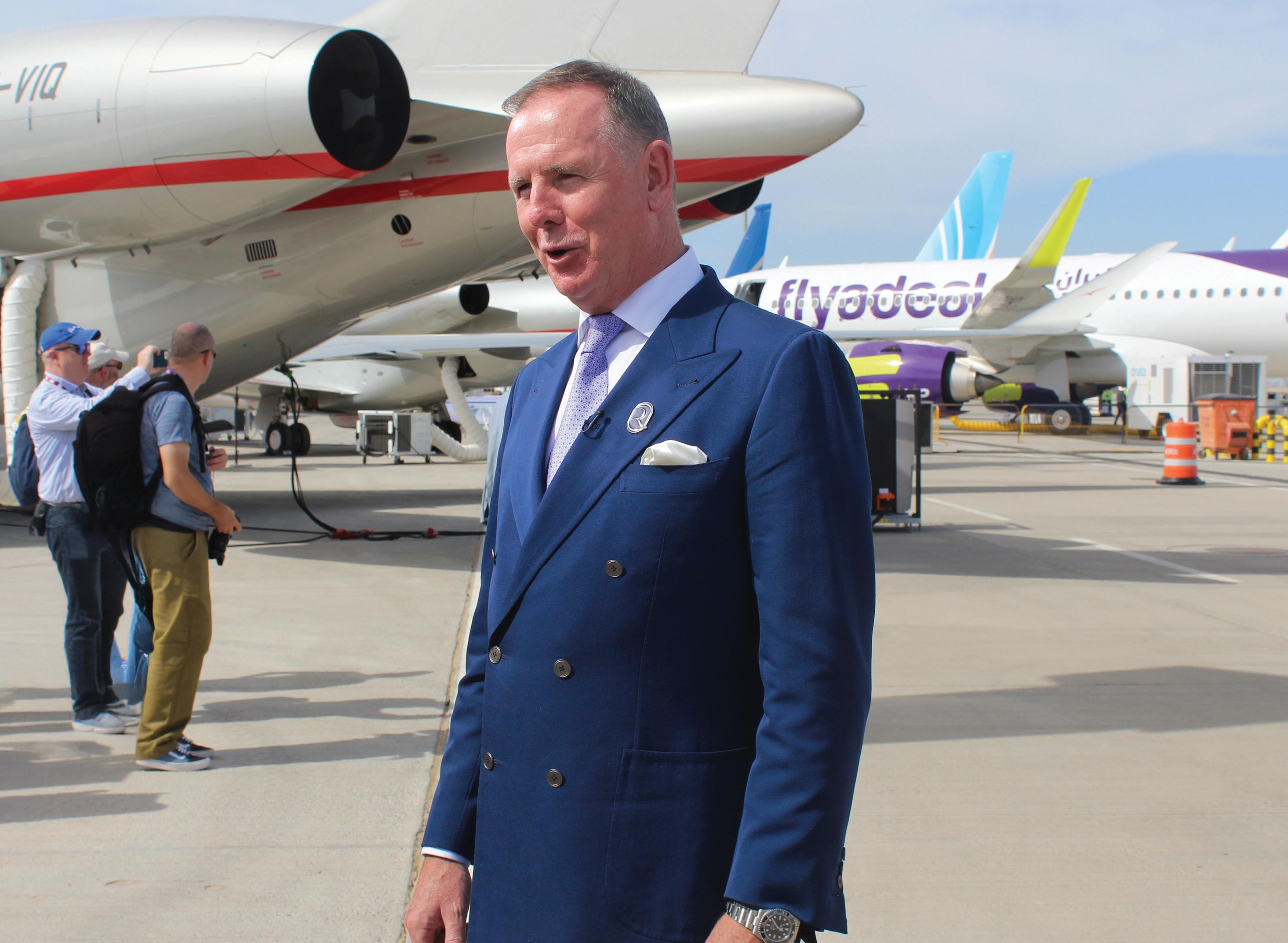
that it plans to order wide-body aircraft in 2025 that can accommodate over 300 passengers.
The new airline declared in August that it had signed a multi-year contract to join Concacaf, the FIFA Confederation for North, Central America, and the Caribbean, as an official airline partner.
The agreement aims to support Concacaf's national and club events throughout the Americas and increase the airline's visibility in international sports. In order to forge strategic alliances and broaden its global network, Riyadh Air signed contracts with Singapore Airlines and Air China in June 2025.
The airline's vice president of digital
and innovation, Abe Dev, said, "With AI integration, we aim to redefine travel standards, offering a personalised, seamless, digital-first experience to our guests ahead of our maiden flight in 2025."
According to CEO Tony Douglas, the airline needs "a very large fleet" to compete with regional giants. Therefore, in May, it announced plans to expand its aircraft portfolio through fresh orders.
This move coincides with the Kingdom's second flag airline placing an order for 39 Boeing 787-9 aircraft in 2023, with an additional 33 options. Major cities in Europe, the US East Coast, and Canada will be among the airline's
first stops. The first flight is expected to depart by June 2025.
In order to increase and localise its maintenance, repair, and overhaul capabilities, Saudi Arabia and Air FranceKLM formed a strategic collaboration in December 2024. The goal of this partnership is to support the Kingdom's economic development and improve its aviation infrastructure.
In July, a deal was signed between the Saudia Group and the German aerospace company Lilium NV to purchase 50 confirmed Lilium Jets, with
the option to buy another 50. Lilium develops fully electric vertical take-off and landing aircraft.
Through this agreement, the Saudi airline will become the first in the region to invest in environmentally friendly air travel. During the Future Aviation Forum in May 2024, Saudi Arabia and Riyadh Air struck a deal to collaborate on aviation professional training.
At the same event, the Saudia Group announced the largest Airbus deal in Saudi history: a $19 billion order for 105 A320neo family aircraft. Deliveries of the aircraft, which include A320neo and A321neo variants, will begin in early 2026 and be divided between Saudi Arabia and its low-cost carrier, flyadeal. Flyadeal will receive its first aircraft and plans to have 100 by 2030.
The first fully-owned aircraft, an Airbus A320neo, was delivered to flyadeal, a low-cost airline based in Saudi Arabia, in 2024.
The airline announced this milestone in June and stated that it would double its fleet to 100 aircraft by 2030, with plans to increase it to around 50 by the end of 2025. Flyadeal also began operating seven weekly flights using an Airbus A320 between Riyadh and Sarajevo as part of its expansion plan.
The airline revealed that it would launch three new domestic flights in January. Beginning on January 1, there will be four weekly flights to Tabuk and services from Dammam to Najran. On January 2, three weekly flights to Yanbu will also be introduced. Amid its historic expansion, Flynas secured a deal for 280 aircraft.
In the first half of 2024, Flynas, which has been named the Best LowCost Airline in the Middle East for seven consecutive years, recorded a 47% increase in passengers, surpassing seven million.
Annual air passengers in Saudi Arabia from 2016 to 2023 (In Millions)

Under its "We Connect the World to the Kingdom" campaign, the airline announced additional African routes in November 2024, including flights from Riyadh to Entebbe, Uganda, and Jeddah to Djibouti, starting January 8, 2025.
At the Farnborough Airshow in July, Flynas doubled its orders to 280 Airbus aircraft, including 130 narrow-body A320 models and 30 wide-body A330neo models, after striking a deal to purchase 160 of the aircraft. As part of an order for 120 aircraft worth SR32 billion ($8.5 billion), the carrier recently celebrated the delivery of its 53rd A320neo.
Saudi Arabia’s aviation renaissance cannot be fully appreciated without understanding the historical inertia it seeks to overcome. For decades, the Kingdom’s skies were primarily the domain of Saudia, the national airline founded in 1945 with a single DC-3 aircraft gifted by US President Franklin Delano Roosevelt.
The airline served a limited network, focused mostly on religious pilgrimages and regional connectivity. Infrastructure
development was sporadic, with most airports offering minimal amenities and little to attract international transit passengers.
While nearby Gulf nations aggressively expanded their aviation sectors in the 1990s and early 2000s, which turned Dubai and Doha into global transit hubs, Saudi Arabia remained largely inward-looking. Its vast geography, rich history, and strategic location were underutilised, hampered by bureaucratic inefficiencies and a lack of private sector involvement.
Hajj and Umrah travel formed the bulk of air traffic, leaving tourism, business travel, and cargo operations comparatively underdeveloped. A generation of global travellers passed through the Gulf without ever setting foot in the Kingdom. While other regional airlines boasted gleaming terminals, global partnerships, and next-generation aircraft, many Saudi airports struggled with overcrowding, delays, and a reputation for being outdated.
Vision 2030 is, in many ways, an effort to reclaim that lost ground and reintroduce Saudi Arabia as not just a destination, but a connective force between East and West. Understanding this history is essential to grasp the urgency behind the Kingdom’s current push because it’s not just about growth; it’s about catching up, overtaking, and ultimately leading.
At the heart of Vision 2030 is a redefinition of aviation, not just as a transport utility, but as a catalyst for national transformation. Saudi Arabia is not just laying tarmac but also laying the groundwork for an entire economic reconfiguration.
The aviation sector is poised to create over 35,000 jobs by 2030, many of
which will be in high-skill areas like aviation engineering, airport management, logistics, and digital systems. This isn’t just job creation; it’s a cultural shift.
For the first time, a generation of young Saudis is being encouraged to see the aviation industry not just as passengers, but as pilots, innovators, and global service leaders. Gender inclusion is another quiet revolution underway: previously male-dominated fields such as air traffic control and aircraft maintenance are now opening up to women, thanks to focused policy changes and state-sponsored scholarships.
Beyond employment, aviation is a key pillar of the Kingdom’s broader goal of attracting 100 million tourists annually. The ripple effects are farreaching: hospitality, retail, construction, and technology sectors all benefit from increased connectivity. With partnerships formed between GACA and global players like Airbus, Boeing, and Air France-KLM, the Kingdom is actively importing not just aircraft, but knowledge, standards, and practices. These are not isolated transactions; they represent a long-term bid to develop indigenous capability and reduce overreliance on oil exports. The aviation sector, therefore, is not just a beneficiary of economic diversification; it is a driver. It touches every major node in the national strategy, from soft power to sustainability, and from job creation to foreign investment.
Yet ambition alone does not guarantee altitude. Saudi Arabia’s aviation roadmap must navigate formidable turbulence. The challenge of distinguishing itself from entrenched Middle Eastern players like Emirates and Qatar Airways is real. These legacy carriers have massive
fleets and mature brand identities, dominating strategic transit corridors between Europe, Asia, and Africa. Saudi Arabia’s late entry means it must differentiate itself through service innovation, pricing, and geopolitical leverage. Riyadh Air’s upcoming fleet and partnerships with carriers like Delta and Singapore Airlines are steps in the right direction, but the execution must be flawless.
The Kingdom must also guard against overbuilding. Ambitious projects, such as the 105-aircraft order by the Saudia Group and the development of multiple mega-airports, risk running ahead of demand if not managed with precise traffic forecasts and international market integration.
Furthermore, infrastructure delays, supply chain issues, or misalignment between regulatory bodies and investors could stall momentum. Then there’s the environmental equation: global aviation is under pressure to decarbonise, and Saudi Arabia’s ambitious expansion could face pushback if not paired with credible green initiatives. Investing in sustainable aviation fuels, electric vertical take-off and landing aircraft, and green airport designs will be critical to winning global credibility.
Lastly, the political landscape is fluid. Diplomatic shifts, regional instability, or trade conflicts could disrupt traffic flows and strategic partnerships. To succeed, Saudi Arabia must not just build runways but create a resilient, flexible ecosystem that can withstand shocks. That will require more than vision; it will demand agility, humility, and a relentless commitment to world-class standards.
The year 2024 marked a historical high point for Kingdom's aviation industry. A confluence of increased domestic mo-

bility, expanding international routes, and a recovering global travel market contributed to unprecedented growth.
Over 128 million passengers flew through Saudi airports in 2024, a 15% increase from 2023 and a remarkable 25% rise compared to pre-pandemic levels. This total comprises 59 million domestic travellers and 69 million international passengers. The numbers go beyond statistics and reflect the growing confidence in the Kingdom's aviation ecosystem.
The Kingdom recorded 905,000 flight movements, split nearly evenly

between domestic (474,000) and international (431,000) flights. This surge depicts both the regional integration of Saudi airports and their rising global relevance.
Meanwhile, cargo volumes exceeded 1.2 million tonnes, a 34% year-on-year increase. This positions Saudi Arabia as an emerging logistics giant, critical for regional and intercontinental supply chains.
A booming aviation sector cannot sustain its momentum without robust infrastructure. Saudi Arabia has responded to this challenge by launching a wave of airport modernisations and
expansions designed to meet rising demand and improve the passenger experience.
Key facilities such as King Khalid International Airport in Riyadh and King Abdulaziz International Airport in Jeddah are undergoing extensive expansions. These projects aim to increase capacity, reduce congestion, and incorporate modern amenities to align with international standards.
Regional airports like Taif International and Al-Ahsa International are receiving substantial upgrades. These developments aim to decentralise air
traffic, spur regional development, and enhance overall connectivity within the Kingdom.
As part of broader efforts to improve passenger satisfaction, airports are being redesigned to include better retail spaces, upgraded lounges, and faster immigration processes.
One of the most significant milestones in Saudi Arabia's aviation journey is the birth of Riyadh Air, a new national carrier designed to challenge established global players and cater to a growing

international audience.
Riyadh Air has placed an order for 60 Airbus A321neo aircraft, with delivery scheduled to begin ahead of its operational launch in the summer of 2025. The choice of a fuel-efficient and modern fleet highlights the airline's commitment to sustainability and performance.
In a major coup, Riyadh Air has forged a partnership with Delta Air Lines, facilitating direct flights between the US and Saudi Arabia. This is not just a route expansion but a signal of intent that the Kingdom is ready to play on the global stage. Riyadh Air is poised to become a symbol of Saudi Arabia's modernisation efforts, showcasing its cultural richness, technological aspirations, and service excellence. Vision 2030 is not just about building airports or acquiring aircraft, it is about creating a resilient, competitive, and investor-friendly aviation ecosystem.
Saudi Arabia plans to channel $100 billion into its aviation sector by 2030. This includes investments in infrastructure, aviation services, training, technology, and innovation.
To attract foreign investment and streamline operations, the Kingdom has implemented a range of regulatory reforms. These include new licensing procedures, improved transparency in policymaking, and measures to ease entry for international aviation businesses.
The government is actively inviting private players to participate in airport operations, cargo handling, and ground services, which is creating a more dynamic and diverse aviation market.
Aviation's role in economic diversification
Aviation is no longer viewed in isolation
but as a strategic enabler for economic diversification. The aviation sector is pivotal in achieving the Vision 2030 goal of attracting 100 million annual tourists. From heritage sites in AlUla to Red Sea luxury resorts, improved air connectivity is making Saudi Arabia more accessible than ever.
The aviation sector is expected to contribute $2.08 billion to the GDP and create over 35,000 jobs by 2030. These include roles in airport operations, engineering, hospitality, logistics, and airline management. By inviting international players and experts into the Kingdom, the aviation sector serves as a channel for skills development, technology transfer, and innovation.
Saudi Arabia's aviation sector is embracing the future with open arms, integrating some of the most advanced technologies available. The Kingdom is developing a roadmap for Advanced Air Mobility (AAM), including the use of electric vertical take-off and landing (eVTOL) aircraft. These futuristic vehicles have the potential to redefine urban mobility and reduce traffic congestion in megacities.
Initiatives such as e-gates for faster immigration, AI-powered passenger management systems, and drone-based building maintenance are turning Saudi airports into smart transportation hubs. With growing digitisation, emphasis is also being placed on cybersecurity and the use of big data to enhance operational efficiency and the passenger experience.
The General Authority of Civil Aviation (GACA) also got its new brand identity, along with a digital customer platform, at the beginning of 2025. The new Ajwaa platform will now enable customers to access aviation regulatory
and licensing services digitally through a "one-stop shop," including applications for pilot, cabin crew, and crewmember licenses, and a range of single and annual flight permits.
While the trajectory is impressive, the path forward is not without hurdles. Gulf neighbours such as Dubai and Doha have already established themselves as formidable global aviation players. Saudi Arabia must differentiate itself with unique value propositions in service, pricing, and connectivity.
The rapid pace of growth is exerting pressure on existing infrastructure. Delays in construction, logistical inefficiencies, or misaligned timelines could hamper service quality. As global scrutiny on emissions intensifies, Saudi Arabia must balance growth with a commitment to sustainable aviation, investing in biofuels, carbon offsetting, and green airport designs. Saudi Arabia's aviation sector is not merely growing, it is evolving with purpose and precision.
From establishing new national carriers and expanding airports to launching technological innovations and reforming regulations, every initiative is a step toward realising Vision 2030.
Yet, the ultimate success will depend on execution. With smart planning, resilient policies, and a long-term commitment to excellence, the Kingdom can transform itself into a global aviation powerhouse that connects the East and West not only through flights but also through ideas, people, and opportunities.
As the engines roar and runways extend, Saudi Arabia is preparing to soar higher than ever before, charting a course toward a bold and diversified future.

For over a decade, iWind has successfully navigated numerous challenges, providing innovative solutions to its clients
Recognised as Thailand’s “Wind Hunter,” iWind is a key player in the country’s renewable energy sector. As an industry expert, iWind offers comprehensive solutions across all phases of wind farm development, from feasibility studies to post-construction operations and maintenance. The company ensures that each project is optimised for maximum efficiency and long-term sustainability. The competitive landscape of the alternative energy sector is shaping the future of clean energy, driven by advanced technologies in wind turbine projects and other renewable energy solutions. As the global focus intensifies on clean energy and environmental sustainability, wind energy has become a key solution for reliable, sustainable power generation. iWind leverages cutting-
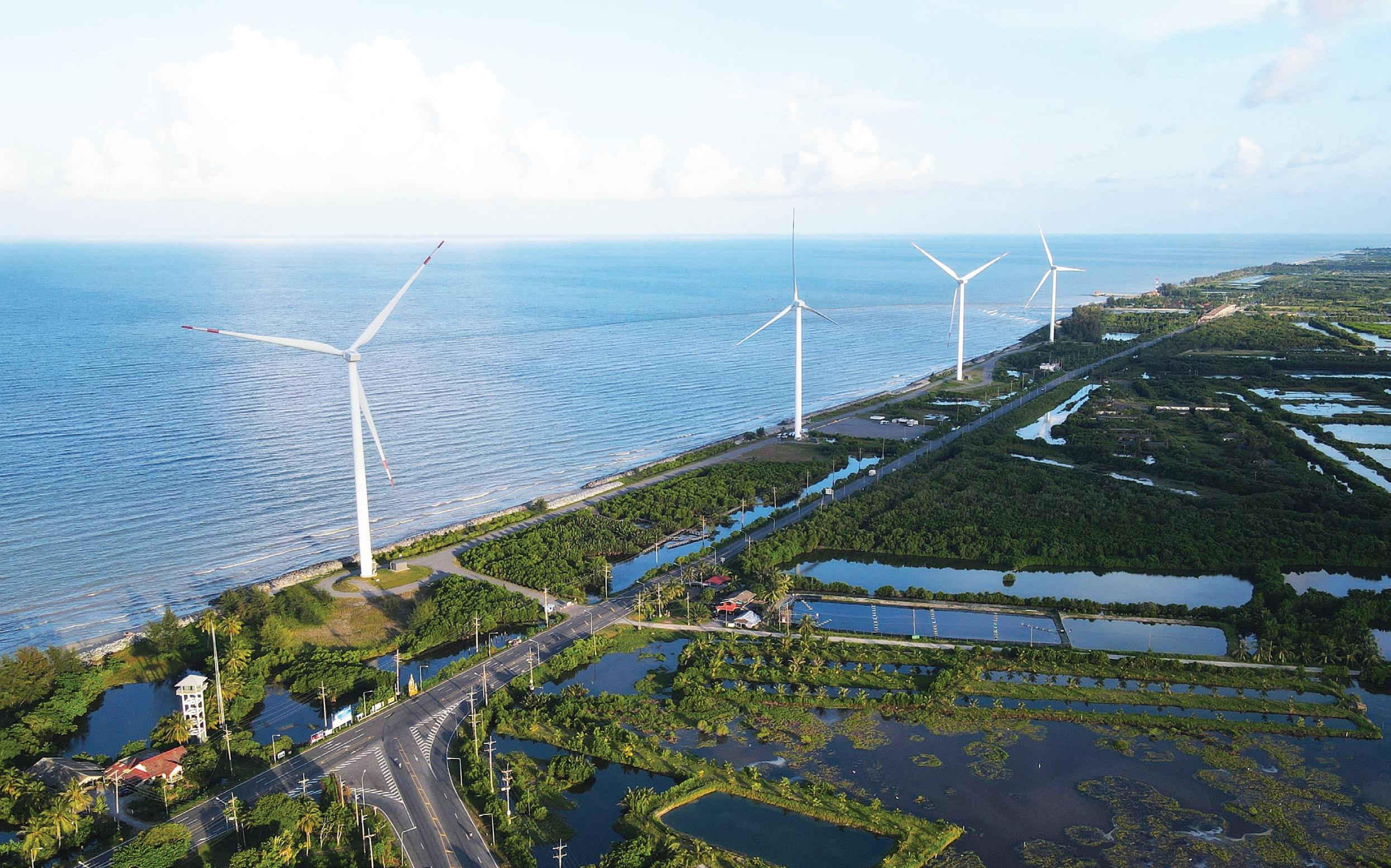
edge technology and innovative solutions to ensure that each wind project not only provides clean energy but also aligns with global efforts toward sustainability and resource efficiency.
iWind has firmly established itself as a leader in wind farm development by seamlessly integrating innovation while reducing the time consumed throughout every phase of the projects. Leveraging advanced tools and deep industry expertise, iWind enhances efficiency and sustainability to deliver exceptional outcomes.
The company’s approach begins with state-of-the-art wind data surveying and analysis, enabling it to identify regions with the greatest potential for energy generation. Using sophisticated simulation and project analysis software, iWind designs optimised wind farms that maximise energy efficiency while maintaining the highest safety standards.
For streamlined project
management, iWind employs automated systems that reduce costs and improve overall energy production efficiency.
The company’s commitment to technological integration ensures that every aspect of design, planning, and execution meets the highest standards of accuracy and reliability. Beyond technical excellence, sustainability remains at the core of its mission. iWind prioritises environmentally responsible practices, ensuring that its projects positively impact local communities and ecosystems.
Backed by a team of experienced professionals, iWind continues to set industry benchmarks, delivering high-quality, futureready wind farm solutions. In addition to its commitment to technological innovation, the company recognises that the future of renewable energy also hinges on ESG practices.
iWind is proud to be the driving force behind numerous successful wind farms in key regions across
Thailand and Southeast Asia. Over the years, the company has played a crucial role in transforming the renewable energy landscape, contributing to major wind energy projects both directly and indirectly. iWind takes pride in sharing its expertise, insights, and creative solutions in these projects, which provide sustainable energy while promoting positive impacts on local communities through job creation, economic growth, and environmental stewardship.
iWind has successfully navigated numerous challenges, providing innovative solutions to emerging crises. It seizes new opportunities under modern, high-quality organisational policies that align with the digital transformation and the evolving landscape of renewable energy. As iWind operates, it remains fully committed to maintaining the highest level of expertise and adhering to rigorous technical and safety standards, including ISO 9001, ISO 14001, and ISO 45001.


Imagine paying A$39 per day to park your car, while you visit your ailing child in the Royal Children's Hospital in Melbourne. For Australian families already struggling in a cost-of-living crisis, hospital parking fees are piling further agony, especially during a health crisis. Parking at hospitals is a significant source of income. Let’s call it "Parking Syndrome."
In 2024, public hospitals in New South Wales received nearly $51 million from parking fees. That was more than the $30.02 million in 2023. As per RMIT University's senior faculty members Lisa Farrell and Meg Elkins, while the move may have sounded tempting for health infrastructures to exploit a captive market, the reality is much more complex, if one brings disciplines like economics, finance, and behavioural business into play.
Mismatch between supply and demand
Price is the means by which supply and demand are balanced, according to basic economics. This price is referred to as the equilibrium price. When supply cannot keep up with demand, prices increase.
"Due to the limited number of parking spots, urban hospitals face market conditions that, predictably, result in higher prices. In certain situations, however, suppliers may charge more than the equilibrium price
if there is still a need for parking despite the cost, according to economics. In short, this 'inelastic demand' implies that a captive audience can be charged more," said Farrell and Elkins.
"Hospital visitors and patients could be considered a captive audience. Although public transportation is well-served by many hospitals, patients and visitors are frequently too ill or time-constrained to utilise it. They are therefore forced to pay for parking. Visitors must drive because public transportation is either non-existent or very limited in rural hospitals. Do hospitals have a reason for charging such high prices, or are they price gouging, setting prices above what is deemed fair or reasonable, or are they exploiting the inelastic demand for parking?" asked the duo.
Hospital parking lots in desirable areas attract not only patients and visitors but also city workers and tourists seeking convenient parking. Parking spaces are kept available for hospital users by discouraging these users with high fees. High costs discourage
overstaying in hospitals. Because of this, they are unable to engage in non-hospital activities (like shopping) following their hospital visit or appointment and before getting back to their cars.
Hospitals also charge high prices to raise revenue for health care. NSW Health said in a statement to the ABC earlier this year that additional funds generated from parking are used to fund medical facilities and services.
"However, it might be a false economy to increase parking fees in order to fund hospital budgets. We are aware that hospital visitors play a significant part in patients' recuperation. Therefore, extended hospital stays for their loved ones may result if high parking fees discourage guests or caregivers. More visits could result from less expensive parking, which would cut down on hospital
per patient," remarked Farrell and Elkins.
Lisa witnessed this firsthand when her father, who has dementia, was admitted to the hospital.
"The hospital provided free hospital parking and round-the-clock visitor access for caregivers, like my mother, in this instance. For dementia patients, who frequently become confused while in the hospital, access should be available around the clock. Known as sundowning, this disorientation usually gets worse in the evening. The presence of carers allowed staff to concentrate on medical concerns. It made it easier to visit during offpeak hours, when parking is less of a problem and dementia patients usually require additional assistance," she noted.
The high demand for a limited number of parking spots, which are rationed to those with the most money, is reflected in the high parking prices.
Rationing based on need, or improving patient well-being, is a better option. Charging different users different prices is the economic solution.
By making concessions, the majority of hospitals have already accomplished this. However, concessions may vary by state or hospital. It can be difficult for some people to determine whether they qualify for concession-rate parking, and not everyone is aware that it is available.
"Therefore, before parking at a hospital, be aware of the fees and any available discounts if you are worried about the cost. The websites of most hospitals have this information. At the moment, most concessions are determined by income, including having a concession card. However, we must make a bigger change to offer needbased concession rates. For instance, accommodations are needed for longstay patients to promote their wellbeing. Hospital parking fees for regular
users should be capped nationwide, according to the media campaign," Farrell and Elkins observed.
Although most parking lots have a daily cap, frequent visitors may soon accrue substantial bills from hospital visits for weeks or months. Many patients incur yearly parking expenses, especially those who need frequent treatments like dialysis.
Concession rates for hospital visitors should be granted based on need rather than just income. Patient welfare and the value of visitors to the healing process should guide needs. Proper rules are required towards this direction, especially for those who use the hospital parking lot, to streamline the procedure.
Considerations for long-term solutions, such as relocating hospitals away from desirable locations, are important when building new facilities or expanding existing ones. This approach could reduce the appeal of

parking for individuals who do not use hospitals. Healthcare systems face the challenge of balancing the ethical principles of access and equity, which are vital for providing essential care, with the operational necessity of cost recovery.
"Meanwhile, with 1,190 parking spaces, Blackpool Victoria Hospital was ranked seventh in the UK. Costing £2.70 per car for two hours of parking, the car park can earn a potential revenue of £3,213 within two hours at maximum car park occupancy. This placed Blackpool Victoria, after Salford Royal, Darent Valley, Furness General, and Poole, as the fifth cheapest hospital in the UK to park at," said Farrell and Elkins.
Moreover, there are 3,388 parking spaces at Manchester Royal Infirmary, which has the most parking spaces and could make over £10,000. Because it serves a large area and has a high volume of patients, staff, and visitors,
this Manchester hospital, one of the biggest in the UK, needs a sizable parking facility. At £7.00 for two hours, Chelsea and Westminster Hospital has the highest parking fee. Given that the hospital is situated in one of London's wealthiest neighbourhoods, the cost of parking there might be a reflection of both the area's high parking demand and the hospital's location.
Hospital parking fees, while justified as revenue sources, can impose emotional and financial burdens on vulnerable families. A shift to needbased concessions and ethical pricing is urgently needed.
Easy Parking plays a vital role in realising Saudi Arabia’s Vision 2030 goals, particularly in the areas of urban mobility and sustainability
The Kingdom of Saudi Arabia, through its “Vision 2030” economic diversification agenda, is implementing significant advancements in urban development, mobility, and infrastructure. At the forefront of this change is Easy Parking Co., a leader in delivering innovative, sustainable, and customer-focused parking systems. With a bold vision and strategic partnerships, the company is redefining the role of parking as an integral part of the Kingdom’s evolving urban mobility ecosystem.
Guiding this transformation is Iain Synnott, the newly appointed COO (Chief Operating Officer) of Easy Parking. Holding a Master’s degree in Business Administration,
he brings over 20 years of international expertise in parking and transport management, having led transformative projects across the United States, Europe, APAC (Asia and Pacific), and MENA (Middle East and North Africa) regions.
Under Iain Synnott’s leadership, Easy Parking is driving forward with innovative projects, strategic collaborations, and advanced technologies that align seamlessly with "Vision 2030" goals. As part of the transformation and growth, Masthan Shaikh, CCO (Chief Commercial Officer) of the company, a project management professional, has been helping in building the foundation with the required objectives and strategies by being extensively involved in the BOT (Build-Operate-Transfer) and PPP (Public Private Partnerships) model projects with Government/ Semi-Government entities like MOMAH (Ministry of Municipal and Rural Affairs), Cluster2 Airports, Masar Makkah etc. in the "Smart Mobility" and "Smart Cities Projects."

Masthan Shaikh also brings over 20 years of diverse experience in software development, ICT, engineering, tendering & bids, vendor & contract management, and commercial/business development. Both Iain Synnott and Masthan Shaikh are working under the leadership of Salman AlHaqbani, Easy Parking's CEO, while sharing the common vision of turning the urban mobility transformation into a reality with anticipated growth, while ensuring a good customer experience.
Transformative projects in the holy cities
Easy Parking is at the forefront of delivering state-of-the-art parking and mobility solutions in the Kingdom’s most significant spiritual and cultural destinations—Makkah and Madinah. The company’s partnership with the Madinah Region Development Authority (MRDA) is focused on enhancing the city’s mobility infrastructure.
Key aspects of the project include on-street parking solutions along Madinah’s main streets, managed through an intuitive mobile app. Also, the initiative is providing car and bus parking facilities for major mosques, including Quba Mosque, Miqat Mosque, Seven Mosques and Qiblatain Mosque.
“These initiatives are designed to deliver a seamless and respectful experience for visitors while integrating the latest technologies to improve efficiency,” Iain Synnott told International Finance.
Another flagship multi-use project is "Jabal Omar Development," which is located next to the Makkah's Grand Mosque. In addition to managing parking

facilities at the district’s luxury hotels, the project includes a variety of innovative mobility services like valet parking and taxi management services, enhanced convenience and accessibility for visitors, golfcart shuttles to provide easy access to Al Haram, sightseeing tour buses, e-Scooters and staff shuttle buses for the mobility of the hotel employees.
Easy Parking's other Makkahbased standout project is the "Masar Destination," an iconic urban development under Umm Al-Qura Development, a Public Investment Fund (PIF) company. The company is installing and managing systems for more than 5,700 parking spaces across four facilities, integrated with the Masar Bus Rapid Transit (BRT) system.
Speaking about this, Iain Synnott said, “This project represents the future of urban mobility. By integrating parking with the BRT system, we’re creating a seamless, sustainable, and visitor-focused solution.”
Business expansion in the Eastern Province of Saudi Arabia
Easy Parking’s recent deal with Al Mana Hospitals, will help spread its wings into the Eastern region
market of Saudi Arabia by making a strong presence in cities like Dammam, Dhahran, Khobar, Jubail and Hofuf/Al Ahsa.
Khobar is one of the wealthiest cities in Saudi Arabia, forming part of the 'Triplet Cities' region alongside Dhahran and Dammam. Its prosperity is largely driven by the oil industry, which plays a central role in the area's economic success.
At the heart of Easy Parking’s operational success is its commitment to leveraging advanced technology. A prime example is the MAWQFI smart parking system, developed in collaboration with sister company, Etech, and SAMI AEC, a PIF company.
MAWQFI consolidates multiple parking services into a single, userfriendly system, with features like off/on-street parking operations, enforcement, and management, valet and taxi services, car wash, quick maintenance, shuttle/golf cart services, loyalty programmes, and digital payment options.
MAWQFI will soon have a prebooking and pre-payment module, with capabilities like dynamic pricing and yield management enabling
users to plan their parking ahead of time while optimising space utilisation for operators, thereby reducing congestion, improving accessibility, and enhancing the overall user experience.
Aligning with Vision 2030
Easy Parking plays a vital role in realising Saudi Arabia’s Vision 2030 goals, particularly in the areas of urban mobility and sustainability.
The company’s projects focus on integrating parking with broader transportation networks, such as the Masar BRT system, creating a cohesive and multimodal approach to urban mobility. These solutions are designed to reduce congestion, improve accessibility, and enhance the overall user experience.
Sustainability is also a core focus for Easy Parking Initiatives such as incorporating EV charging stations, implementing energyefficient infrastructure, and adopting green operational practices demonstrate the company’s commitment to environmental stewardship.
“We’re not just addressing the needs of today. We’re building systems that will support the sustainable cities of tomorrow," Iain Synnott concluded.
Elon Musk’s involvement with the Trump administration has drawn backlash from potential Tesla customers
President Donald Trump has been at the peak of his volatility: at first, he announced sweeping "reciprocal tariffs" against the United States' allies and adversaries. Then he took a U-turn and announced a 90-day pause on the implementation of these import duties, as more and more countries reached out to the US to negotiate. However, he has been ruthless on China, imposing more than 100% tariffs on them.
Two commonly reported factors have caused Tesla's sales to decline. First, Tesla owner Elon Musk has been involved in President Trump's administration, which has angered some potential customers
Analysts see the "reciprocal tariff" game as a classic case of the world's largest economy weaponising its global hegemony and forcing countries to come to the discussion table, so that America's trade ties around the world can be redefined on the White House's terms and conditions.
However, in the "game of reciprocity," the worst-impacted were the stock markets around the world. And Wall Street and the tech-oriented Nasdaq weren't exempt either.
Tech giants like Apple, Nvidia, Microsoft, HPE, Dell, Cisco, Amazon, Google, Salesforce, Intel, ServiceNow and Snowflake saw their shares go almost to dust and then rise steeply, all in just a few hours.
As widely reported, tech shares have been

extremely volatile over the past year. Long before President Trump's tariffs caused wider stock falls, share price graphs frequently resembled rollercoaster rides.
Elroy Dimson, a professor of finance at the University of Cambridge, says that one of the main causes of the volatility in the tech sector is that, similar to the early days of the automobile industry, we don't know which tech companies will succeed in the long run.
During an interaction with BBC, Prof. Dimson said, "If you go back to the beginning of the last century, there were an awful lot of motor companies, and it was clear that automobiles were going to make a huge difference. But almost every company went bankrupt, and you didn't know which company you should be buying."
Of course, not every high-tech company is profitable. Two factors are used to calculate the return on an investment in shares: the growth in profits or dividends and the increase in share value. Boring companies may raise the value of their shares over time and pay consistent dividends. However, many high-tech businesses don't pay dividends at all. Instead, they invest in future expansion, which is why their share prices vary based on expectations of future earnings.
Susannah Streeter, head of money and markets at the financial services company Hargreaves Lansdown in the United Kingdom, said, "Tech shares are more volatile, have high valuations, and have very high price-earnings ratios. Growth
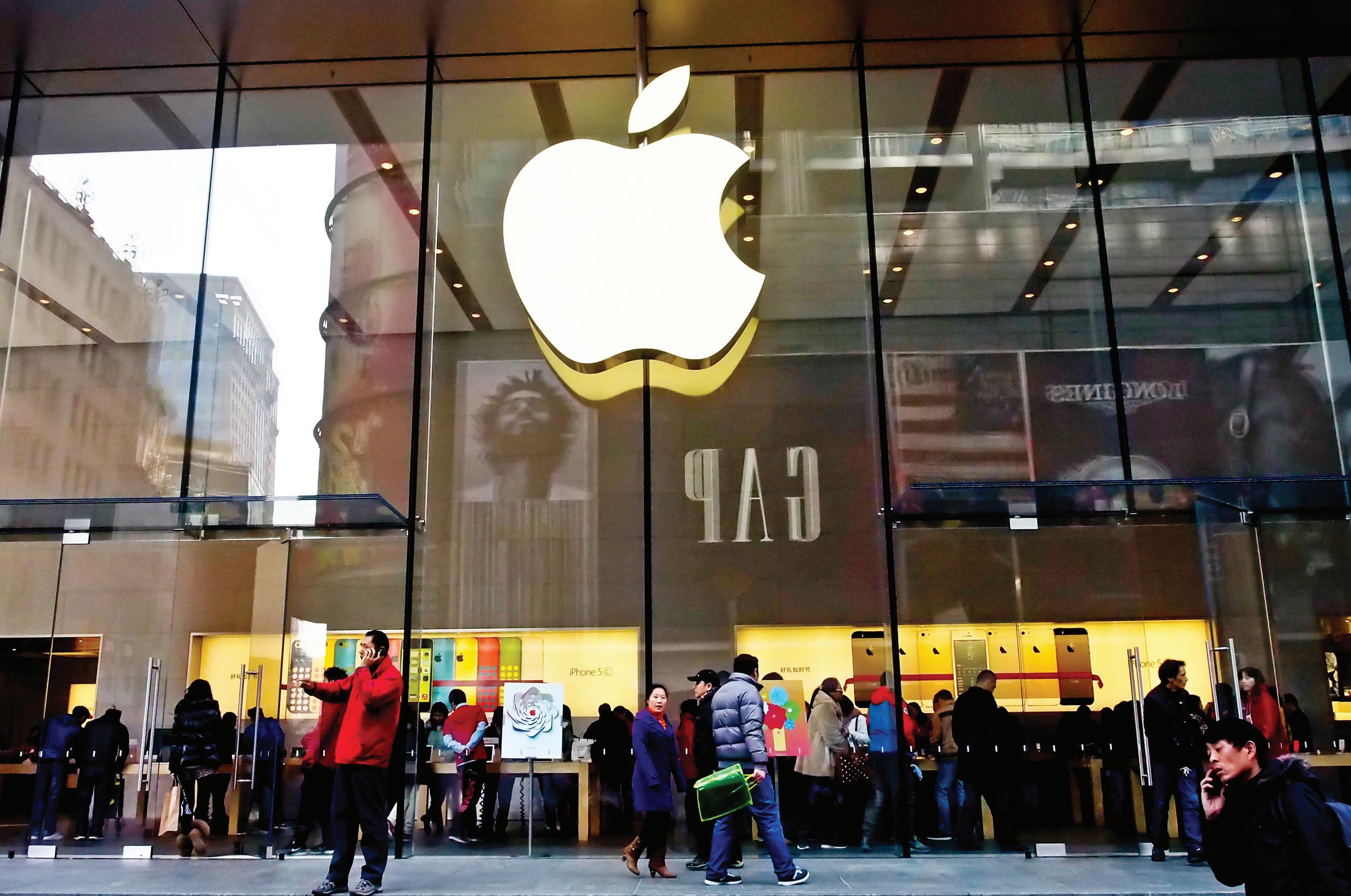
stocks are also more susceptible to changes in interest rates."
"But also, investors in these shares are betting on not jam today but jam tomorrow," Streeter suggests.
They are all attempting to identify the next big winner, not the one making money right now, but the one that will eventually pay out enormous dividends at some point in the future. Therefore, share values may plummet if there is any indication or news that future growth will not be as strong as anticipated.
However, any positive news causes share prices to rise, even if there is no change in current profits or losses, as investors pour money into what they believe will be the future winner. Due to the fact that current profits and dividends do not underwrite the shares, they are more volatile.
Prof. Dimson said, "The small changes in growth expectation can lead to large changes in share value, which can have a simultaneous impact on numerous companies.”
"You have companies that are reasonably similar, so when growth rates change, it affects quite a few companies in a similar way. This is not different from the dotcom boom at the beginning of the 2000s. There were companies with huge growth prospects. And when the growth prospects disappeared, these were the companies that disappeared," he added.
Furthermore, there are still relatively few truly sizable high-tech businesses. In America, they are
referred to as the "magnificent seven": Tesla, Meta, the parent company of Facebook, Apple, Microsoft, Amazon, Google, and chipmaker Nvidia. Therefore, it doesn't take much to frighten the market, particularly since many of these companies are relatively new and dominate industries where earlier leaders have failed. Are you familiar with Compaq, Boo, or Ericsson?
Since technology is evolving so quickly, unlike, say, the production of steel or food, there is a real risk that a new high-tech company will emerge and completely upend the business strategy of its most established competitors. That today's "magnificent seven" will continue to be magnificent or even remain the same seven firms is not guaranteed.
For instance, two commonly reported factors have caused Tesla's sales to decline. First, Tesla owner Elon Musk has been involved in President Trump's administration, which has angered some potential customers. Furthermore, BYD and other Chinese electric vehicle companies are becoming more formidable rivals.
Meanwhile, after the launch of the Chinese AI chatbot DeepSeek at the beginning of 2025, Nvidia's stock price fell precipitously. According to reports, this app was made for a small portion of what its competitors paid.
The immediate success of DeepSeek has sparked speculation about the extent of investments that US companies are planning as well as the future
DONALD TRUMP APPLE
of America's dominance in AI. Since Nvidia is leading the way in creating microchips for AI processing, this has become a source of concern for the company.
Nowadays, AI is the biggest tech game in town, and it seems everyone is claiming that AI is transforming their industry, their products, and their profits. They can’t all be right.
"At least in 1910, you knew what automobiles did. But with AI companies today, you have to rely on the wisdom of the crowd, and that's not good enough for AI companies," Prof. Dimson noted.
Robert Whaley, finance professor at Tennessee's Vanderbilt University, said, "Not all AI companies can succeed. Technological volatility is undoubtedly influenced by AI. The race has begun."
Thus, shares of AI are susceptible to forecasts. Additionally, if a company shows signs of falling behind in the AI race, many investors, most of whom lack a deep understanding of the topic, may decide to move on to a company that appears more advanced. Then there are those investors who, as long as they are in the "booming" high-tech industry, appear to be speculating and spreading their risks regardless of which companies' shares they purchase.
To put it briefly, even in the high-tech industry, share prices are not always a reliable indicator of a company's worth or its future. Alternatively, they might symbolise investors' hope. Furthermore, hope does not always endure. It is frequently faddish, fleeting, and short-lived. Additionally, opti-
Leading tech companies worldwide in 2025, by market capitalisation (In Billion US Dollars)
Microsoft 3,380 Nvidia 3,239 Apple 3,007 Amazon 2,156 Alphabet 2,079 Meta Platforms 1,600 Tesla 1,098
Source: Statista

Tencent
600
1,083 TSMC 1,017
mism can occasionally fade away or confront reality head-on. In short, it is volatile.
DeepSeek threat lingers
DeepSeek, the Chinese AI chatbot, upon its launch earlier in 2025, became the most downloaded free app in the United States. Simultaneously, Nvidia ended up losing more than a sixth of its value. In contrast with OpenAI, which is proprietary technology, DeepSeek is open source and free, challenging the revenue model of American companies charging monthly fees for AI services.
Also, DeepSeek came into existence despite Beijing being denied access to the high-end semiconductors required for manufacturing AI models. The model has been created at a fraction of the price of its Western competitors.
DeepSeek may not be as sophisticated as ChatGPT or any other American AI model, but it has disrupted the tech industry with the message that anyone can develop an AI model in a costeffective manner while keeping it free and open for everyone. This has created doubts about the future
of American dominance in AI, and no wonder Nvidia and its rival Broadcom both faced the stock market heat.
In a commitment to invest $500 billion (£400 billion) in the development of AI infrastructure in the United States, OpenAI recently joined a group of other companies. It is 'the largest AI infrastructure project by far in history' and will help keep 'the future of technology' in the United States, according to President Donald Trump, who made the announcement in one of his first statements since taking office again.
The open-source DeepSeek-V3 model, which powers DeepSeek, was reportedly trained for about $6 million, a much smaller sum than competitors' billion-dollar expenditures. Chinese AI developers have collaborated and tried out novel technological approaches to carry on with their work without consistent supplies of imported advanced chips. Because of this, AI models now need a lot less processing power than they did in the past.
The Chinese company claimed that DeepSeek-R1 would perform "on par with" one of OpenAI's

most recent models for tasks like math, coding, and natural language reasoning. "AI's Sputnik moment" is how Silicon Valley venture capitalist and Donald Trump advisor Marc Andreessen referred to DeepSeek-R1, referencing the Soviet satellite launched in 1957. The technological accomplishment of their rival was regarded at the time as having taken the United States by surprise.
All Western tech majors like Alphabet, Microsoft, Siemens Energy and chipmaker ASML faced routs in the American and European stock markets, and they should and must not dismiss it as a “once in a century” phenomenon, as post DeepSeek's success, Chinese tech biggies like Baidu, Alibaba, and Tencent, alongside startups like Moonshot AI and Zhipu AI, have started spending big on the AI research and development front.
Fiona Cincotta, senior market analyst at City Index, said, "This idea of a low-cost Chinese version hasn't necessarily been at the forefront, so it's taken the market a little bit by surprise. So, if you suddenly get this low-cost AI model, then that's going to raise concerns over the profits of rivals, particularly given the amount that they've already invested in more expensive AI infrastructure."
However, Wall Street biggie Citi warned that although DeepSeek might threaten the market dominance of American firms like OpenAI, problems faced by Chinese companies might impede their growth.
"We estimate that in an inevitably more restrictive environment, US access to more advanced chips is an advantage," analysts said in a report.
The turbulence across global
markets, driven by tariff wars and AI disruption, emphasises a deeper uncertainty in the tech sector. Investors are no longer reacting to profits alone but to projections, geopolitical shocks, and policy shifts.
As AI evolves and competition intensifies, market volatility is likely to remain the new norm.
For the US, maintaining leadership will require innovation and strategic resilience in an increasingly unpredictable global tech landscape.


With Huzaifah's rags-to-riches story and increasing financials, eFishery was a rising star
IF CORRESPONDENT
Gibran Huzaifah looked into space while working on his laptop's Excel spreadsheet. He was three months from running out of money at eFishery, the Indonesian firm he had built from a fish-feeding prototype to a 100-person extension of himself.
He slowly included phoney numbers into the financial report. Instead of five years of hard labour, he turned his firm into a winner in one hour. He clicked send to show his investors; surely, he would get caught.
But he did not. It pleased his backers that his business was growing. Without knowing the data were manufactured, they contributed extra money to help Gibran avoid bankruptcy. In late 2018, he began building a house of cards that would cost some of the world's greatest money managers hundreds of millions of dollars.
Six years after starting a second set of accounts (a real one for his team and a second, inflated book for investors), eFishery was one of Asia's brightest firms with $1.4 billion in valuation and 2,000 employees. In addition to automated fish feeders to enhance output, it offered financing.
By the time it fell, the fraud had spread worldwide with bogus shell firms and inflated accounts. According to an internal enquiry, the corporation reported $752 million in first-nine-month 2024 revenues but actually earned $157 million.
Deception caught several of the world's most prominent venture capitalists, including SoftBank Group Corp. and Temasek Holdings. Abu Dhabi's 42XFund and Chamath Palihapitiya's Social Capital to Sequoia India and Southeast Asia (now Peak XV).
The episode raises unpleasant concerns about ego, groupthink, and how so many red flags were missed in backing a business darling. At least $300 million was lost by investors. It is unclear how much each fund lost, and some may have sold shares at a greater valuation.
The beginning
Gibran was reared in East Jakarta's slums by a construction worker father and a homemaker mother. MIT of Indonesia, Institut Teknologi Bandung, was his biology school. When his family struggled financially, Gibran was on his own. As food was scarce, he slept in mosques and at school, tutoring for money, working in a convenience store, and various side jobs.
Inspired, he rented ponds after taking a fish-farming course. He rapidly discovered hard work, small margins, and finicky fish.
Aquaculture, or water agriculture, is hard. Too little feed starves fish, while too much wastes money and produces algae. Spawned eggs are nursed in a series of pools before being released into larger ponds and given precise amounts at specific intervals. After months of care, fish must be sold and transported, sometimes alive, to processors and customers. Prices can vary greatly.
Gibran was determined. To make more money, he opened warungs to sell cooked fish and urged grocery stores to carry his product. While managing over 70 ponds, he intended to start a seafood restaurant franchise.
One veteran farmer advised him that growth makes feeding a chore. Gibran welded and programmed an automated fish feeder himself. His student project was a shiny milk bucket connected to a funnel that gravity-fed fish meal pellets onto a rotating disk. Texting opened a slide to release the feed, which scattered across the water.
Using a prototype on his motorcycle, he travelled between farms on rutted roads and village pathways for months. As the initially reluctant farmers observed yield benefits and provided testimonials, the initiative gained traction.
To raise awareness and win cash prizes to keep the business alive, he entered Jakarta startup competitions and quickly learnt the ABCs of venture capital: how to write a pitch deck, present his business model, and thrill investors with vision and financials.
eFishery struggled with their feeders' expensive pricing and small-scale fish farming's tight margins. Costs range from $400 to $600, depending on size and incentives. That was too expensive for many Indonesian clients, where 10% of the 280 million people live below the poverty line, and labour is inexpensive.
Gibran immediately switched from selling to renting his machines to farmers. He thought he could launch his feeders faster and recoup their expenditures in a few years. Because he had to buy the equipment ahead, he was spending money.
He tried to attract regional venture funders but was turned down. Singapore regulatory documents show the startup had $8,142 in cash by December 2017.

Aqua-Spark remained interested. It offered $1.5 million in three equal tranches for the Series A round in May 2018. Only other investors could provide the final $500,000.
The bargain bought him time, but no one else joined. Gibran believed he was responsible for the first million dollars if he failed to get investors. Aqua-Spark co-founder Amy Novogratz stated that the agreement did not impose personal liability.
He asked fellow Indonesian founders how they raised new investments, dejected. Gibran believed the unclear, coded advice meant fudging the figures. He had a moral dilemma: be honest and fail, or manipulate the stats and keep the show going for himself, staff, and farmers.
The sentiment changed drastically after a successful Series A fundraising, attracting

Singapore-based Wavemaker Partners and San Francisco-based 500 Global's Southeast Asia fund. It raised $4 million, including Aqua-Spark's third tranche.
Gibran had to justify the spreadsheet's new numbers. He started with a simple system. He said fish farmers had already bought feed and sold fish, so he offered 2% to 3% to “move” their business onto eFishery.
It was a sophisticated trick. Field consumers were unaffected. They used the same systems to sell to the same customers at the same prices. However, eFishery's income increased after those transactions were added to its financial accounts.
Kabayan, a finance scheme that used the startup's aquaculture expertise to assess harvesters' credit scores and secure loans from lending platforms, was riskier. A 1% to 3% commission and little risk were promised by eFishery. The
truth was worse: eFishery owed the debts, and default rates were high.
eFishery's Singapore-filed financial filings indicate a 50-fold increase in sales from $185,405 in 2018 to $10 million in 2019. Investors were thrilled.
In the same period, it went from a loss to a gross profit, attracting term sheets inconceivable months earlier. With
greater money came rapid expansion: applications to buy fish directly from farmers and drop points across islands to distribute feed and collect fish.
It affected some farmers. In Cirebon, West Java, Suganda was one of the first to use the eFeeder machine. A chest-high plastic drum can carry 100 kg (220 lbs) of fish feed. The barrel's bottom control box decides how much feed the pond fish receive. Farmers downloaded an eFishery app and entered feeding times and feed amounts to utilise the machine. Suganda denied that Gibran asked him to inflate numbers.
Suganda and his Cirebon collective farmers grew with $150,000 in loans from eFishery. His revenue increased by 20% to $603 a month as his pond count went from 10 to 70.
This progress occurred as startup investors sought more help-the-world concepts. Morningstar reported that sustainable fund assets rose 67% to roughly $1.7 trillion in 2020 as investors sought social and environmental partnerships.
With Gibran's rags-to-riches story and increasing financials, eFishery was a rising star. Gibran raised $20 million in Series B funding in 2020 from private equity firm Northstar Group and GoVentures (formerly Argor Capital).

Source:
Money and pride
Gibran said eFishery did not need extra money now. The pandemic even helped him balance the books: investors expected revenues to drop, but the business was doing well. He fabricated slow growth to catch up with the genuine data.
He learnt that SoftBank founder Masayoshi Son wanted to talk. In 2021, the COVID-19 pandemic peaked. He could not show SoftBank the fish farms in Indonesia that used his product like he did with prior investors. He only had an hour.
Gibran was anxious at his Bandung office. He bred fish on a small Indonesian farm a few years ago, and now SoftBank, which had raised roughly $100 billion for startup deals through its “Vision Fund,” was ready to verify his conviction in eFishery's future.
The company provided support to Yahoo Japan, Alibaba Group Holding, and Grab Holdings, which is one of Southeast Asia's most promising companies. Gibran mentioned that Son, who was listening from Tokyo, interrupted the pitch after 15 minutes. One of SoftBank's term sheets valued the company at $200
million, which made Gibran very happy. Sequoia India and Southeast Asia (Peak XV) suddenly submitted a $300 million bid. Temasek, Singapore's multibillion-dollar state-owned investor, also sought allocations. Gibran opened WhatsApp and saw a text from Temasek CEO Dilhan Pillay, which he thought was spam. Pillay requested time to discuss. He enjoyed the attention his small startup was getting, but he spent nights worrying about its weak foundations. eFishery reported 1.6 trillion rupiah ($95.3 million) in revenue and 142 billion rupiah before-tax profit in 2021. Revenue fell 40% to 958 billion rupiah, with a pre-tax loss of 164 billion rupiah. Gibran felt uneasy with the lie, but he remembered the trolley problem. He noticed how eFishery helped certain farmers. His startup had an impact, he believed. Taking this money would put further pressure on eFishery to grow, thus reconciling its two books would have to wait. He was split.
After the interest, SoftBank, Temasek, and Sequoia India offered $90 million in new funding at a $410 million value, according to Gibran, sources, and

Alternatives.pe. The price was high for a young firm led by an unskilled Indonesian fish salesperson. Three years ago, eFishery was worth $12 million, but the world's greatest investors noticed. The deal was accepted.
In retrospect, warning indicators existed. The 2020 Singapore holding company financial statement was filed in 2024. The lack of disruption in markets where eFishery claimed to be making waves was noteworthy. The company purportedly had over 300,000 feeding units in the field and over 44,000 fish and shrimp farmers buying from its platform by 2023, which should have shaken the supply chain.
Gibran ghosted them when one investor with feed producer ties tried to connect them with eFishery, a winwin for both parties. Another said Gibran was typically three months late with basic numbers and that a feeder component manufacturer told them it only produced enough for 5,000 units per year. Senior officials at Indonesia's largest fish feed distributors informed a separate investor that their unchanging sales were confusing.
Gibran said he needed larger farms with over $1 million in annual sales for his inflation approach to make sense after his Series C funding round, because the claims and targets were so big. After searching the nation, he found nothing to join.
He states that an employee proposed a solution in early 2022. By establishing a complex network of subsidiaries and managing farmers' accounts, the firm became sophisticated enough to exaggerate transactions. He notes that this led to the creation of five enterprises with over 5,000 accounts related to fish feed and fish sales.
While trying to meet investor claims, he burned through actual money. The

field teams and sales matchers.
By then, phoney numbers made eFishery seem supercharged. Series D fundraising spearheaded by Abu Dhabibased sovereign fund 42X raised $200 million at a $1.4 billion value. The investors included Malaysian pension fund KWAP.
During all these raisings, eFishery was reviewed by top investors and auditors. Three sources said Grant Thornton audited the Indonesian entity's 2022 annual financial statements while PwC was a week away from signing off.
Grant Thornton is investigating the eFishery claims and is concerned about them. Gibran said 20 farmers were visited for Series B fundraising and 70 for Series C. He said the due diligence firms used eFishery's database of farms to tell the startup which they planned to visit, aside from a few random spot inspections.
This allowed Gibran to prepare the ground. Gibran adds that local area managers were handed fact sheets with numbers to tell visitors and informed
The same issues that make Indonesia a difficult market can make auditing corporations difficult. The nation has over 17,000 islands, and much of the job is done in rural areas where exact addresses are not enough, and farmers need to reach the front door.
Gibran planned to fix the business after investors were told it was stopping expansion to focus on financial sustainability before going public. Make eFishery Great Again was his Project MEGA.
To improve its financial health, eFishery aimed to more than halve its losses before tax to 107 billion rupiah, cut late loans on its Kabayan programme, and persuade more farmers to use its technology. It also wanted additional farmers to buy and sell fish through them. They had a challenge: half of their 28,000 Kabayan fish and shrimp growers were idle. Documents showed another 7,000 frozen accounts. Over 90% of eFishery's sales came from firms with less than 2% gross profit margin.
Gibran revealed in a 30-minute Zoom
chat on December 11 that he confessed to Aqua-Spark co-founder and eFishery board member Novogratz, who was one of the company's original investors and his mentor. Gibran stated that Novogratz was deeply disappointed in him.
Two days later, on December 13, eFishery's Steering Committee suspended Gibran. An interim CEO and CFO took control of eFishery, including its bank accounts.
Investors are contemplating how to close the company. The board hired FTI Consulting Singapore to evaluate and manage the organisation. It advised closing the business and returning investors' money. Abu Dhabi's 42X, which spent $100 million in April 2023, may receive $8.3 million two years later.
A mystery is what happened to all the money. The FTI research suggests that some staff stole money, and Gibran received a salary and bonus comparable to a much larger company, but he seemed to live modestly. One worker drove a Hyundai Ioniq 5 to work. Indonesian tycoons have fled with millions of investment dollars, while he stays in Bandung, a second-tier city where he founded the firm to cut costs. None of his critics have proven he embezzled.
According to Winnie Yamashita Rolindrawan, partner at Indonesian law firm SSEK, the scandal exposed vulnerabilities in regulatory oversight and corporate governance in Indonesia.
While Rolindrawan advocated for VCs adopting a more thorough due diligence approach, on their part, startups must maintain accurate and verifiable records. Investors need to closely monitor, apart from carrying out post-funding audits, to ensure that startups operate transparently.

FEATURE CHATGPT

Investors must ensure that any response generated by tools like ChatGPT is thoroughly fact-checked
IF CORRESPONDENT
Artificial intelligence (AI) has become the new normal in the 21st-century global socio-economic order. Ever since OpenAI came out with its ChatGPT chatbot in late 2022, the tool has been doing anything and everything: be it summarising books and texts (for artistic or creative input), drawing pictures, data analysis, API integration, customer service, language comprehension, or building resumes. Generative language models are slowly becoming a part and parcel of every sector, including banking.
How does banking sector adopt AI?
Banks have accelerated their AI research and use cases due to the rise of ChatGPT. Legacy institutions are also facing the heat from the fintechs, which are deploying state-of-the-art AI-backed models to take care of functions like customer service, fraud detection, and automation of repetitive tasks. As pioneers in the digital revolution,
fintech companies were among the earliest adopters of AI to support financial services and operations.
Now, feeling the heat from these new players, legacy financial institutions like JPMorgan Chase, Bank of America, and Goldman Sachs are going ahead with the technology to reduce costs, boost efficiency, compliance, personalised service, predictive analytics, and increased competitive advantages.
Technologies like machine learning, data analysis, natural language processing (NLP), and computer vision are now widely used in the financial sector when it comes to understanding the financial behaviour and requirements of customers before offering them tailored products.
Talking about banking industry biggies adopting AI in their operations, Morgan Stanley in June 2024 launched its "AI @ Morgan Stanley" suite of GenAI tools for Financial Advisors (FAs). The OpenAI-powered tool, with client consent, generates notes on a Financial Advisor’s behalf in client meetings and surfaces action items. After the meeting, it summarises key points, creates an email for a Financial Advisor to edit and send at their discretion, and saves a note in Salesforce.
Another Wall Street biggie, Goldman Sachs, has taken a measured approach in adopting AI. As of March 2025, half of the 46,000 employees at the investment banking giant have access to the technology. The firm is currently experimenting with agentic AI, which has yet to be deployed across the firm, despite the apparent benefits in the automation of key tasks such as compliance checks or the processing of
November 42,525,317 December 43,261,691

Source: Statista
customer transactions.
Broader use of generative AI within the company came with the launch of GS AI Assistant, which rolled out in 2024 and has been expanded to 10,000 employees, including bankers, traders, and asset managers. This tool, which Goldman Sachs anticipates will be available to nearly all employees by the end of 2025, can summarise documents, draft emails, analyse data, and create personalised content.
However, it is JPMorgan Chase that has been aggressive in adopting AI in its operations. The bank has taken a top-down approach to adoption, adding Chief Data and Analytics Officer Teresa Heitsenrether to its technology leadership team in June 2023 and putting an AI assistant called LLM Suite in the hands of 140,000 employees by October 2024. The company also rolled out ChatCFO, a generative AI tool for finance teams, apart from implementing prompt engineering training for new hires.
Now, a very compelling question:
Can banks use ChatGPT, or in that sense, any other AI chatbot as a personal finance advisor?
In 2024, two universities in the United States analysed more than 10,000 responses to financial exam questions from large language models such as ChatGPT and Bard. They found that AI is not likely to replace human advisors any time soon.
However, the Washington State University and Clemson University study asked the AI tools to provide the reasons behind the answers and compared the responses with those from human advisors. While they found that two versions of ChatGPT performed the best (particularly 4.0, a paid version), there was inaccuracy when topics were more advanced.
The AI responses were best for questions around securities transaction reviews and monitoring market trends, but it struggled with areas such as client insurance coverage or tax status.

Study author DJ Fairhurst of WSU’s Carson College of Business, said, "It’s far too early to be worried about ChatGPT taking finance jobs completely. For broad concepts where there have been good explanations on the internet for a long time, ChatGPT can do a very good job at synthesising those concepts. If it’s a specific, idiosyncratic issue, it’s really going to struggle."
To prove their point, Fairhurst and co-author Daniel Greene of Clemson University used questions from licensing exams, including the Securities Industry Essentials exam, as well as the Series 6, 7, 65, and 66.
To move beyond the AI models’ ability to simply pick the right answer, the researchers asked the models to provide written explanations apart from choosing questions based on specific job tasks, financial professionals might actually perform.
Of all the models, the paid version of ChatGPT, version 4.0, performed the best, providing answers that were the most similar to human experts. Its accuracy was also 18% to 28% higher than the other models. However, things changed when the researchers fine-tuned the earlier, free version of ChatGPT 3.5 by feeding it examples of correct responses and explanations. After this tuning, the AI model came close to ChatGPT 4.0 in accuracy and even surpassed it in providing answers that were similar to those of human professionals.
"Both models still fell short, though, when it came to certain types of questions. While they did well reviewing securities transactions and monitoring financial market trends, the models gave more inaccurate answers for specialised situations such as determining clients’ insurance cover-
age and tax status. Fairhurst and Greene, along with WSU doctoral student Adam Bozman, are now working on other ways to determine what ChatGPT can and cannot do with a project that asks it to evaluate potential merger deals. For this, they are taking advantage of the fact that ChatGPT is trained on data up until September 2021 and using deals made after that date, where the result is known. Preliminary findings are showing that so far, the AI model isn’t very good at this task," reported SciTechDaily in December 2024.
The researchers' final verdict was that ChatGPT can be better used as a tool to assist rather than as a replacement for an established financial professional. On the other hand, AI may change the way some investment banks employ entry-level analysts, as Fairhurst said, “The practice of

FEATURE CHATGPT
bringing a bunch of people on as junior analysts, letting them compete and keeping the winners – that becomes a lot more costly. So, it may mean a downturn in those types of jobs, but it’s not because ChatGPT is better than the analysts, it’s because we’ve been asking junior analysts to do tasks that are more menial.”
Weighing on the topic, Oliver Hackel, Senior Investment Strategist at Kaiser Partner Privatbank AG, said, "In any case, AI certainly doesn’t lack self-confidence, not even when it comes to crafting the right wording. This is demonstrated impressively when the chatbot is asked how Donald Trump would explain Bitcoin. You can hardly get the voice of the former US president out of your head afterwards. But are ChatGPTs from the US-based artificial intelligence research firm OpenAI or its numerous kin also suitable to act as investment advisors? Our virtual mystery shopping tour revealed that chatbots still lack the necessary financial education. Moreover, even more powerful generative language model versions in the future will not be capable of replacing intimate conversations between clients and advisors."
Andrew Lo, director of the Laboratory for Financial Engineering at the MIT Sloan School of Management, sees LLMs (Large Language Models) like ChatGPT as "glorified search engines" that will excel in helping their users to find information fast, apart from being a good source of general advice on how to set up a budget or improve credit score. However, getting accurate answers on specific, sensitive financial questions is where the concerns start.
"Many AI platforms lack domain-
specific expertise, trustworthiness, and regulatory knowledge, especially when it comes to providing sensitive financial advice. They might even lead individuals to make unwise investments or financial decisions," Lo warned.
Still, as per an October 2024 Experian study, many Americans are already turning to AI chatbots for financial management help, and among the 47% who reported doing or considering the practice, 96% have a positive experience.
However, a new study from the broker analysis site, Investing in the Web, found that tools like ChatGPT might not be very good at the job. To prove their point, researchers asked ChatGPT 100 questions related to finance and then had the answers
reviewed by industry experts at their company. In the report, AI responded to 35% of financial queries incorrectly, with one in three answers being hallucinated on questions centred on finances and investments.
In response to questions like "How [do I] save for my child's education?" "How does the average pension compare to the average salary?" and "What are the pros and cons of investing in gold?" the chatbot answered 65% correctly, while 29% were labelled incomplete or misleading, and 6% were found to be completely incorrect.
Pedro Braz, CEO of Investing in the Web, said in a statement that it's important to cross-check the sources (of the answers generated from an AI tool), especially with financial information that relies on timely data

that is subject to change, such as interest rates and daily stock performance.
"ChatGPT has well-recognised issues with up-to-date information. It is best to go to the very source of the information, rather than asking AI chatbots for financial data," he added.
As Hackel entered OpenAI’s virtual office and asked his first question regarding a suitable investment strategy, the chatbot started out by alerting him that it was not a certified investment consultant and could not give specific investment recommendations.
"But as is the case with so many other subjects, ChatGPT quickly sheds its restraint when we chat about a hypothetical example. Our query asks ChatGPT to construct for an investor with a moderate risk appetite a multiasset portfolio composed of 15 to 20 ETFs that outperforms a simple 50/50 portfolio of stocks and bonds over the long term. Within seconds, the advisory bot recommends a mix of lowcorrelated asset classes. Stocks, bonds, commodities, and alternative assets are just the ticket, the bot says, and it names corresponding ETFs," he noted.
After a few more follow-up questions, Oliver Hackel and his team ended up with a portfolio of 25 ETFs that also incorporates small and midcaps, sector-based, factor-based, and thematic strategies as well as exposure to international markets alongside the United States in its equity component.
"The original portfolio also becomes broader and more diversified in its fixed-income component and its allocation to alternative assets in the course of the client advisory conversation. However, the electronic advisor seems a little overwhelmed by a sophisticated client like ourselves," he noted.
While stating that AI-powered tools like Perplexity and ChatGPT can help people who are looking for advice on saving and budgeting, investment planning, and credit score improvement, Christina Roman, consumer education and advocacy manager at Experian, terms the technology a great starting point for consumers who otherwise might not be able to afford professional financial advice.
“I don’t think that this is going to make people reliant on AI for these types of services, but I think it’s a great tool that can help them to navigate their financial lives and to understand complex topics like investing and whatnot,” Roman said.
While each prompting experience will differ, an individual can provide relatively simple details about their financial situation, and generative AI can produce a fairly elaborate plan. It has to be well-crafted, something like this: “I need help managing my money. I make $50,000 a year. I have $10,000 in credit card debt on one credit card and $2,500 in debt on another credit card. My rent each month is $750. My car payment each month is $450. I have $150 in other utility expenses. I only have $250 set aside in my emergency fund. Can you help me get on track?”
When Fortune.com put these prompts inside ChatGPT, the AI tool provided separate sections like "Budgeting with a 50/30/20 Rule (Customised for You), including a monthly income estimate," "Spending Breakdown," "Debt Repayment Strategy: Snowball or Avalanche," "Emergency Fund Goal," "Budget Adjustments" and "Automate Payments and Savings and Example Action Plan for Next Month."
So, using well-crafted prompts will become the guardrail here, apart from asking AI follow-up questions and adding more details about your financial situation and goals. It will only help the platform understand your unique circumstances and offer resourceful information.
However, Roman advises that people be very cautious with the output. AI platforms hallucinate, and that means the advice they offer may not be grounded in best practices, or even in any sound personal finance reality.
Furthermore, she advises being generic about the information they provide to any generative AI platform since the user may not realise the way his or her information will be saved or used to train the AI model itself.
Generative AI platforms are innovating by the minute, and there is no question that the ChatGPT of 2025 is more accurate and detailed than the version which came out a couple of years ago. But that is exactly what worries some financial experts. Hallucinations can be hidden in plain sight, and individuals without financial expertise or experience may not know the difference.
In Andrew Lo’s recent research paper on using generative AI for financial advice, he cited an example where ChatGPT 3.5 made up the author names for a paper it used to back up its responses. While this may not seem like a serious offence, when it comes to statements that involve financial risk, hallucinations could ruin someone’s finances.
"AI platforms may not always disclose as much source or background information as you might want or need. For example, when asking ChatGPT for investment advice, it recommends

investing in companies like Microsoft. While human financial advisors may do the same, everyday users may not realise that Microsoft has invested over $13 billion in OpenAI, the parent company of ChatGPT. The chatbot does not note the conflict of interest to users unless it is pointed out," Lo suggested.
Working with a human financial advisor allows for more conversation-based financial planning. Details about one’s financial status and goals can be discussed further to create a personalised plan that includes an understanding of all risks tied to potential money moves.
Generative AI will provide financial advice with just a few minor details, and individuals who take that insight without thinking (or even doublechecking things) about their full financial picture could make costly mistakes.
Yes, LLMs are becoming more advanced, and one can imagine a future where generative AI is much more integrated into the financial advising ecosystem.
However, Michael Donnelly, the interim managing director of corporate growth at the CFP Board, says financial professionals may be more capable than others in making a strong case that technology cannot replace human advice. He engaged in a similar conversation a decade ago, during the rise of robo-advisors.
Donnelly advocates that financial advisors learn to accept AI as a tool that is great for things like internal practice management, as the technology will save advisors time better devoted to strengthening personal relationships, a hallmark of the financial planning profession.
"For consumers, AI won’t eliminate the need to work with a human financial planner," Donnelly said, though Lo expressed concerns for those without access to dedicated financial advisors.
“We don’t have any guardrails yet in terms of how large language models are able to provide advice to consumers. And I think that on the regulatory front, we do need to have more careful guardrails, but on the research front, it really opens up a whole new set of
vistas for us to explore,” Lo added. Lo equated the situation to the fact that consumers largely have access to lower-risk mutual funds or money market accounts, but there are much greater regulations when it comes to who can deal with riskier private equity or hedge fund investments. AI, largely, has no guardrails.
He recommends a three-pronged approach to making AI’s role in finance safer. First, investors must be aware of AI’s tendency to hallucinate and ensure that any response generated by tools like ChatGPT is thoroughly fact-checked. Second, financial institutions adopting AI as a personal finance advisor must build safeguards to detect abuse and misuse. Finally, strong regulatory frameworks must take precedence to guide responsible use.

TAIMOUR ZAMAN FOUNDER OF ALTFUNDS GLOBAL
Europe’s carbon market is advanced, but the financial instruments based on it often lag behind
Europe is facing a paradox. As it accelerates toward a future powered by green energy, digital infrastructure, and strategic reindustrialisation, many of its sovereign capital tools remain outdated. Despite outlining trillions in infrastructure needs, its financing framework is still constrained by interest rates, ratings pressure, and bureaucratic inertia.
Traditional debt markets, though liquid, offer limited flexibility. Sovereign bond issuance can attract political scrutiny and rating downgrades, while multilateral tools like the EIB and EUbacked grant programmes are too slow to meet urgent timelines. When capital needs to move in months, not years, Europe’s toolkit falls short.
In response, a new financial playbook is emerging, led by structured liquidity tools that bypass legacy bottlenecks. These include Standby Letters of Credit (SBLCs), carbonlinked bonds, and tokenised infrastructure securities. Quietly, they are unlocking sovereign liquidity at speed and scale.
SBLCs, traditionally used in trade, are now being adopted by sovereign-backed entities such as utilities and transportation authorities as the foundation for bridge financing. By monetising AA-rated SBLCs, these entities are covering up to 80% of capital expenditures in water, transport, and energy sectors, without issuing public debt.
These mechanisms enable discreet, fast deployment of funds for politically sensitive or strategically urgent projects. Unlike sovereign bonds, SBLCbacked facilities avoid market signalling issues and bypass the delays of public issuance.
Europe’s carbon market is advanced, but the financial instruments based on it often lag behind. Carbon-linked securities tied to actual emission reductions or monetised credits provide an alternative to slow-moving green bonds. These securities raise funds based on verified progress, not future commitments, giving sovereigns quicker, more credible access to climate capital.
As scrutiny of ESG frameworks increases, securities tied to actual carbon outcomes offer clarity, speed, and investor confidence.
Governments in Central and Eastern Europe are now experimenting with tokenising infrastructure revenue, turning recurring cash flows like tolls or utility fees into fractional, tradable digital instruments. This approach offers sovereigns fast-track access to capital while retaining regulatory oversight and ownership. Tokenised financing isn’t a crypto fad; it’s programmable liquidity aligned with sovereign interests.

Why this matters for Europe’s future Europe faces an infrastructure funding gap of over €1 trillion by 2030. Traditional lenders, constrained by Basel IV and political risk aversion, are pulling back. Meanwhile, climate resilience, digital connectivity, and energy transition projects grow more urgent by the day.
Structured sovereign liquidity offers several key advantages. It provides speed, enabling capital to move in weeks rather than quarters, allowing for quicker response times in dynamic markets. It also creates optionality, offering more nuanced solutions when compared to the binary choices of debt or delay.
Additionally, it provides strategic control, reducing reliance on external lenders and minimising geopolitical risks. However, the pace of innovation in sovereign liquidity strategies is outpacing policy adaptation, highlighting a need for regulatory frameworks to catch up and ensure that financial solutions remain effective and sustainable in the long term.
These instruments are no longer niche. They are essential to bridging the divide between ambition and execution. However, they require standardised governance, eligibility criteria,
and regulatory frameworks. Dismissing them risks sidelining one of Europe’s most powerful tools for mobilising infrastructure capital.
As Europe races to adapt its physical and economic architecture to a new era of competition and climate volatility, the question isn’t just what to build but how to fund it quickly, flexibly, and strategically.
Structured sovereign finance is no longer optional. It’s indispensable.
Taimour Zaman is the founder of AltFunds Global, a Zurichbased advisory firm specialising in structured sovereign finance and infrastructure funding strategies. With over 30 years of experience in global finance, Taimour has advised sovereign institutions, family offices, and development funds across Europe, the Middle East, and Asia. He is a recognised voice on alternative capital structures and his work has been featured in prominent global media outlets. Known for blending practical finance with long-term strategic insight, Taimour is committed to helping public institutions rethink how capital is deployed in a rapidly changing world
Emirates NBD Egypt’s success is rooted in its steadfast commitment to customer-centric services and groundbreaking treasury solutions
Emirates NBD Egypt is transforming the country's financial landscape by delivering innovative, customercentric strategies that cater to diverse business needs. With a relentless pursuit of excellence, the bank solidifies its leadership, offering cutting-edge financial solutions that continuously exceed expectations.
Recently recognised with the prestigious International Finance Award for "Best Global Markets & Treasury Service Provider," the bank continues to set new benchmarks by pioneering forward-thinking approaches and maintaining a

strong presence in local trading, hedging solutions, and liquidity management.
Emirates NBD Egypt, a subsidiary of the renowned Emirates NBD Group, plays a pivotal role in fulfilling its customers’ foreign currency (FX) needs – one of the bank’s standout treasury services. The bank excels in providing comprehensive FX solutions, helping businesses navigate complex markets with accuracy and expertise.
Additionally, the bank offers advanced hedging solutions designed to help customers manage FX risks effectively.
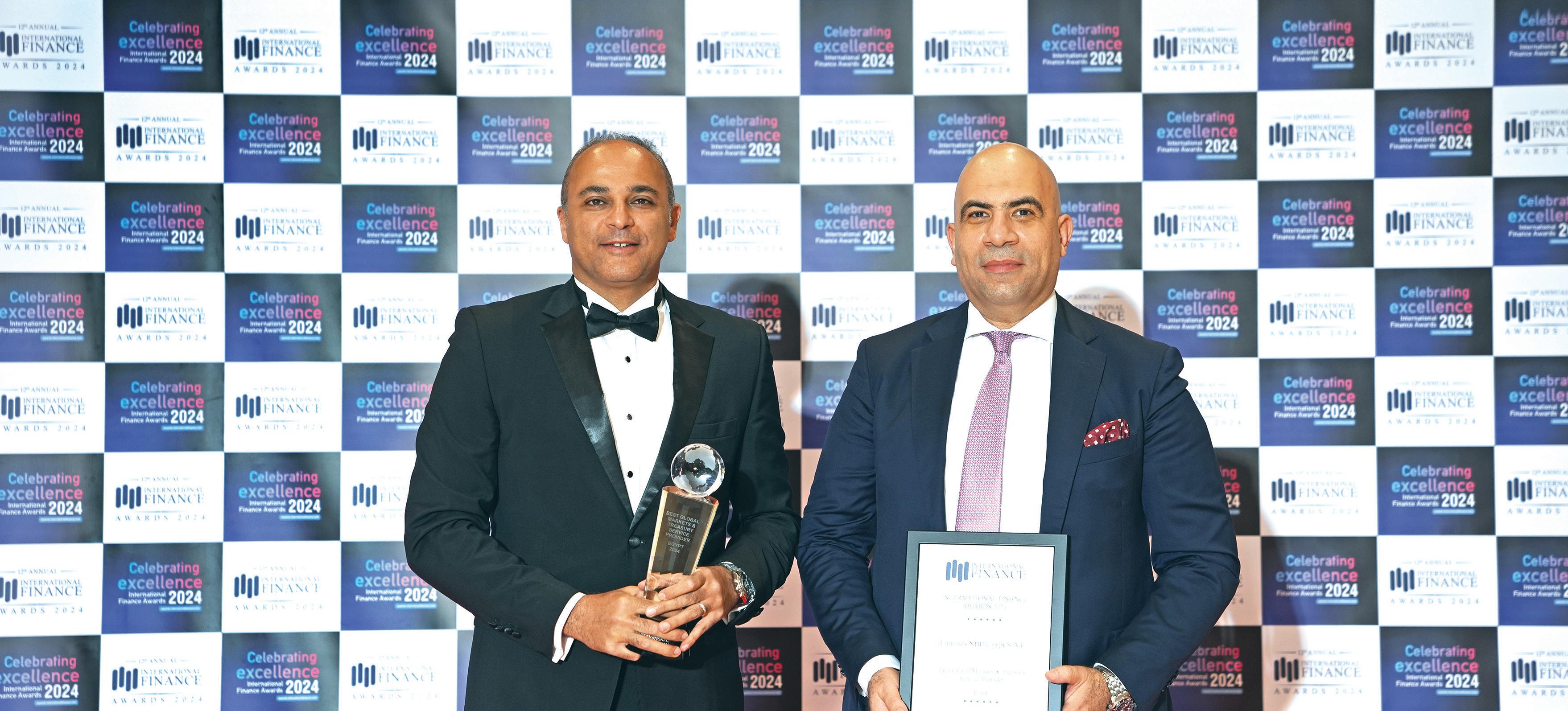
These strategies are tailored to each customer’s specific risk profile and business objectives, ensuring a customised approach to mitigate market fluctuations. By safeguarding their financial positions while strategically seizing opportunities within dynamic markets, the bank empowers its clients to thrive.
Emirates NBD Egypt also offers an extensive suite of products to maximise customers’ surplus liquidity and returns. Whether customers opt for classic time deposits, Treasury Bills, Treasury Bonds, or Eurobonds, the bank provides diverse and flexible solutions, ensuring customers have the tools they need to design financial plans that align with their unique needs.
At the heart of Emirates NBD Egypt’s operations lies its unwavering commitment to a customer-centric philosophy. The Global Markets and Treasury Sales team, headed by Ahmad Okasha, plays a central role in bringing this vision to life by conducting proactive, tailored daily calls with clients to share market updates, understand their evolving needs and requirements, and propose solutions that streamline workflows. This consistent engagement not only informs clients about market
trends but also fosters trust and positions the bank as a reliable financial advisor. By prioritising proactive communication, Emirates NBD Egypt ensures it remains an integral part of its clients' daily financial activities, nurturing long-term, mutually beneficial relationships.
The bank's stellar performance in 2024 underscores its ability to drive results in a challenging market. With a record-breaking 192% increase in net trading income compared to 2023, Emirates NBD Egypt showcases its adaptability to market dynamics, strategic insight, and focus on delivering value to its shareholders.
Mahmoud Bahaaeldin, Head of Global Markets & Treasury at Emirates NBD Egypt, expressed his pride in the bank’s achievements, saying, "Being named 'Best Global Markets & Treasury Service Provider' is a testament to our forward-thinking approach and deep commitment to serving our customers’ needs. This accolade highlights our strong market presence and outstanding growth in our net trading income this year, reflecting our dedication to delivering value-driven, customercentric financial solutions. At Emirates NBD Egypt, we strive to set benchmarks in innovation and
excellence, reinforcing our role as a trusted partner in the financial landscape."
Since entering the Egyptian market in 2013, Emirates NBD Egypt has reinforced its position as a trusted partner, leveraging its regional strength and local expertise. The bank achieved a remarkable 64% growth in net profits, reaching EGP 5.3 billion in 2024, compared to EGP 3.2 billion in 2023. With over 2,300 employees and a nationwide presence of 66 branches and 335 ATMs, Emirates NBD Egypt is well-positioned for sustained growth and innovation. The bank's adoption of advanced technology and commitment to sustainable practices further cement its leadership in the financial sector.
As the financial sector continues to evolve, Emirates NBD Egypt remains dedicated to delivering innovative and impactful solutions with a lasting impact. The bank aims to strengthen its market position further by introducing trailblazing products and expanding its service offerings. By focusing on sustainability, technological advancement, and customer engagement, Emirates NBD Egypt is set to drive meaningful progress and uphold its leadership for years to come.
As Tunisia nears a repayment milestone of several years, the debt service burden will only escalate
Failure to implement swift reform will lead to the collapse of Tunisia, the birthplace of the Arab Spring. A financial disaster is already in the making. This concerning outcome stems from the course the nation has taken since President Kais Saied seized power in July 2021.
The populace, weary of a turbulent decade marked by a rise in domestic corruption and numerous external bailouts, has resonated with these two ideas. But Saied's strategy has also resulted in a surge in debt and a slowdown in growth, both of which are currently hurting the economy
Two key aspects of economic policy serve as the foundation for this trajectory. The first is a massive (and costly) fiscal push that has resulted in four consecutive years with historically high deficits, driving the national debt to unmanageable levels.
The second issue is the government's lack of support for economic activity, which is instilling fear in the productive sector and slowing down economic growth due to a deteriorating business climate and heightened macroeconomic risks.
Additionally, the mechanism that might trigger a financial storm is becoming more apparent. The government is being forced to borrow more money from banks, national bondholders, and the Central Bank to pay a larger portion of its deficit domestically as a result of the closure of external funding sources.
This is driving away private industry, slowing
economic expansion, raising inflation, worsening the quality of bank balance sheets, and increasing the possibility of a significant devaluation of the Tunisian dinar. All conditions are set for a financial crisis impacting the banking sector, currency exchange rates, and national debt.
Saied's populist appeal has been based on his public pledge to uphold two principles: staunchly opposing an International Monetary Fund (IMF) programme to prevent the hardships it would cause the populace due to austerity, and combating corruption by forcing the "corrupt business elite" to give up its allegedly ill-gotten wealth through a legal process that threatens to put business owners in jail if they refuse.
The populace, weary of a turbulent decade marked by a rise in domestic corruption and numerous external bailouts, has resonated with these two ideas. But Saied's strategy has also resulted in a surge in debt and a slowdown in growth, both of which are currently hurting the economy.
A financial blowout is a real possibility as a result of all this. Tunisia is on the verge of depleting its financial reserves. Until the elections, there is no assurance that the situation will stay under control. If a financial crisis breaks out, the nation might face a terrifying combination of state insolvency, economic collapse, severe social harm, and significant political difficulties due to the need to distribute substantial losses across the population.

A decrease in economic growth and a worsening of social conditions, including lower real earnings and higher unemployment, have already been brought about by the consequences of bad policy. Due to these results, the government has increased the size of subsidies, which further solidifies the unsustainable nature of public finances and adds to a large fiscal imbalance.
As a result, the nation must make tough decisions. A bold reform programme to increase economic growth, strong and resolute political leadership to maintain social cohesion, and, ideally, assistance from Tunisia's international allies are all necessary for a smooth landing.
The practice of growing budget deficits to keep the economy afloat has not stopped, despite the shift in the political landscape from democratisation to the return of authoritarianism. The power-sharing government that came to office during the 2011 revolt initially sought to increase fiscal expenditures.
In 2020, the pandemic marked a turning point in Tunisia's public finance management as the budget deficit soared to 9.4% of GDP. Saied's tenure in office, particularly following the July 2021 "political coup," has increased unsustainability, even though swift action
was required to reverse a trajectory that was headed toward financial collapse. In fact, the budget deficit has been about 8% of GDP for the last three years.
Saied alone is accountable for an economic strategy that has renounced all semblance of budgetary discipline since he gave himself complete authority. Even at the expense of losing almost all of Tunisia's conventional funding sources, he has chosen to split from the IMF and has turned to monetising a sizable portion of the fiscal deficit, which could hasten inflation.
This circumstance also raises concerns regarding Tunisia's public debt prospects, both in the short and medium terms. The future course of the public debt is still unclear at this point.
The most recent IMF prediction from April 2024 does not anticipate a return to strong growth.
In 2024 and 2025, the IMF projects GDP growth to be 1.8% and 1.9%, respectively. This increase is significantly less than the low growth of 2.7% in 2021–2023. Additionally, the IMF predicts that while fiscal expenditures as a percentage of GDP would decline, state income will continue to rise in 2024–2025.
This outlook is a moderately optimistic scenario since it would allow Tunisia to stabilise

its public debt at less than 80% of GDP by 2025 by gradually reducing its budget deficit.
Although the Tunisian Ministry of Finance envisions a similar scenario, it predicts a slower rate of increase in budget revenues in 2024–2026 (7.4%).
If it weren't for domestic political restrictions, mainly due to Saied's resistance to structural changes like reducing subsidies, turning to the IMF, and privatising public firms, both scenarios could be considered probable. The state finds it challenging to make significant changes, especially in the short term, as a result of these policies and the high rate of 11.2% growth in fiscal expenditures between 2021 and 2023.
The currency rate's behaviour is a key factor in determining future possibilities. The decline in foreign exchange reserves, the decline in public accounts, and the
government's refusal to reestablish communication with the IMF all weakened the Tunisian dinar's strength in 2023.
Since 2019, the prohibition on the dinar's floating has led to an estimated 40% increase in the real exchange rate. The increase is because of the combination of inflation from the eurozone and cumulative inflation since 2019, which has resulted in an overvaluation of the dinar in relation to the euro. This implies that a significant adjustment is likely to occur at some point, as was the case in Egypt recently after the 2024 devaluation.
If devaluation occurs in Tunisia, it would result in a steep decline in real wages, a spike in inflation, and a rise in the domestic cost of repaying external debt, all of which would present difficult adjustment issues. Furthermore, one would anticipate that balance
sheet implications would harm the financial sector in the event of devaluation.
First, the state's foreign exchange loans would skyrocket, raising the risk to its sovereignty. Second, because SOEs are exposed to both domestic and foreign debt, the number of non-performing loans (NPLs) to public-sector businesses would also increase. According to the most recent report on public enterprises, the primary public firms' debt has reached $7.2 billion (annexed to the budget legislation 2023). Tunisian banks provided $2.6 billion of this debt, with international banks providing the remaining amount.
Analysts are still baffled by the recent handling of foreign exchange reserves. The reserves have varied over the last three years, indicating that the Central Bank has profited from external deposits at different points. The

amount, time, or expense of these procedures, as well as the deadline for repayment, are not specified, though.
Foreign currency reserves have been depleted more recently due to the cessation of external financing; they have decreased from 150 days of imports in July 2021 to 125 days of imports during the first nine months of 2022 and 92 days during the same period in 2023.
Furthermore, there is much ambiguity about the number of usable reserves and net reserves at the Central Bank, even if the gross reserves officially stood at $7.4 billion in February 2024. As was evident when the Central Bank had to pay 850 million euros on a Eurobond that matured in February 2024, it must now rely increasingly on foreign exchange reserves to handle the increasing servicing of the external debt.
As Tunisia nears a repayment milestone of several years, the debt service burden will only escalate. In 2024 alone, it will consume nearly all tourist income and diaspora payments. In the end, the stability of the dinar is at risk due to limited access to foreign credits, which could cause it to decline significantly in the upcoming months. Since the end of 2022, the central bank has maintained its key rate at 8% to implement an accommodating monetary policy.
The real interest rate, however, is marginally negative. This is not helping domestic savings, which
GDP in current prices in Tunisia from 2015 to 2024 (In Billion US Dollars)
Source: Statista
have dropped to a historically low 8% of GDP due primarily to income losses. Short-term remittances could be pushed downward by the growing likelihood of a dinar devaluation, a step linked to low interest rates, as Tunisians living overseas either wait for a devaluation before sending money home or deal in an unofficial, parallel market. These actions might then trigger a run on reserves, which would eventually result in a steep devaluation and start a downward trend.
Allowing such an event to occur would put Tunisia in a financial crisis from which it would be impossible to recover. But, Lebanon's experience serves as an extreme example of what might happen if unfavourable expectations are not promptly addressed.
It will be very difficult to finance both domestic and external deficits in the coming days. There is a significant financial deficit because just $1.5 billion of the $5 billion needed for 2024 has been
raised externally. On the domestic front, the substantial planned borrowing will maintain inflation while also pushing out the private sector.
An increase in inflation could be the primary threat to the current financial system. In the end, inflation causes devaluation, which raises the cost of repaying the external debt. Increased foreign cash shortages would pose a greater threat to the system as a whole, increasing the likelihood of a run on reserves and, given their significant exposure to public debt, a run on banks as well.
Due to these circumstances, Tunisia is susceptible to even the smallest shock, whether it comes from within or beyond. Only in the very short run is the current state of affairs sustainable.
A significant investment drive would theoretically help Tunisia pay off its debt, but doing so would necessitate a significant shift in internal policies as well as a substantial package of assistance from foreign allies.
In 2025 and beyond, Tunisia will be increasingly likely to be forced to choose between two unpleasant options: restructuring its debt or pursuing austerity with IMF assistance.

IF CORRESPONDENT

Bulgaria has made progress in increasing labour force participation, particularly among women and older workers
Bulgaria, often regarded as one of the most isolated corners of Europe, is now attracting the interest of foreign investors and analysts alike. The country, with the smallest economy in the European Union (EU), may have gone unnoticed by some, but recent events point to a more vibrant and promising future.
Bulgaria is negotiating a path of recovery and fresh growth following the economic storms of the COVID-19 pandemic, inflationary pressures, and regional unrest. Once seen as a peripheral market, resilience and reinvention are turning into case studies here.

We investigate the fundamental strengths, major reforms, and external factors influencing Bulgaria's economic comeback, while also exploring its future potential as an emerging market in Europe and examining the obstacles it must overcome to maintain and accelerate its expansion.
Like many other European countries, Bulgaria suffered a major economic downturn during the COVID pandemic. Lockdowns halted domestic consumption and exports, with industries such as manufacturing, transportation, and tourism being particularly affected.
However, the country's recovery has been stronger than initially projected. Experts argue that despite external events, including the war in Ukraine, inflation, and oil price fluctuations, Bulgaria's GDP rose by 3.9% in 2022. This figure exceeded expectations, ranking Bulgaria among Eastern Europe's most resilient nations.
Government support initiatives, EU-funded investments, and private spending were key players in driving
the recovery. Improved employment and wage growth helped raise consumer confidence, which was vital. Along with the private sector's flexibility, public sector initiatives in economic stabilisation facilitated a quicker recovery than many of its counterparts.
Moreover, Bulgaria's relatively low public debt (less than 25% of GDP) enabled authorities to implement fiscal stimulus without the risk of financial instability. This prudent financial management continues to act as a shield against global economic risks.
Bulgaria has greatly benefited from improved access to capital, trade opportunities, and structural changes since joining the European Union in 2007. EU cohesion and structural funding have turned once underdeveloped industries around in areas such as infrastructure, education, digitalisation, renewable energy, and more. Despite ongoing governance flaws, the country's adherence to EU norms has also driven institutional modernisation.
Bulgaria is expected to receive over €29 billion in EU funds over the next decade, including recovery and resilience
facility funding. These funds are earmarked for judicial reforms, digital transformation, rail modernisation, and energy diversification.
With nearly two-thirds of its total trade coming from the EU, it remains the country’s largest commercial partner. Additionally, EU membership helps anchor macroeconomic stability and attracts investors who view institutional oversight and regulatory coherence as key risk-reducing factors.
Although challenges persist, particularly regarding corruption and judicial independence, EU membership has spurred regulatory convergence and improvements in governance. In general, Bulgaria's economy has benefited from EU membership, making the EU an essential ally in the country's continued development.
Bulgaria's reliance on Russian gas was underscored by the war in Ukraine and the subsequent energy crisis. However, the crisis also accelerated the nation’s shift toward self-sufficiency and energy diversification. By using LNG imports
and the Trans-Adriatic Pipeline, Bulgaria has aggressively worked to ensure alternate natural gas sources through interconnectors with Greece and Turkey. These efforts help Bulgaria become a regional energy transit hub.
The Bulgarian government is also funding hydroelectric, solar, and wind energy sources. The national recovery plan, backed by the country, focuses heavily on energy transformation. Bulgaria aims to increase its renewable energy share, reduce greenhouse gas emissions, and ensure energy security by strengthening more resilient infrastructure in the coming years. The business sector also plays a role, as tech companies and green energy investors show growing interest.
Scheduled initiatives include environmental preservation, grid upgrades, and energy efficiency programmes. In addition to the environmental benefits, these programmes offer economic advantages, such as green jobs, improved public health, and lower long-term energy costs. The successful execution of Bulgaria's energy revolution could inspire other Eastern European nations.
Despite its economic development, Bulgaria continues to struggle with corruption and weak rule of law. These issues have long discouraged foreign investment and eroded public trust in institutions.
Bulgaria frequently ranks among the lowest performers in the EU in Transparency International's Corruption Perceptions Index. Allegations of nepotism, lack of judicial independence, and questionable public procurement practices have plagued successive governments.
However, recent political developments provide cautious optimism. Under a reform-oriented coalition, a
new government, which took office in 2023, has promised to tackle corruption and improve transparency. Key items on the national agenda include judicial reform, digitisation of public services, and better accountability systems. Stronger enforcement of anti-corruption laws, greater autonomy for prosecutors, and increased transparency in political financing have been promised by the administration.
While political will and EU pressure suggest that change is possible, the success of these reforms remains uncertain. Holding authorities accountable is partly the work of civil society organisations, investigative journalists, and international watchdogs, signalling the development of a democratic society that could support long-term institutional transformation.
Bulgaria presents an appealing environment for foreign businesses. It has one of the lowest business tax rates in the EU (10%), a strategic location linking Europe and Asia, and a well-educated, bilingual workforce. Additionally, relatively low labour costs make it competitive for manufacturing and IT services. Investors inside and outside the EU continue to show interest in these structural advantages.
Particularly in fields like software development, customer service, and fintech, the country has become a hub for outsourcing. Supported by EU funds, private capital, and a growing entrepreneurial ecosystem, tech firms and innovation centres have flourished in cities like Sofia, Plovdiv, and Varna. A new generation of business leaders is transforming Bulgaria's economic landscape, especially in digital services, renewable technology, and health innovation.
Geopolitical concerns notwithstanding, foreign direct investment (FDI) flows have remained strong.
Key players come from Germany, Austria, the Netherlands, and the US. Interest in industrial parks and logistics infrastructure is growing, with major multinational companies establishing regional hubs in Bulgaria. The government is working to simplify administrative processes, enhance judicial reliability, and upgrade transportation and digital infrastructure to attract more FDI.
Bulgaria maintains a currency board system that pegs its currency to the euro. This system has brought stability and helped control inflation. During periods of external turbulence, such as the 2008 financial crisis and the current pandemic, the lev-euro peg has also boosted investor confidence.
With a projected admission date as early as 2025, Bulgaria is on track to join the Eurozone. Adopting the euro could reduce transaction costs, bolster investor confidence, and ensure macroeconomic stability.
Reduced currency risk, easier accounting, and deeper integration into the European single market would benefit businesses.
However, meeting the convergence criteria still presents challenges, particularly regarding institutional reform, public sector transparency, and inflation control.
Bulgaria's financial industry is strong and well-capitalised. Stress tests conducted by the European Central Bank show that Bulgarian banks are profitable and maintain strong capital buffers.
The adoption of fintech is rising, and digital banking is becoming increasingly important. The banking sector's performance has been a cornerstone of Bulgaria's overall economic resilience and provides a foundation for future economic diversification.
Declining population is one of Bulgaria's long-term challenges. Driven by low birth rates, ageing, and emigration, the European country has one of the fastest-shrinking populations on the continent. This trend could strain public pension systems, reduce the labour supply, and slow economic growth.
Brain drain remains a significant issue, as many talented professionals seek better opportunities abroad.
To mitigate these effects, Bulgaria needs focused policies to attract skilled workers, retain domestic talent, and boost productivity. Preparing the workforce for the demands of a modern economy relies heavily on investments in education, vocational training, and digital skills. Government incentives, such as subsidies, tax breaks, and fast-track recognition of foreign credentials, aim to encourage the repatriation of Bulgarian expatriates.
Bulgaria has made progress in increasing labour force participation, particularly among women and older workers. Policies supporting remote work, flexible schedules, and childcare are beginning to gain traction.
In recent years, wage growth has outpaced inflation, thereby boosting disposable income and domestic demand.
Effectively managing demographic decline will ensure that Bulgaria's labour market remains a key driver of sustainable development.
Bulgaria has long relied on tourism, which plays a significant role in GDP and job creation. Millions of tourists visit the Black Sea beaches, ski resorts, and cultural landmarks each year. The pandemic severely impacted the sector, but focused marketing, infrastructure
Source: Statista
improvements, and favourable exchange rates have led to a strong recovery.
Visitor arrivals and revenue rebounded in 2023, nearly returning to pre-pandemic levels. To position Bulgaria as a year-round travel destination, the government is funding sustainability, digital marketing, and tourism infrastructure projects. Efforts are underway to promote cultural events, eco-tourism, and rural travel, which distinguish Bulgaria from other European countries.
Beyond tourism, the services sector, including IT, banking, healthcare, education, and logistics, is growing rapidly. This diversification reduces reliance on traditional sectors like heavy manufacturing and agriculture, making Bulgaria’s economy more forward-looking and resilient.
Although Bulgaria has historically had low R&D spending, investments in research are gradually increasing. At around 0.8% of GDP, R&D spending is below the EU average of almost 2.3%. In an effort to enhance the nation's innovation potential, the government aims to raise R&D expenditure to 1.5%
of GDP by 2030.
Public-private partnerships are gaining momentum in sectors such as biotechnology, robotics, and artificial intelligence (AI). Universities and technical colleges are being encouraged to engage in applied research.
The Bulgarian Academy of Sciences and Sofia Tech Park are major contributors to the innovation ecosystem. Although Bulgaria currently lags behind regional peers like Slovenia and the Czech Republic, patent filings and scientific output have shown slight improvement. Supporting innovative ecosystems remains a top priority.
Textiles, machinery, agricultural goods, and metals have traditionally dominated Bulgaria's export portfolio. However, the nation is aggressively transitioning to higher-value industries. The share of exports now includes processed food, car parts, and pharmaceuticals. Notably, ICT services and software exports have surged, reflecting Bulgaria's growing role as a tech outsourcing destination.
Germany, Italy, Romania, and Turkey are Bulgaria's principal export partners. The country is also working to diversify its markets outside the EU, particularly in Asia and the Middle East. Bulgaria’s strategic location and investments in logistics bolster its ambitions to become a regional trade and transportation hub.
Geopolitically, Bulgaria occupies a strategic but delicate position on the Black Sea. While actively supporting NATO and Eastern Partnership programmes, it carefully navigates its relations with neighbouring countries such as Turkey, Greece, and Romania. Bulgaria demonstrates its commitment to regional stability by supporting Ukraine and


engaging in energy cooperation with Greece and Turkey. The country also plays a key role in promoting regional security and economic development through diplomatic initiatives and crossborder collaborations.
Bulgaria is increasing its defence spending, aiming to meet the NATO target of 2% of GDP. The defence sector, including maintenance and armaments manufacturing, is attracting new investments. Bulgaria’s dual alignment with NATO and the EU continues to shape its regional influence, reinforcing its role as a security pillar in Southeastern Europe.
Bulgaria is progressing towards digital statehood. Simplified e-governance services, including digital ID verification, online tax filing, and electronic health records, are reducing bureaucracy. Digital literacy initiatives are being launched to improve engagement across various demographics.
With internet penetration surpassing 75% and growing mobile broadband usage, Sofia is emerging as a startup hotspot, attracting venture capital and EU-backed grants.
Artificial intelligence usage in banking and logistics is expanding, and blockchain applications for public procurement and property registries are gaining traction. The national development strategy now places a FEATURE
However, risks remain, particularly from regional geopolitical tensions, global economic slowdowns, and climaterelated shocks. Bulgaria’s future path may be influenced by shifts in EU policy, the evolving dynamics of the RussiaUkraine conflict, and changes in global demand. Political instability and reform fatigue could also slow progress.
strong emphasis on the digital economy.
The transition to greener energy sources does not come without its challenges. Particularly around the Maritsa Basin, Bulgaria’s coal-dependent regions are undergoing significant social changes. The planned phasing out of coal plants raises concerns about job losses and community disruption.
The government has proposed "Just Transition" plans, supported by EU Green Deal funding, to help mitigate these effects. These plans include retraining programmes, incentives for renewable energy startups, and support for local SMEs.
While public consultations are ongoing, some local resistance remains, particularly when alternative solutions are unclear. The success of the green transition relies on infrastructure and equitable benefit distribution.
Looking ahead, Bulgaria's economic outlook is cautiously optimistic. Key opportunities lie in renewable energy, digital transformation, Eurozone integration, and deeper EU cohesion. If the nation can effectively address corruption, strengthen the rule of law, and improve governance, it could unlock even more potential and set an example for other small and mid-sized nations.
Nonetheless, Bulgaria's foundations are strengthening. With smart fiscal management, strategic investments, and a growing innovation ecosystem, the country is poised to become a rising market leader in Southeastern Europe. Bulgaria offers a challenge and an opportunity for investors, businesses, and policymakers, presenting a frontier that rewards vision, perseverance, and longterm commitment.
Ultimately, Bulgaria's recovery symbolises a broader movement toward resilience, creativity, and sustainable development, rather than just a statistical rebound. Bulgaria is now an emerging power deserving of attention from both lawmakers and investors, not merely a secondary player in Europe’s narrative.
Through strategic reforms, EU support, energy diversification, and a growing digital and service economy, Bulgaria is steadily positioning itself as a rising leader in Southeastern Europe.
However, challenges remain, particularly in combating corruption, strengthening the rule of law, and addressing demographic decline. By staying committed to its reform agenda, investing in innovation, and continuing to attract foreign investment, Bulgaria has the opportunity to unlock significant growth and become a regional powerhouse.
At the core of iscore is its Market Analytics Data platform, which offers a set of features that make it the most professional platform for analysing credit portfolios and making accurate, quick decisions

Mohamed Korayem CEO
The Egyptian Credit Bureau was established in 2005 as an Egyptian joint-stock company with the contribution of 25 banks and the Micro, Small, and Medium Enterprises Development Agency under the name “iscore” (the company’s first commercial name). The company, which began its activities in 2008, now offers a wide array of products and services with an innovative value proposition that helps organisations effectively address current dynamic financial challenges. With the goal of providing credit information services and value-added products, iscore empowers organisations with advanced solutions that offer actionable insights and improve workflows, enabling smarter, data-driven strategies for growth and success through its product and service families.

"iscore" remains the only company licensed in Egypt as a credit bureau. At the core of "iscore" is its "Market Analytics Data" platform, which offers a set of features that make it the most professional platform for analysing credit portfolios and making accurate, quick decisions. Key features include monitoring and analysing the performance of credit

products, the number of customers who obtain them, and the limits granted.
"iscore" offers "idecide," a portfolio of solutions specifically tailored to support advanced credit assessments that lead to more accurate, swift, and wellinformed lending decisions. This includes implementing fast and precise decision-making.
The SME credit rating system further enables banks to obtain an assessment using the best internationally recognised criteria.
"iscore" has ensured that the design of its “Analytical Market Data” platform is distinctive and user-friendly through a web application. The platform displays charts and comparisons that
provide subscribers with a comprehensive view of the entire market across the Egyptian Credit Bureau database. It has been developed to function as an easy-to-use analytical dashboard, providing regular users with all the necessary tools to generate analytical reports as needed. This positively impacts business growth, reduces risks, and helps organisations achieve their goals more efficiently and effectively.
Next is "ialert," a set of specialised products and services that provide early alerts to financial institutions (in terms of customer account tracking), enhancing their awareness levels. This suite
also helps clients apply the required procedures and take necessary actions.
"ianalyze" is a suite of specialised products and services designed for detailed and accurate data analysis, enabling financial institutions to gain a comprehensive view of their credit portfolios and provide correct, actionable insights to achieve business growth.
Next is "iverify," a suite of products and services designed to assist organisations in verifying the data they present by using trusted, official sources. Lastly, "iease" streamlines the processes of financial organisations, enabling them to provide faster and exceptional services.
China’s control over rare earths is a frontline asset in a prolonged trade and tech war

IF CORRESPONDENT
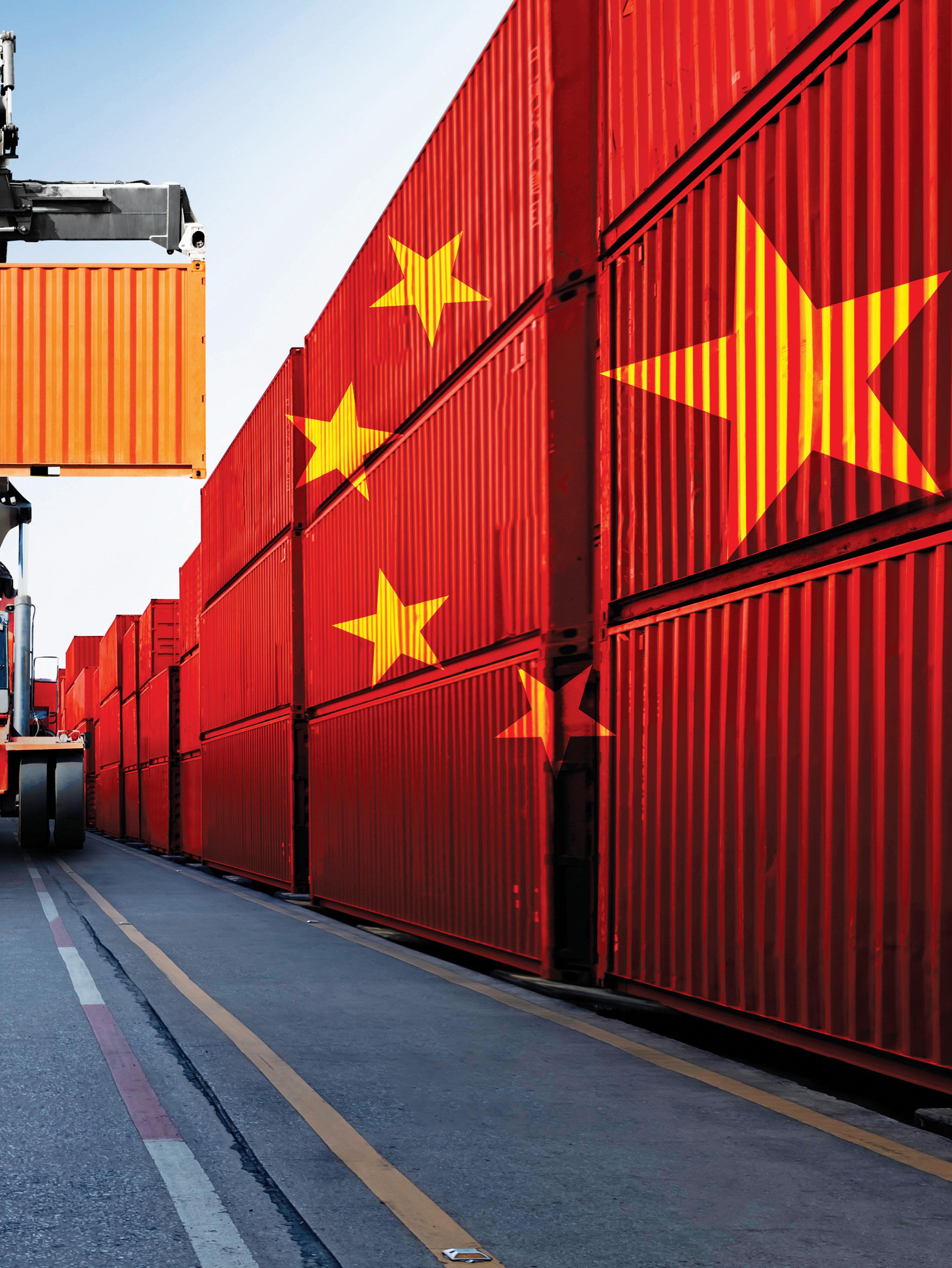
In the relentless tug-of-war between the world’s two biggest economies, China is once again reaching into its geopolitical arsenal and pulling out a weapon that has long sat quietly in reserve: its near-monopoly over rare earth minerals.
As the Donald Trump administration’s aggressive trade tariffs on Chinese goods reach historic levels, most notably a 104% tariff, Beijing is striking back by weaponising a segment of the global supply chain that it controls like no other. This isn’t just about retaliatory theatrics. Beijing is increasing export restrictions on seven varieties of rare earth minerals, a class of seventeen elements essential for the operation of our contemporary high-tech economy.
From stealth bombers to cellphones, this action has significant consequences that could undermine worldwide manufacturing sectors strongly dependent on these inputs, thus threatening stability.

Almost 70% of the rare earth minerals produced worldwide come from China. High-tech manufacturing depends on these 17 factors. China also dominates the refining and processing stages, exerting almost total control over the world market.
Other nations, including the United States and Europe, have not invested enough in building alternative supply chains or processing facilities. Rare earth elements (REEs) may not be household names, but they are foundational to everything from iPhones to electric vehicles to advanced missile systems. The nation has used this pressure before, notably in 2010 during a territorial dispute with Japan, but the scope and timing of the current export restrictions reflect a notable increase.
No other country approaches China’s supremacy in this area. The complicated rare earth supply chain requires not only extraction but also high-level processing and refining, areas where China maintains near-total control. Western nations, including the United States and European Union (EU) member states, have long understood this vulnerability, but little has been done to mitigate it. Now, that weakness is being exploited.
Importantly, this is not Beijing’s response to Biden-era semiconductor controls. The new export restrictions are a direct reaction to the Trump administration's 104% tariffs on Chinese electric vehicles and related products. This move marks the first time that Beijing is officially implementing such sweeping restrictions under the Trump regime.
During the Joe Biden era, China did not impose such rare earth export controls. The timing signals a sharp escalation in trade retaliation.
backbone of high-tech manufacturing
Rare earths are indispensable in the manufacture of electric vehicle motors, especially those using neodymium, praseodymium, and dysprosium. They are also used in wind turbines, which rely on rare earth magnets. Consumer electronics such as smartphones, tablets, and TVs incorporate these elements.
Military hardware, including guided missiles, fighter jets, and satellite systems, depends heavily on them. The same is true for medical technology like MRI machines and advanced imaging equipment, as well as emerging fields like quantum computing and AI, which require specialised magnets and sensors.
Simply put, rare earth minerals are crucial to the future and are essential to the present. Without them, entire industries grind to a halt.
The Biden administration banned sales of advanced semiconductors and chipmaking equipment to China to slow Beijing’s AI and military development. China responded by accelerating domestic chip development, with firms like SMIC taking the lead. In contrast, the US and Europe are still heavily dependent on China for rare earths.
China's export control hit US manufacturing more directly than Biden’s chip ban hit Chinese tech. While China managed to continue its tech advancements despite the semiconductor restrictions, the West does not have a clear or immediate substitute for the rare earth supply.
Rare earths are also mined in Australia, the United States (notably in Mountain Pass, California), Canada, Myanmar, Vietnam, India, and Brazil. However, none of these sources can match China’s capacity or cost-efficiency.
Many of these projects are still in exploration or early development stages. Refining and processing infrastructure is even more limited outside China. The US has rare earth deposits but lacks domestic refining capacity.
Efforts to revive domestic production are slow due to environmental, regulatory, and cost barriers. The Pentagon has funded some rare earth initiatives, but they’re years away from meeting industrial-scale demand. Europe, meanwhile, has barely started its journey.
Adding environmental concerns and local resistance to mining projects clarifies why the West struggles to increase domestic production despite recognising the strategic risks.
Beijing's move to forbid rare earth exports will probably cause world rare earth material prices to rise sharply. Along with disturbances in defence and space projects, it will cause manufacturing delays in high-tech industries.
In expectation of long-term shortages, countries could start hoarding goods. Attempts to diversify supply chains will quicken, and outside of China, new investments in rare earth exploration and processing will most certainly explode.
Rising production costs and manufacturing delays will affect economies around the globe. For the United States, this action greatly worries Washington. Military contracts, manufacturing of electric cars (a Biden focus), and even consumer electronics could experience delays and cost overruns.
Germany, for example, mostly depends on imported rare earths for its automotive industry. Nations like France and the United Kingdom, pursuing dramatic green energy transitions, will also feel the pressure.
Europe is as dependent as the US on China for rare earths. The German
automotive industry will be hit particularly hard. The continent's goals for green energy, including wind energy, electric vehicles, and solar infrastructure, rely on a stable supply of rare earth materials.
While the EU has announced plans for rare earth independence, those plans are still years behind. Europe faces tough choices: align more closely with the US trade strategy or negotiate independently with China to preserve access.
European tech firms, automakers, and clean energy projects depend on a stable supply of REEs. With Beijing tightening the screws, the EU might have to choose between aligning more closely with the US trade stance or finding a middle ground to preserve access. In either case, Europe is set to suffer.
Rare earth elements have been strategic commodities long before the smartphone era. During the Cold War and the space race, they were used in radar systems, missile guidance, and nuclear submarines.
These elements were also vital in the development of stealth technologies and nuclear-powered aircraft carriers. In the 1980s, the United States led the world in rare earth mining, with Mountain Pass in California serving as a global hub for extraction and initial processing. At that time, the US was not only producing the majority of the global supply but also setting the technological standards for its use in defence and aerospace.
However, the combination of rising environmental concerns, public opposition to hazardous waste, and increased compliance costs with domestic regulations made domestic mining unsustainable. This opened the door for China, which strategically scaled up its production, offering rare earths at
Reserves of rare earths worldwide as of 2024, by

Source: US Geological Survey
prices Western producers could not match.
Beijing also acquired key processing technologies and expertise, allowing it to dominate the full value chain from raw material to finished components. As a result, production rapidly shifted overseas. China stepped in, capitalising on low labour costs and lax environmental standards.
In the 1980s, the US led the world in rare earth mining. However, lax environmental laws and cheap labour in China allowed Beijing to undercut prices, leading to the decline of US operations and the rise of Chinese dominance, a strategic mistake now haunting Washington.
This shift was not just an economic adjustment; it marked the beginning of a new geopolitical dynamic where China began to treat rare earths as instruments of power projection.
Rare earth extraction is often dirty, dangerous, and linked to pollution and displacement. The toxic waste
lakes of Baotou, China, highlight the environmental toll. These ponds are filled with a black, radioactive sludge that can take centuries to degrade.
Mining operations in southern China have also led to deforestation and the destruction of arable land. Local communities suffer from high cancer rates, contaminated groundwater, and reduced agricultural productivity.
In places like Myanmar and the Congo, associated mining operations for rare earths and critical minerals have led to deforestation, water contamination, and human rights abuses. There are growing concerns about child labour, unregulated artisanal mines, and violent territorial disputes funded by mineral wealth.
Rare earth extraction is often dirty, dangerous, and linked to pollution and displacement. Western nations, committed to high environmental standards, have long baulked at domestic production, giving China, with more permissive laws, the upper hand. Ethical sourcing has become a major concern for Western governments and consumers, leading to discussions about certifying "clean rare earths" and imposing new import standards.
Japan has led the charge in urban mining, investing in the recovery of REEs from used electronics and industrial waste. It has developed robotic systems that can dismantle smartphones and extract trace amounts of neodymium and dysprosium from discarded magnets.
Europe and the US are exploring similar initiatives. Researchers are experimenting with biometallurgy, using bacteria to extract metals from scrap. Though not a replacement for mining, recycling could provide critical backup and help close the loop on tech waste.
A mature recycling ecosystem could eventually meet up to 20% of global

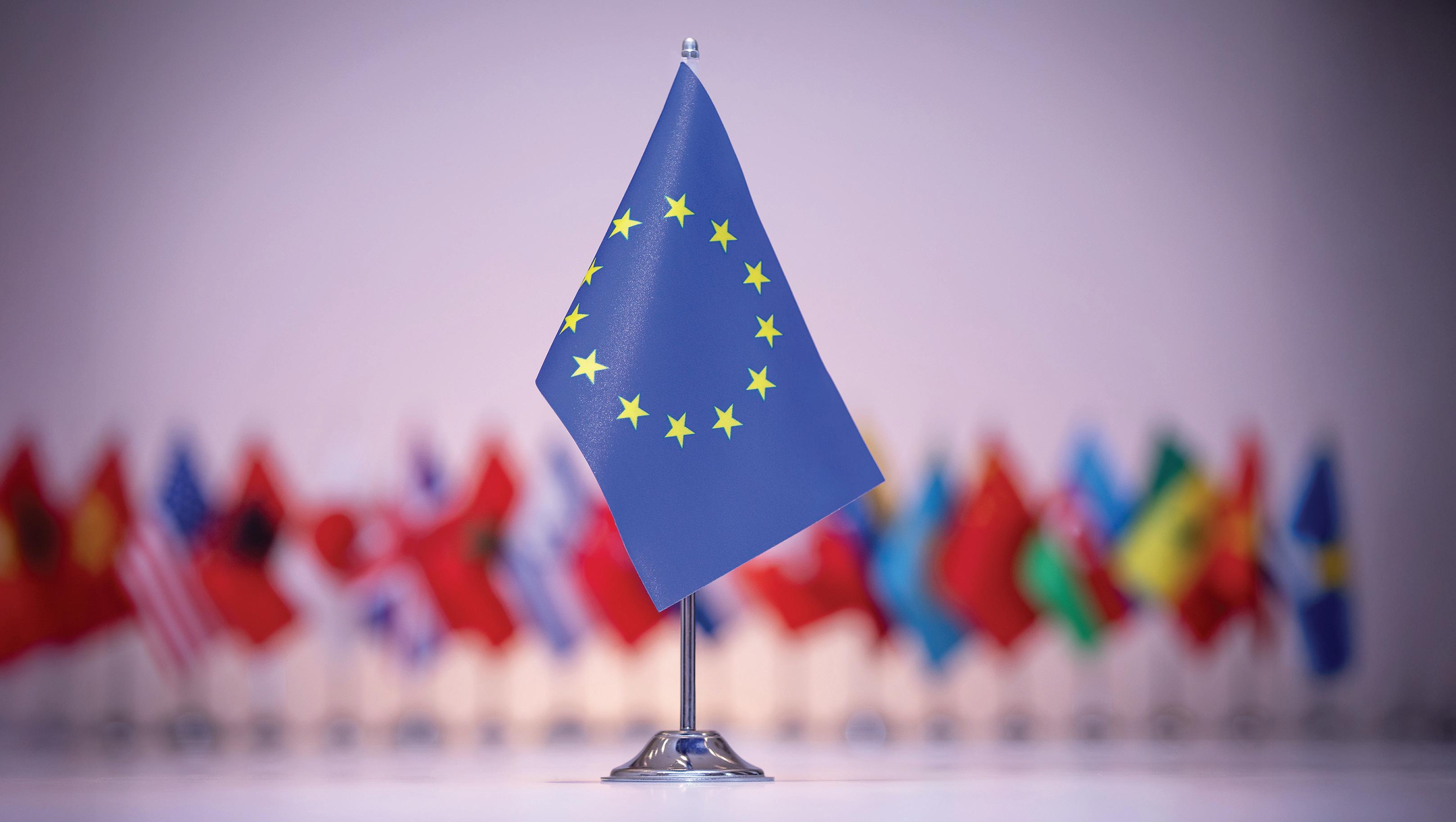
REE demand. Policymakers are now discussing the establishment of e-waste hubs and circular supply chain zones to support this goal.
The ripple effects of a rare earth squeeze are global. Countries in Africa, Southeast Asia, and Latin America, where electrification and clean energy adoption are priorities, could face rising costs and project delays.
If prices surge, so do the costs of solar panels, batteries, and electronics, stalling developmental goals and exacerbating technological inequality. Nations like Kenya, Bangladesh, and Brazil, which are pushing for green infrastructure, may find themselves locked out of critical technologies.
For example, electric public transport systems, solar grid rollouts, and affordable smart devices may suddenly become financially unviable.
Moreover, as wealthy nations rush to secure alternative sources, they risk crowding out smaller economies, driving a wedge between the Global North and South.
While the European Union has proposed the Critical Raw Materials Act, the US has enacted the CHIPS and Science Act and the Inflation Reduction Act. These programmes seek to encourage processing technologies, subsidise domestic mining, and create strategic connections. The CHIPS Act provides subsidies for domestic businesses focusing on sustainable extraction techniques and billions in investment for rare earth research and development (R&D).
The EU has also allocated funds for strategic stockpiling and circular economy initiatives. Talks of a "rare earth alliance" with Australia, Canada, and other like-minded countries suggest a coordinated response to China's dominance.
With this global approach, the goal is to create a safe, diversified, and ecologically conscious rare earth supply chain that is resistant to geopolitical shocks. These discussions also involve nations like Japan and South Korea, which recognise the shared vulnerability among allies.
Big companies are making changes. Apple is increasingly focused on recycling rare earths. From speakers to Taptic Engines to MagSafe assembly, its newest products feature 100% recycled rare earths in components. While researching motor technology that reduces reliance on rare earth resources, Tesla has pursued contracts with Lynas and other non-Chinese suppliers.
Through federal procurement rules, defence corporations such as Lockheed Martin and Raytheon are advocating for REE supply security. Contingency planning is no longer optional across sectors; it has become strategic. Businesses are mapping out several levels of suppliers, funding replacement R&D, and pushing governments for tax breaks tied to mineral independence.
China’s rare earth policy aligns with its "dual circulation" strategy, which emphasises domestic resilience over export dependence. This strategy aims to create self-sufficiency in critical technologies while maintaining export dominance in low- to mid-tech manu-

facturing. By restricting rare earth exports, Beijing pressures rivals and strengthens its internal capabilities, ensuring that key sectors such as AI and energy remain insulated.
The central government has also linked rare earth planning with its "Made in China 2025" initiative, which seeks to dominate high-tech fields. In essence, rare earths have become both a shield and a spear in China's economic doctrine. While effective in the short term, China’s restrictions may backfire. Many of its tech giants depend on global supply chains. Companies like Huawei, Lenovo, and CATL rely on Western-designed components and foreign markets for growth. If the West accelerates diversification and
decoupling, Chinese firms may lose access to advanced tools, foreign investment, or international markets.
There is also a risk of retaliatory measures. Countries could impose tariffs, sanctions, or restrictions on other Chinese exports, such as lithium batteries or solar panels. The rare earth weapon, which was once used, may galvanise rivals into building a more resilient and self-sufficient global order that ultimately leaves China more isolated.
As tensions rise, we may witness a rare earth arms race or the emergence of a NATO-style alliance for critical minerals. Countries could nationalise resources, hoard supplies, and forge exclusive trade blocs. Global institutions like the IMF and World Bank might be pressured to
treat mineral security as part of economic development policy.
Private investors could shift capital from fossil fuels to mining projects, creating a new boom and potentially a new bust.
What we are witnessing is not a temporary reaction. China’s control over rare earths is a frontline asset in a prolonged trade and tech war. With Trump imposing steep tariffs and Beijing responding with surgical strikes on supply chains, the world is hurtling into a new era of economic warfare where commodities, not just capital, are the weapons of choice.
The world is entering a new era where
the control of strategic resources, not just financial capital or trade tariffs, will define geopolitical dominance. China's tightening grip on rare earth minerals is not merely a retaliatory gesture in response to US tariffs, but is also a longterm recalibration of power, influence, and economic leverage.
With its export controls, Beijing has sent a loud, unmistakable message: it will use every asset at its disposal to defend its interests and shape the global order.
Rare earth elements are no longer obscure components tucked away in the background of our gadgets and machines. They are central to modern civilisation, embedded in every facet of high-tech manufacturing, green energy innovation, defence infrastructure, and emerging technologies like AI and
quantum computing.
China’s near-monopoly over these elements means that the world’s dependence is not only economic but deeply systemic. If rare earths are disrupted, entire industries could come to a halt.
The global response to China's rare earth export controls will define the trajectory of international relations and industrial strategy for years to come. Countries like the US, Japan, Germany, and others will have no choice but to accelerate their investments in alternative mining, processing, and recycling infrastructure.
This shift will demand capital, as well as political will, regulatory reform, and public support, especially in democracies where environmental concerns and community resistance have historically

delayed mining projects.
China’s move could also reshape the alliances of the 21st century. Just as oil shaped the geopolitical contours of the 20th century, rare earths could drive the formation of new trade blocs, technological pacts, and even defence agreements.
We may witness the birth of a global rare earth alliance, with nations banding together to secure critical mineral supply chains. This could lead to a bifurcated global system, where countries are forced to choose sides based on resource access and technological sovereignty.
At the same time, the West must confront its past failures. For too long, it ceded the rare earth sector to China in the name of cost savings and environmental convenience. That strategic complacency has now become a liability. Rebuilding rare earth capacity will not be easy or cheap, but it is no longer optional.
Meanwhile, developing nations face the danger of being sidelined or exploited as the mineral race intensifies. Rising costs and resource hoarding could derail sustainable development goals and widen the tech divide between rich and poor nations. Ethical sourcing, environmental safeguards, and fair-trade principles must be part of the new rare earth order.
Ultimately, the rare earth confrontation is not just a skirmish in the broader US-China rivalry. It serves as a wake-up call. In this new era of strategic commodities warfare, dominance will belong to those who secure today's supply chains and the innovation ecosystems of tomorrow. The global balance of power may well hinge on who controls the dirt beneath our feet and how responsibly they wield it. FEATURE RARE EARTHS

Chancellor Rachel Reeves has refused to rule out future tax rises after the British economy suffered its worst contraction in a year and a half in April 2025. The economy unexpectedly shrank by 0.3% after taxes increased for businesses, household bills rose, and exports to the United States plunged.
Although Reeves set out spending plans aimed at boosting growth, with funding increases for the NHS and defence, budgets were squeezed elsewhere. Analysts say that a failure to increase the European major's growth would "almost certainly" lead to more tax rises for the Keir Starmer government to balance its spending commitments.
Reeves acknowledged that the latest economic figures were "clearly disappointing" and refused to rule out tax rises when she next lays out her plans for the economy in the autumn Budget.
Paul Johnson, director of the Institute for Fiscal Studies (IFS), an influential think tank, said, "With spending plans set... any move in the wrong direction will almost certainly spark more tax rises."
Agreeing with Johnson, Ruth Curtice, chief executive of the Resolution
Foundation, said, "A weaker economic outlook and the unfunded changes to winter fuel payments mean the chancellor will likely need to look again at tax rises in the autumn."
Reeves has prioritised investing billions in long-term projects to boost economic growth and improve living standards. However, many of her plans, such as new railway lines and the development of the nuclear power plant Sizewell C, will take years, with budgets being squeezed.
Opposition parties said the chancellor's previous decision to raise employers' National Insurance contributions, which took effect in April 2025, was dragging on growth. The Starmer government is also paying more to borrow money. Lindsay James, investment strategist at British multinational wealth management company Quilter, said this was due to investors being unsure about the government's spending plans, demanding a higher return.
The Office for National Statistics said a poor month for the services sector, which includes businesses ranging from shops and restaurants to hairdressers and financial firms, was behind the
contraction in April. Legal firms and property companies also "fared badly", following a strong March in which many homebuyers rushed to complete purchases to avoid stamp duty increases that came in April.
Car manufacturing was also weak in April after the introduction of 25% tariffs on British vehicles exported to the United States. Automobiles have been the UK's biggest export to the US, with one in eight cars built in Britain shipped across the Atlantic. Trade data further showed the value of British exports decreased by some £2.7 billion in April, with goods to America alone falling by £2 billion, which marked the largest monthly fall on record in exports across the Atlantic.
Since April, the Starmer government has agreed to a deal on tariffs with the Donald Trump administration, in addition to making trade agreements with the European Union and India. Despite the tariff pact with the US, a 10% import tax still applies to most British goods entering America, with higher taxes for steel and cars until the deal comes into force.
